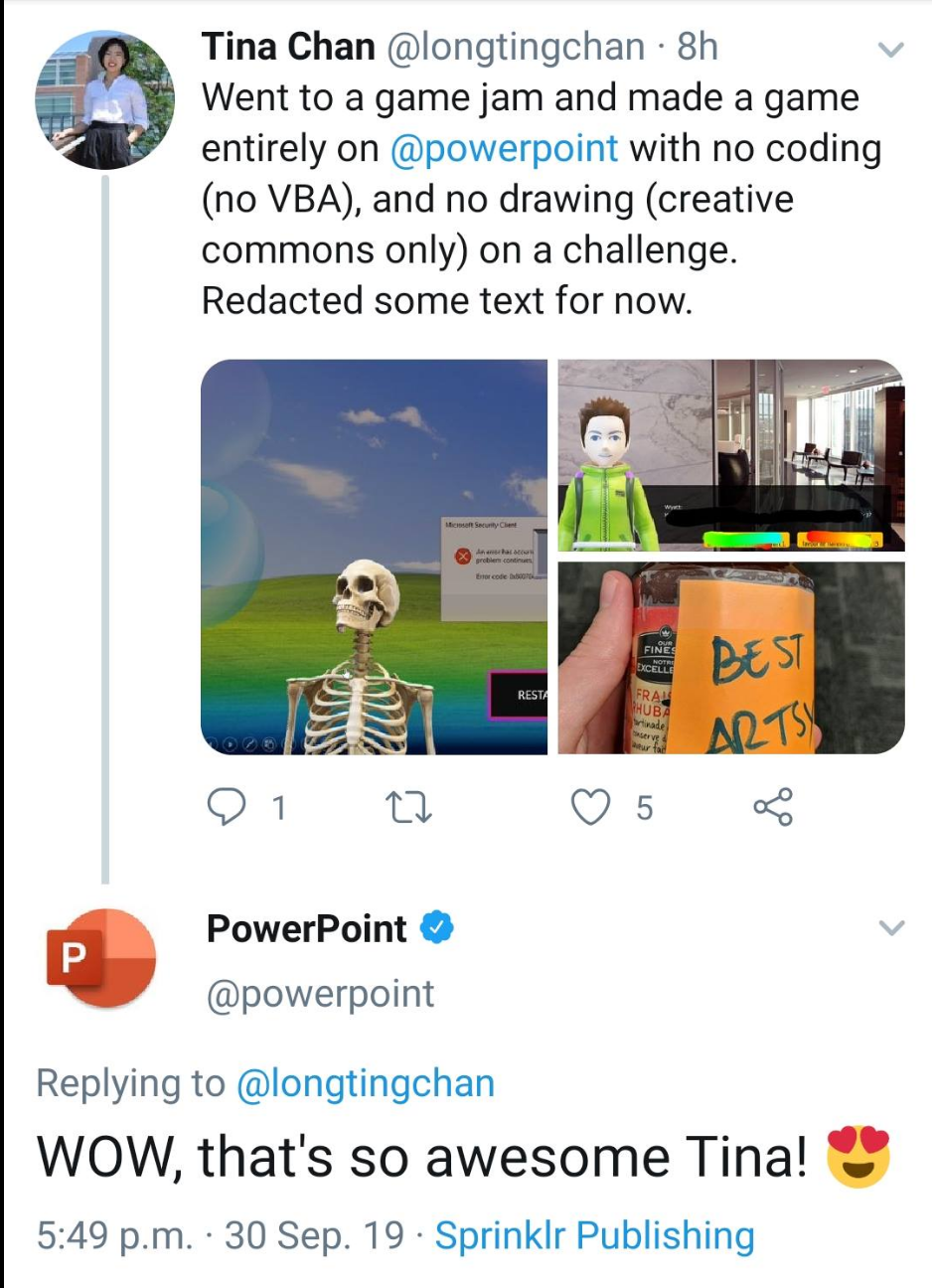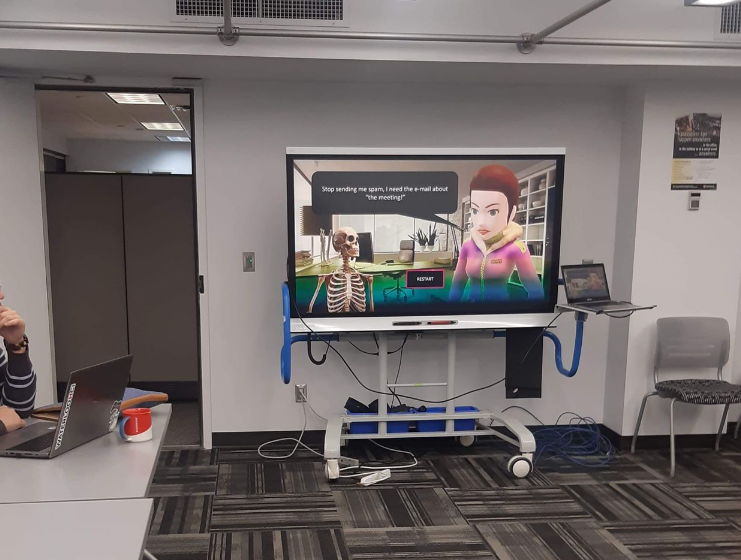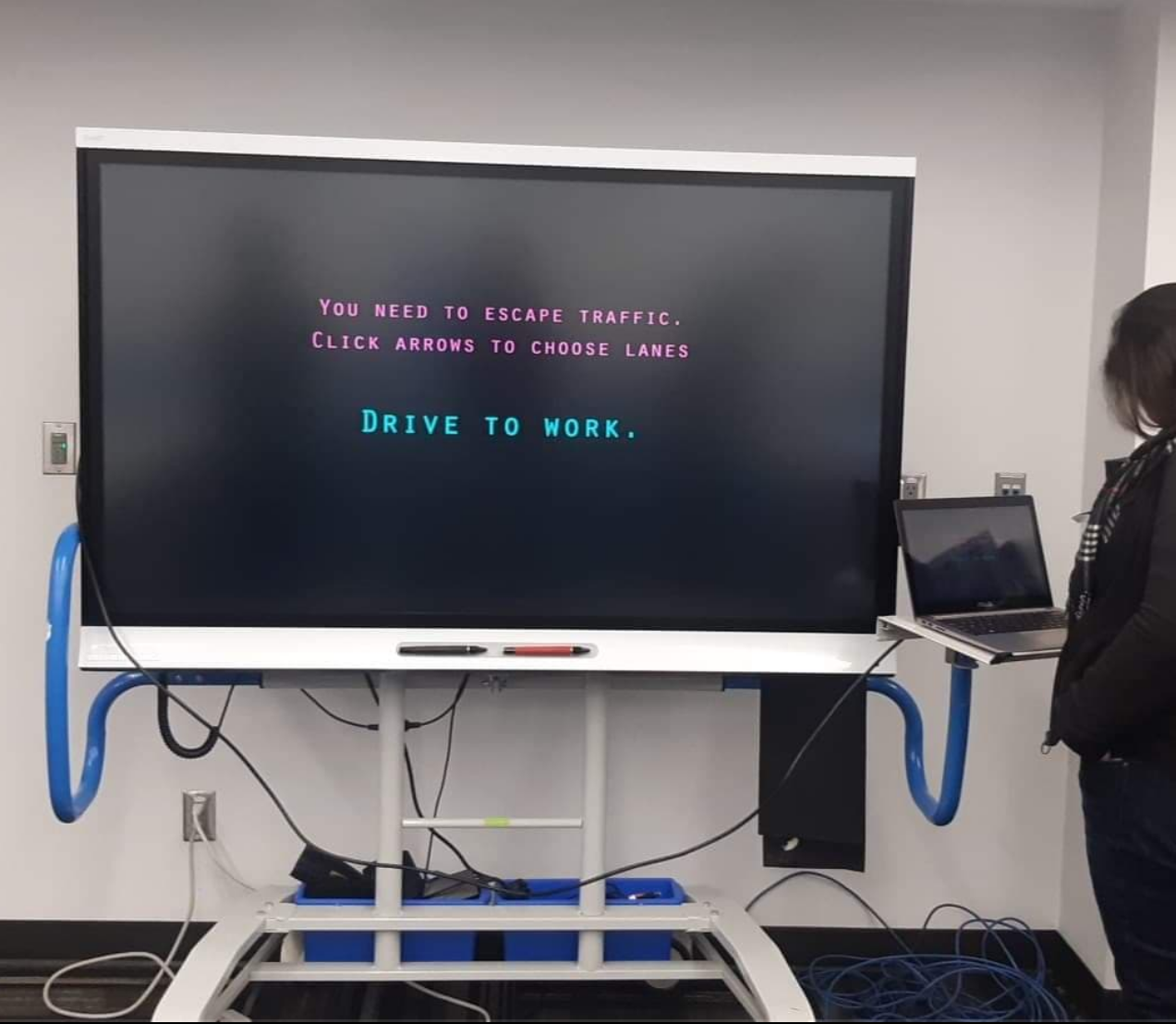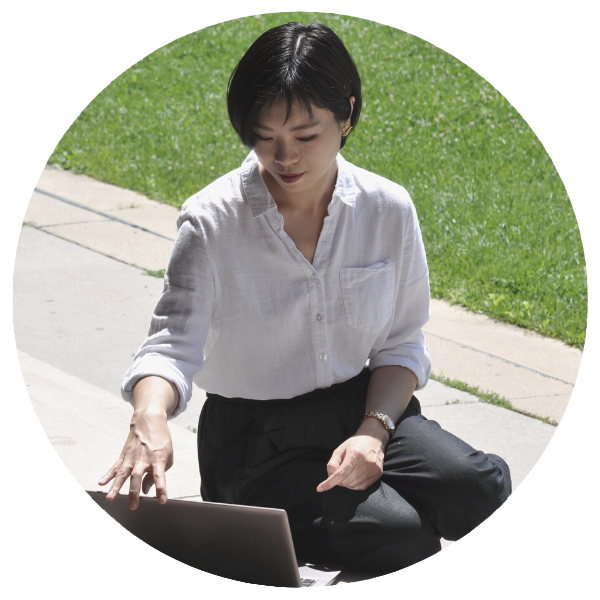
HCI Researcher & Designer
A portfolio showcasing academic and industry works in games and health.

HCI Researcher & Designer
A portfolio showcasing academic and industry works in games and health.














I completed my MSc in Human-Computer Interaction at the University of Waterloo using research through design to explore solutions to public health issues.
Currently, I am a User Researcher at Ubisoft Montreal working in usability, accessibility, and balancing in a competitive Triple-A title (Rainbow Six Siege).
Chan, T., & Wallace, J. R. (2018). Changing Peer Support Attitudes with Avatar-based Gamification. In Computer Human Interaction. Association for Computing Machinery.
Chan, T., McMurray, J., Wallace, J. R., & Sidahmed, A. (2018). SmartSurveys: Does context influence whether we'll share healthcare experience data with our smartphone? . In ACM Conference on Interactive Surfaces and Spaces 2018. Association for Computing Machinery.
Chan, T., McMurray, J., Levy, A. Marie, Wallace, J. R., & Sveistrup, H. (2020). Post-Hackathon Learning Circles: Supporting Lean Startup Development. In CHI 2020.

As my Masters Thesis project, I created Merlynne which asked players to provide stress management advice to others within a fantasy game environment. Findings from a mixed-methods study suggested that players using stereotypically "helpful-looking" avatars were more motivated to submit empathetic advice.
OCT 2017 - SEPT 2019
As a researcher, I:
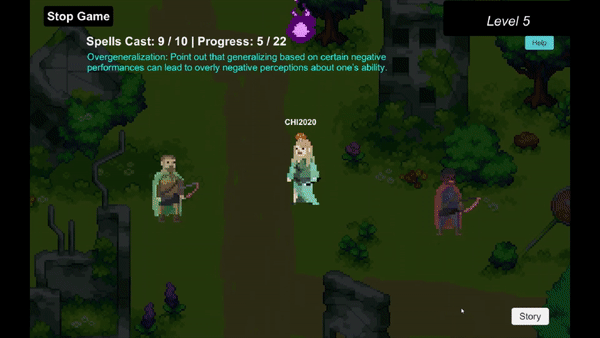
The player approaches NPCs in a fantasy map and then provides advice in triggered dialogue boxes.
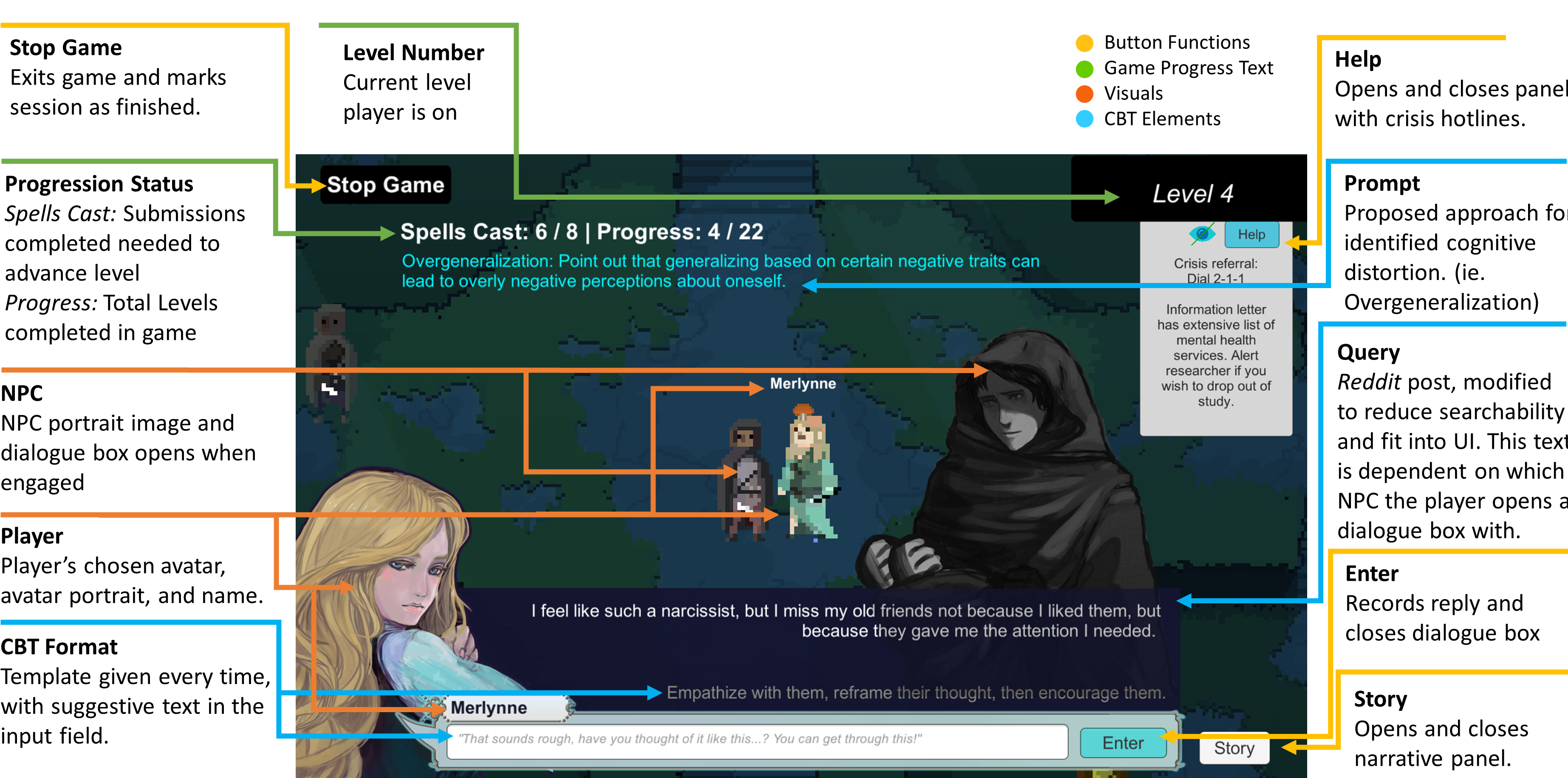
A breakdown of the UI.
Findings guide design suggestions to motivate more effective advice from users on mental health peer support platforms,.
I designed a mixed-methods, exploratory study, hypothesizing that players using a helpful avatar in Merlynne would have higher usage rates (time, words, players helped), higher use of the CBT format which includes empathy, and a higher change in helping attitudes scores (HAS) than players using an unhelpful avatar.
Merlynne was created in consultation with health groups, ethics boards, HCI experts, and existing literature in HCI and mental health.
I made study decisions to factor in needs of stakeholders:
Iterative design was used.

Above are two iterative prototypes. A puzzle game and a space exploration game.
For my research on avatar influence, two avatar conditions (Monster and Cleric) were created based on media arts literature with feedback from peers studying language in gaming.
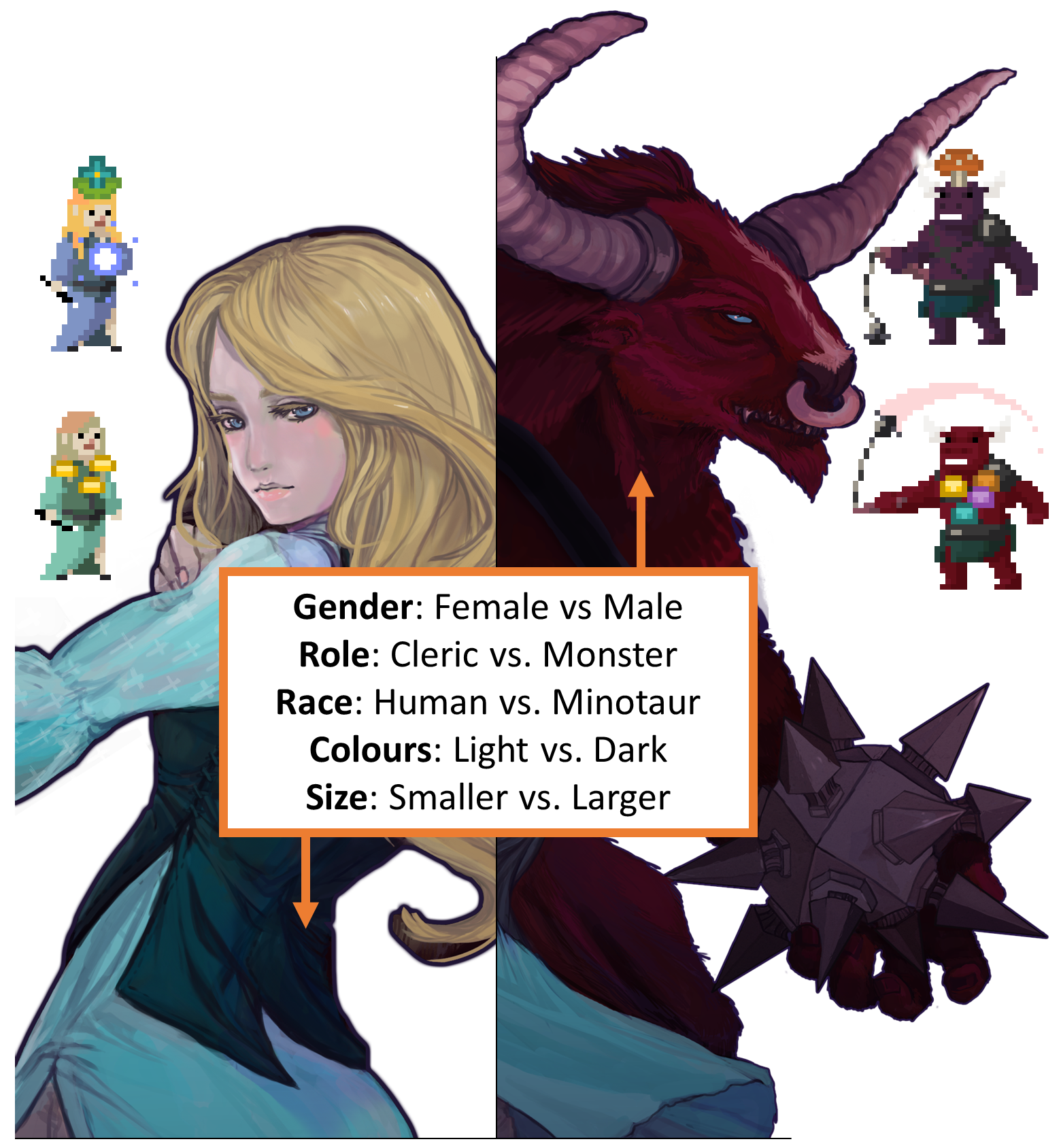
A 2 hr in-lab study was held with 36 male participants recruited from a graduate mailing list and posters from the University of Waterloo campus. Participants completed pre-post surveys containing HAS scales before and after a 30-40 minute play session using a random avatar condition, followed by a semi-structured interview.
Peer support responses collected in-game from participants were assessed for adherence to CBT format by myself and two research assitants with whom I achieved high inter-rater reliability with, with the dataset. Data-driven thematic analysis using open and axial coding was used to interpret interviews, supported by inferential statistics with non-parametric tests (Mann Whitney U) of usage data including aforementioned responses coded for CBT format adherence.
*Full paper is currently in submission to CSCW 2020.
Chan, T., & Wallace, J. R. (2018). Changing Peer Support Attitudes with Avatar-based Gamification. In 3rd Symposium on Computing and Mental Health: Understanding, Engaging, and Delighting Users. Massachusetts Institute of Technology.
Chan, T., & Wallace, J. R. (2018). Changing Peer Support Attitudes with Avatar-based Gamification. In International Conference on Persuasive Technologies.
Chan, T. (2018). Designing for Engagement in Peer-to-Peer Support Using Cognitive Behavioural Therapy with Gamification and the Proteus Effect. Inter-University Workshop, 2018. Toronto. Retrieved from https://iuw2018.wordpress.com/session2/#4
Chan, T. (2019). DO FEMALE AVATARS ENCOURAGE MENTAL HEALTH SUPPORT IN GAMIFIED PEER TO PEER (P2P) COGNITIVE BEHAVIOURAL THERAPY (CBT)?. Retrieved from https://uwaterloo.ca/w3-represents/do-female-avatars-encourage-mental-health-support-gamified
Chan, L. Ting. (2019). Leveraging the Proteus Effect to Motivate Emotional Support in a Serious Game for Mental Health. Public Health and Health Systems. Retrieved from https://uwspace.uwaterloo.ca/handle/10012/15199
Specific to technical development, there were many Unity techniques I later learned which would have benefited Merlynne such as linking all text objects to a database (e.g. Firebase, or a spreadsheet) for easier content management, using tags to classify NPCs, and using Scriptable Objects to manage the status of interactive objects.
I would have also stored the incoming data natively to an excel spreadsheet to reduce the risk of losing Google conenctivity or the status of my account if it were to be used by future researchers.
The following questions were identified:

I pitched an idea of a "first aid kit for mental health" and then grew it into a sustainable venture with international sales with the goal of delivering stress management tools to high-stress student populations.
2016 - now
As a product designer, I balanced costs with customer needs to design, resource, and develop products which have been sold worldwide, leading to a profitable business.
*As the company founder, I took on many, many other roles including accounting, sales, web development, HR, and often janitor.
PASS Inc. has since developed more products.
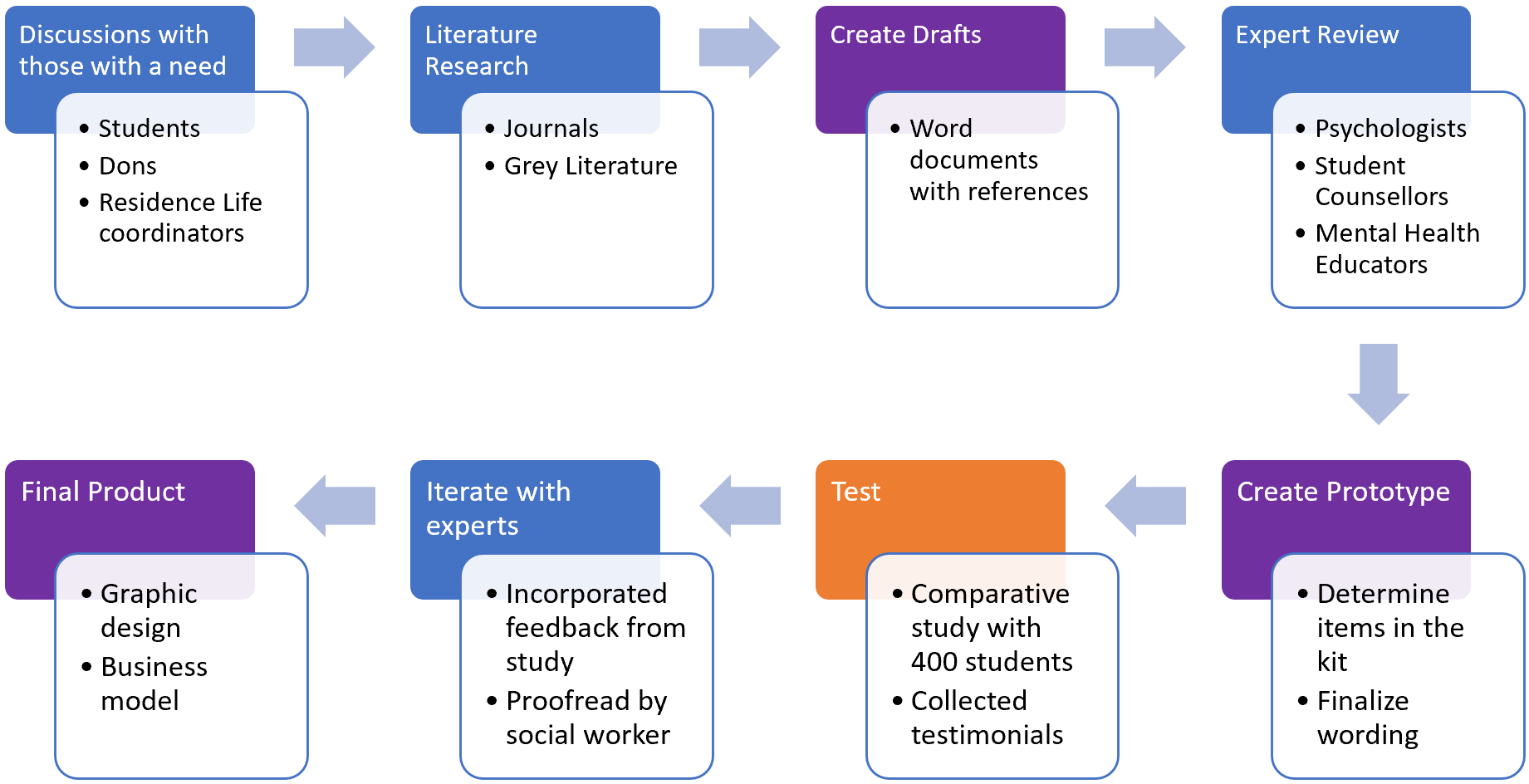
Above is the development process of the PASS kit. Mixed-methods testing revealed that although stress levels of students did not decrease, students who received the PASS kit felt more equipped to deal with stressors than their counterparts.
The PASS kit contains:
Further iterations were based on discussions with customers who shared their needs. Through discussions with customers we learned:
Variations over the years are documented below.
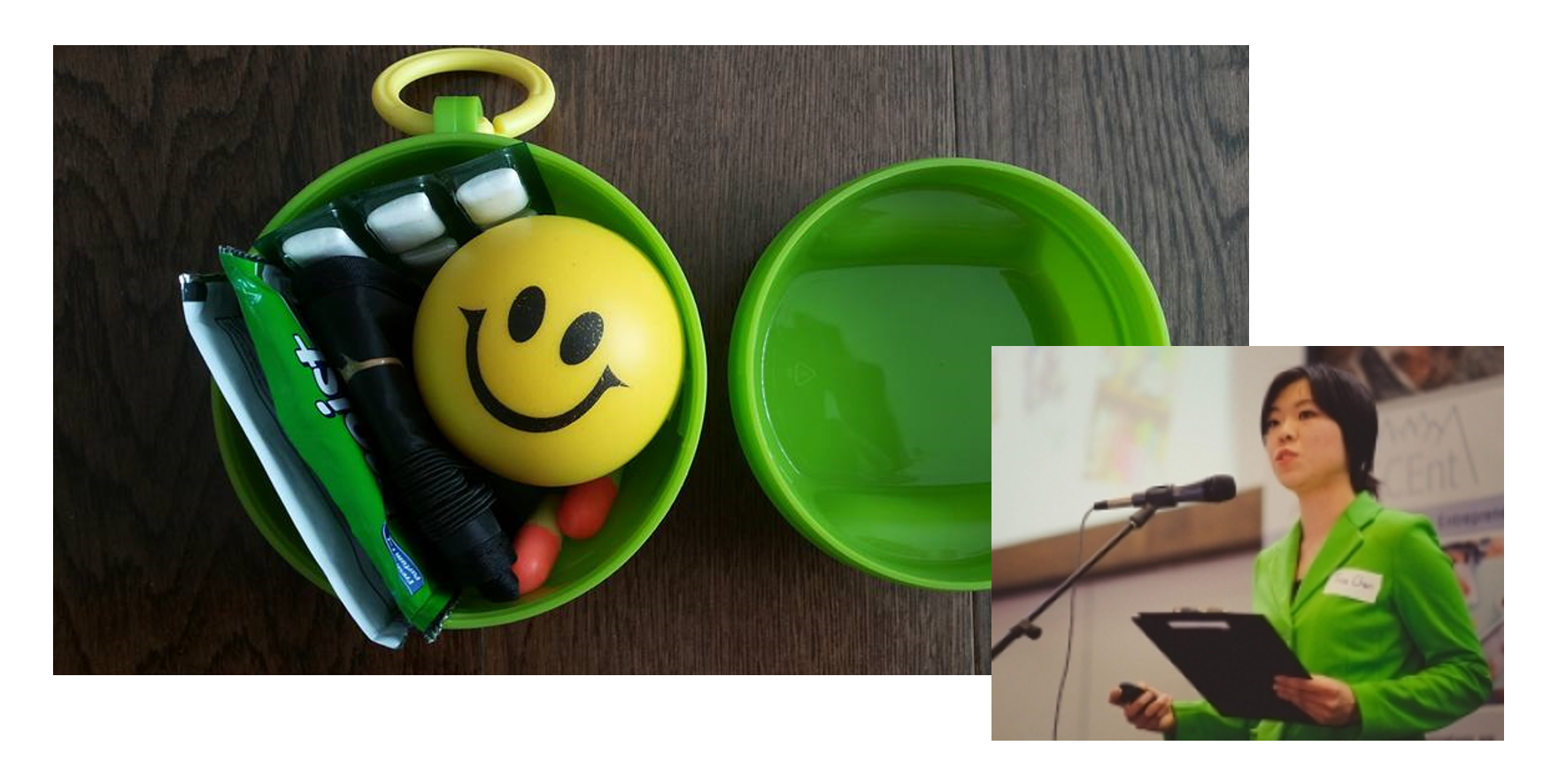
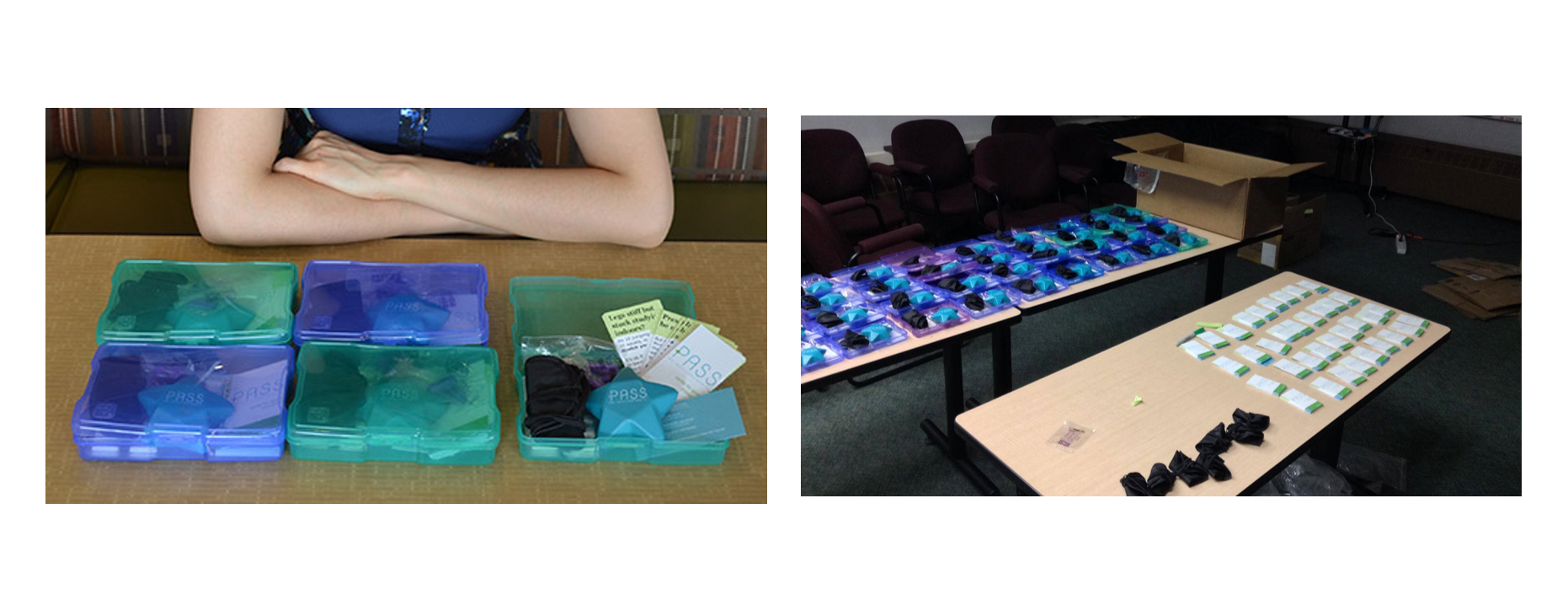
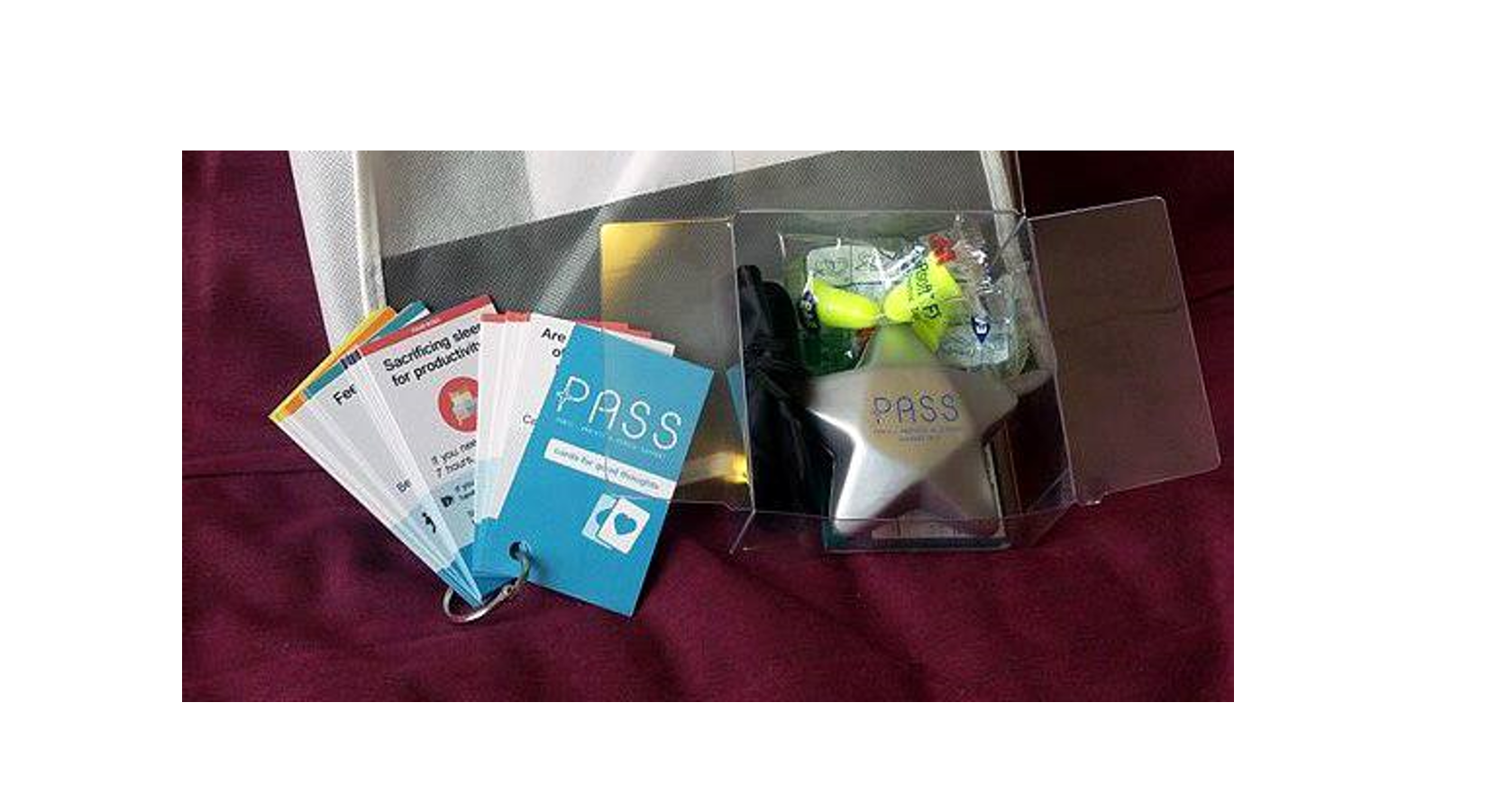
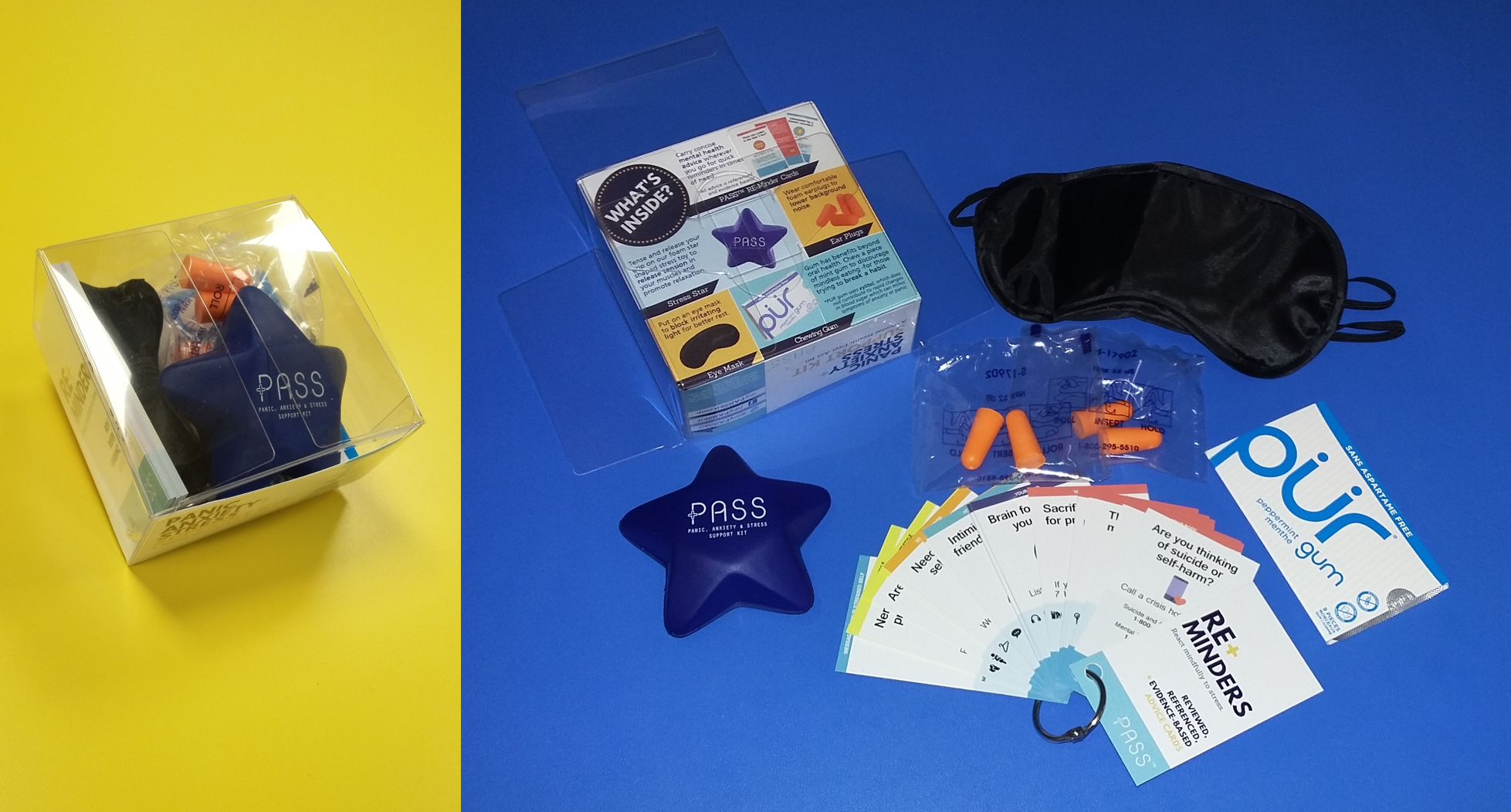

Illuminate is an interactive museum display which emphasized hope in a future with climate change. The project pivoted to a mobile app as COVID-19 led to the closure of the museum exhibition.
OCT 2019 - JUN, 2020
As lead artist, I worked concurrently with the developer and created art assets in Adobe Photoshop for Unity. I also performed user-testing, and designed an art style (ie. line weight, colour) friendly to non-artists tasked with scaling the Illuminate project in the future.
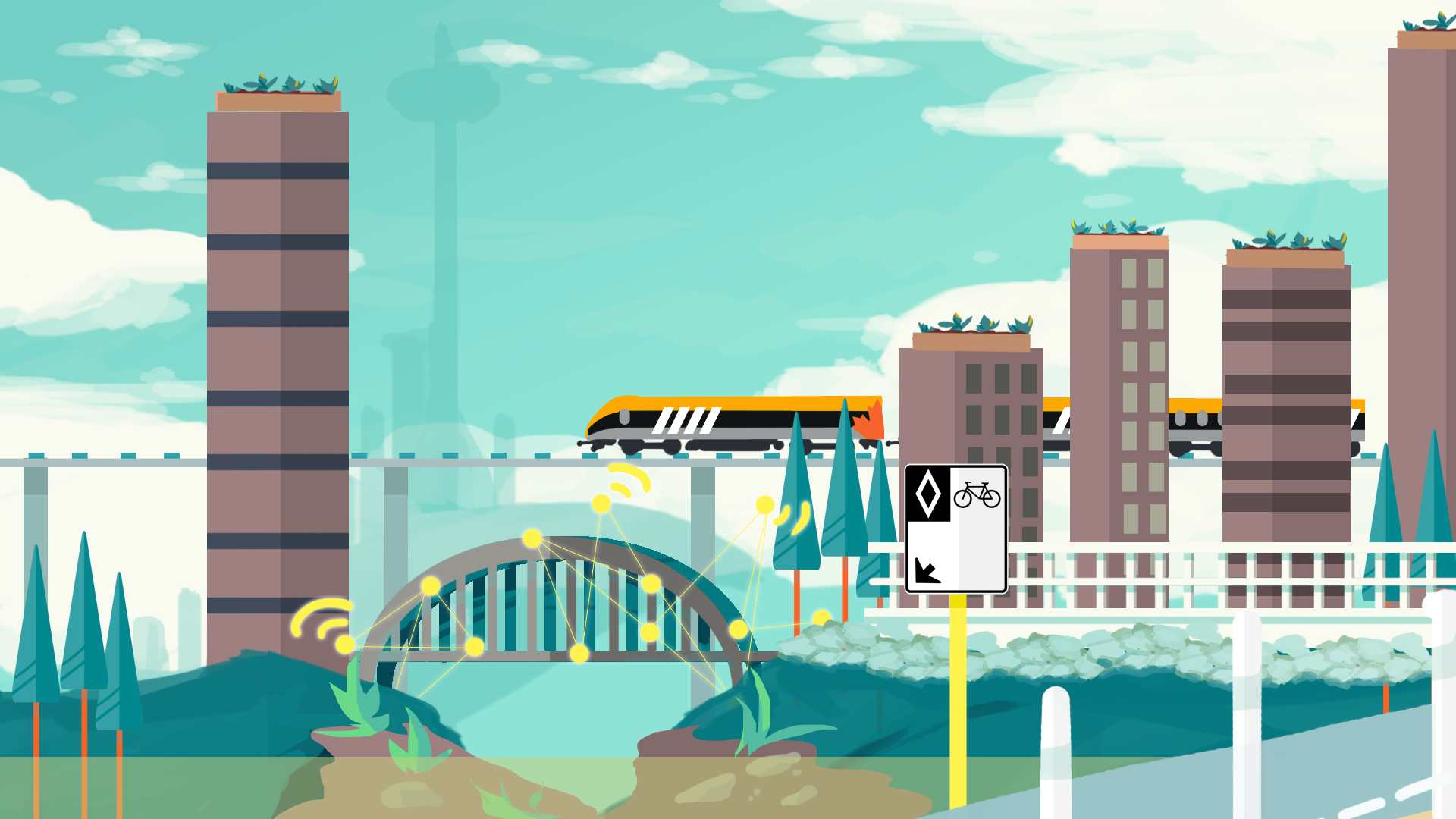 Coastal context
Coastal context
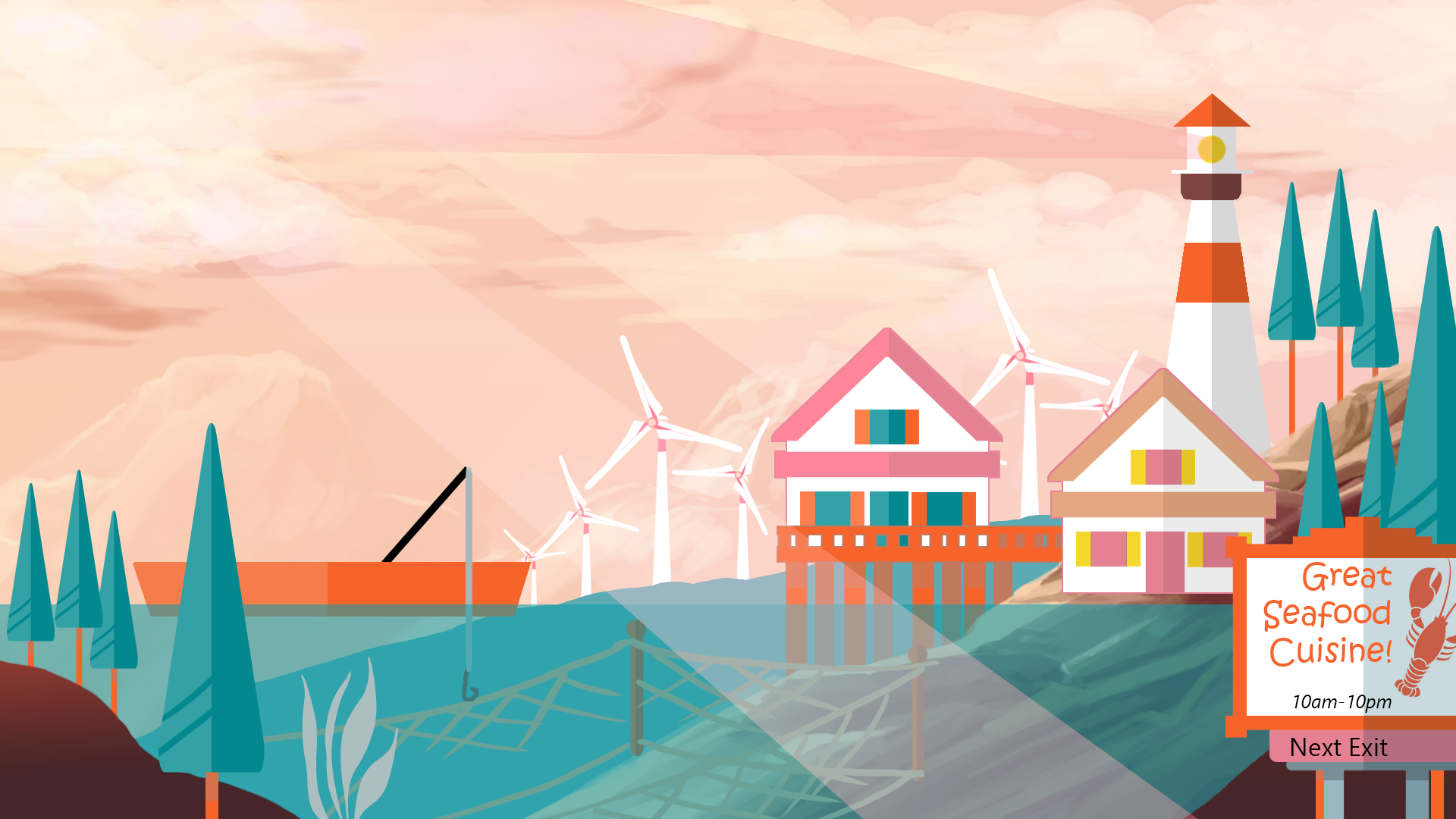 Rural context
Rural context

Due to COVID-19 disruptions, the display was pivoted to a mobile app in February 2020. I created all art assets in discussion with climate scientists, and performed user-testing while translating results into concrete changes to the develope.
Adam Leung: Developer
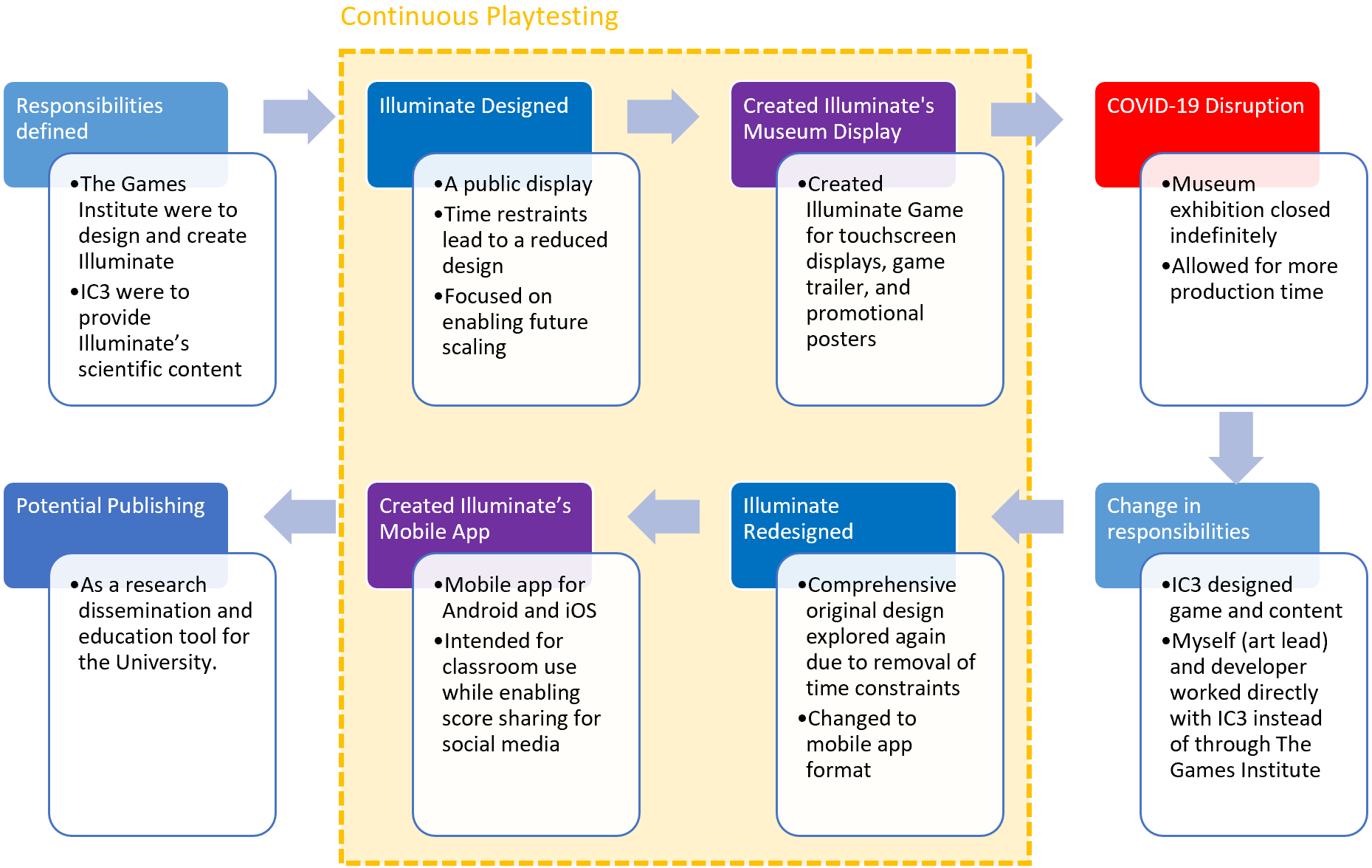
Recurring meetings took place within the production team (writer, developer, artist), and separately within research team (writer, administrative staff, IC3) to support concurrent workflow with competing schedules. Communications were exchanged internally on Slack and externally via email and a shared OneDrive. The management system was consistently used and effectively led to a scalable prototype developed by the time the writing was finalized.
The developer and I (artist) were not scheduled to continue our contracts, thus if new modules were to be added post-January, both the game environment and the art assets must be easily learnable by new members. In the case no new art talent was available, I purposefully used a low-barrier art style. Barriers to artwork were seen as poor art fundamentals such as (1) line control; (2) colour theory; and (3) drawing from memory. Thus, the art style I chose used feathered brushes which did not require precise line weight control, a colour palette was pre-chosen for future art, and realistic proportions were used for future artwork to be produced by tracing photos.
MUSEUM space
 Game loops were kept short (30 secs to 2 min play), asking players only three questions each landscape scenario, with 3-4 options per question to ensure replayability. A second monitor with a trailer video was also set up to display potential gameplay to passersby to garner interest in interacting.
Game loops were kept short (30 secs to 2 min play), asking players only three questions each landscape scenario, with 3-4 options per question to ensure replayability. A second monitor with a trailer video was also set up to display potential gameplay to passersby to garner interest in interacting.
A finished prototype of one landscape (coastal) was presented as a demo to IC3, with the narrative and artwork of remaining landscapes provided as text and image files. Through email discussions and a working shared spreadsheets file, IC3 provided feedback in writing with relevant sources. Narrative and artwork was updated with their insight.
External to the core team, testing was performed on student volunteers in the Games Institute over lunch on their personal mobile devices. Students were asked to play through scenarios and voice aloud their thoughts and concerns during the playthroughs. Inconsistencies between narrative and art were brought up, as well as minor confusions in UI (e.g. buttons were not obviously leading to intended screens). Changes were applied quickly from testing and tested again internally before launching.
The reasons for the changes were to emphasize the economic cost to climate change mitigation, but also to better support the game with update climate science. Given the extra time for production, more input from climate scientists was also possible.
What I would have done differently I prioritized art assets for the Illuminate interface, but in retrospect the art should have considered the installation concept as a whole from print advertisements to video trailers. The colour schemes and iconography chosen for the gameplay were lighter in colour and storybook-like to appeal to both children (storybook readers) and adults (storybook buyers). Although effective for the visual-novel game interface, the style may not be as attractive to the passerby in a busy public space, especially when compared to previous displays by the Games Institute like Quantum Cats, which has graphics easily translatable to its promotional materials.
In the future I would also use vectors for images for better scaling across different screen sizes and I would be interested in exploring the .psb file setting instead of saving each layer (through batch processing script) to be imported into Unity to enable animations.

We hosted a post-hackathon event inviting seniors with lived experiences to help hackathon winners refine their health 'hacks' for commercialization. Follow-up interviews revealed the strengths of using Learning Circles, an indigenous model of knowledge sharing, in the software development life cycle (SDLC).
APR - DEC, 2019
As a researcher, I performed thematic analysis on interviews with NVivo to interpret and present findings into a case study to publish at an ACM conference, CHI 2020.
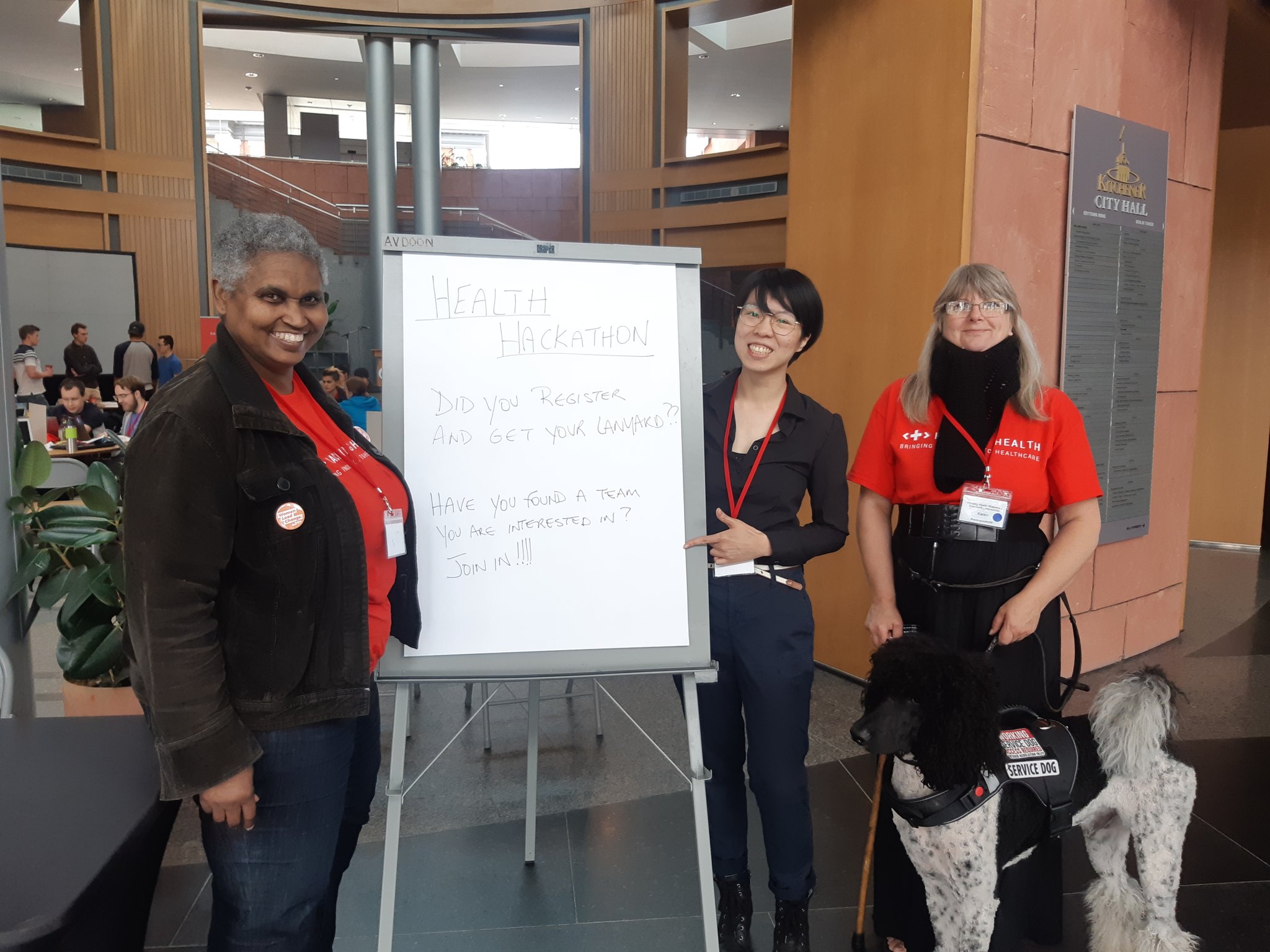
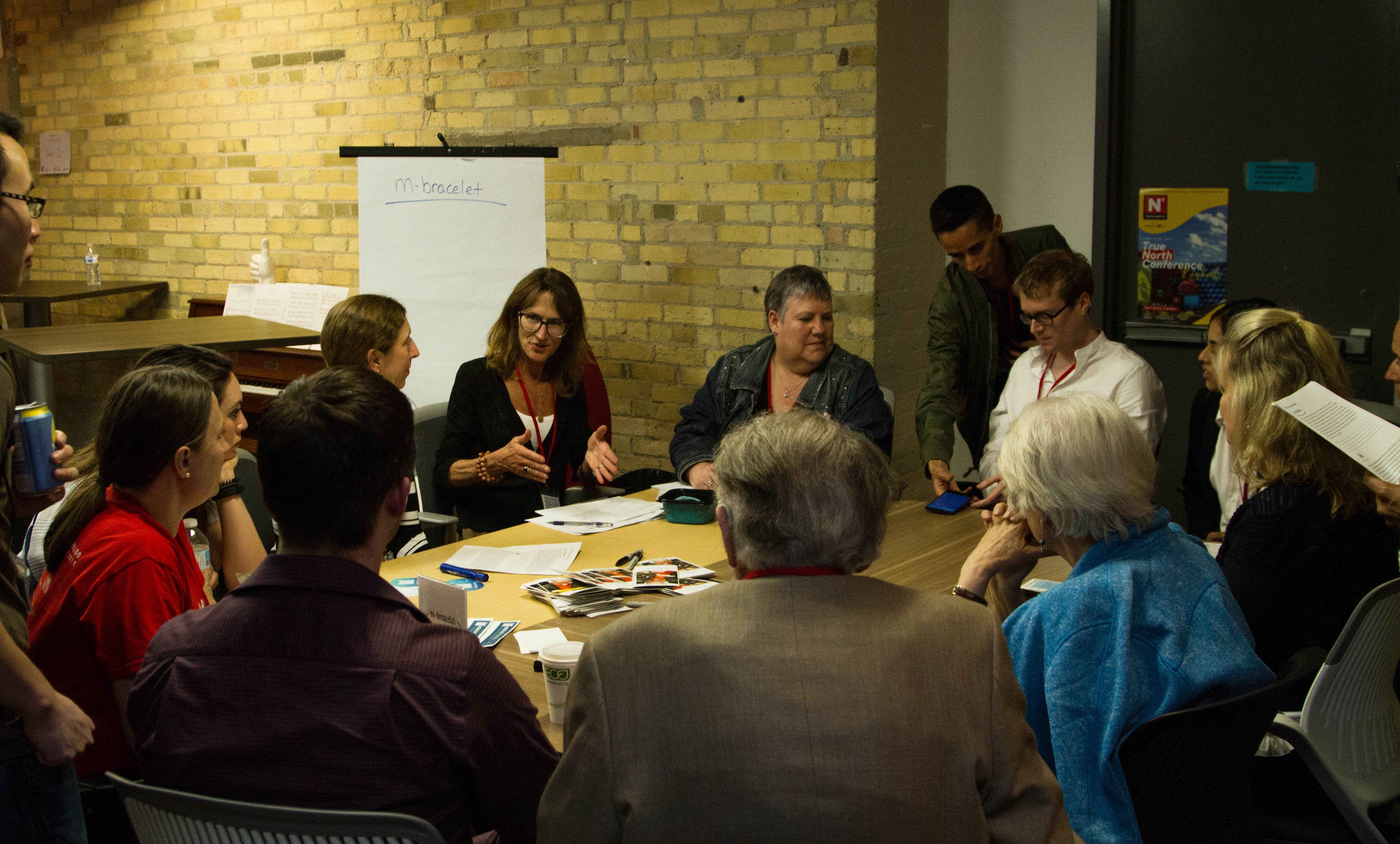
NVivo was used for thematic analysis where three researchers independently coded interviews while reflexively journaling. Codes were compared and themes were identified with group discussion.
Post-hackathon Learning Cirles pose as a method to accelerate startup development and has attracted interest from other researchers in the hackathon space for data comparison.
Levy, A. M., McMurray, J., Chan, T., & Wallace, J. R. (2019). Building regional health ecosystem capacity: Post-hackathon learning circles to support early co-design of social isolation solutions for older adults. In 5th Annual AGE-WELL Conference.
Chan, T., McMurray, J., Levy, A. Marie, Wallace, J. R., & Sveistrup, H. (2020). Post-Hackathon Learning Circles: Supporting Lean Startup Development. In CHI 2020.
Chan, T., McMurray, J., Levy, A. Marie, Wallace, J. R., & Sveistrup, H. (2020). Hallman Lecture Series with Jane Philpott. Post-Hackathon Learning Circles: Supporting Lean Startup Development. Waterloo, Canada.

I implemented SmartSurveys, a research tool prompting consumers to provide service feedback via smartphones based on geographic location ('geolocation'). The study goal was to identify addressable barriers that impact the adoption of smartphone technology to gather patient experience data in health care spaces.
APR 2017 - DEC 2018
As a researcher, I wrote provincial grants (OCE) and ethics applications to two university boards (Wilfrid Laurier University (WLU), University of Waterloo (UW)), while creating the SmartSurveys on MetricWire and its onboarding materials with their app developers.
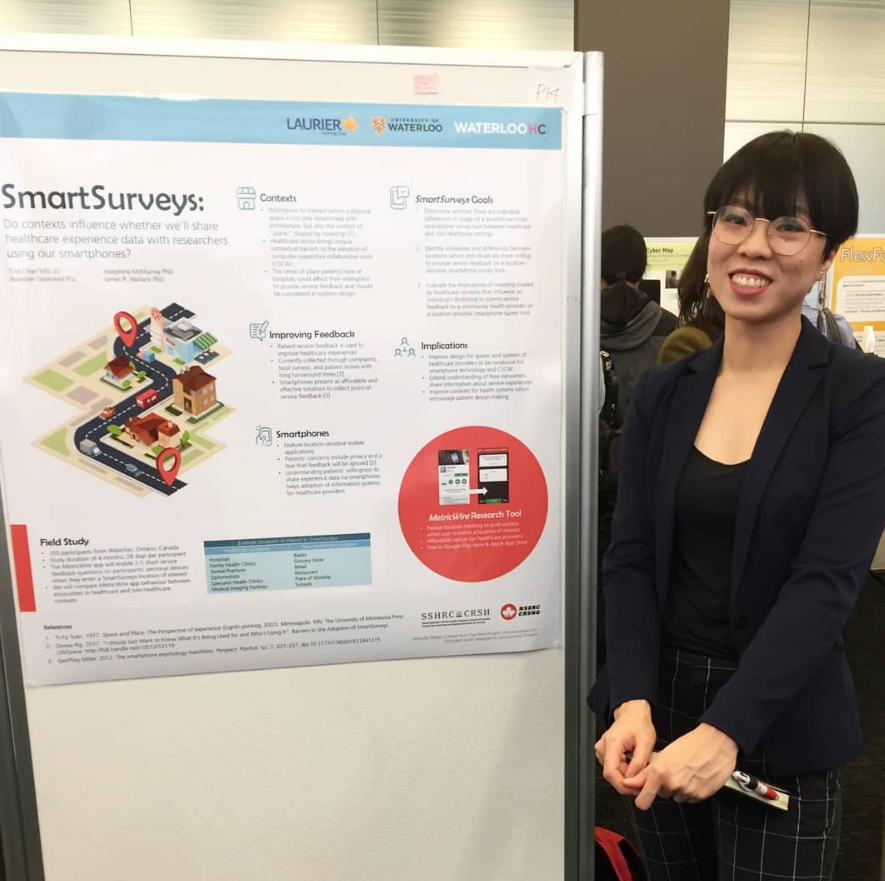
MetricWire is a data collection tool developed in Kitchener-Waterloo by the startup MetricWire Inc., who were also collaborators on the NSERC-Engage grant funding SmartSurveys. In regular meetings with the MetricWire team, I came to discover the limitations and opportunities with their tool concurrently with their startup development.
Participants were recruited online and directed to enroll in the SmartSurveys study on the MetricWire app through a one-page website. The website linked to consent letters and installation guides hosted on Google Drive. When SmartSurveys was installed, participants would complete an intro survey to complete enrollment, then be given surveys through MetricWire every time they dwelled in a geofenced location.
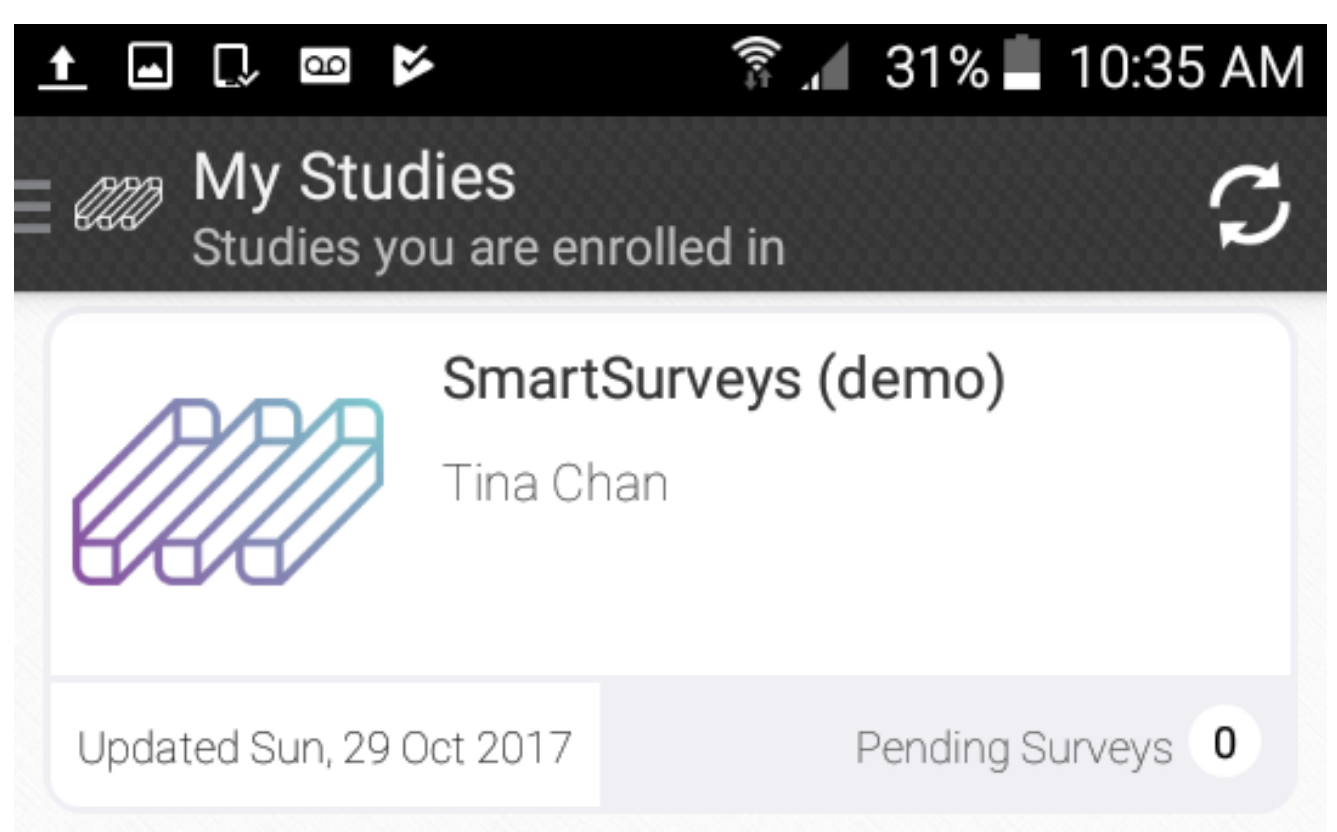 Automatically measured variables included situated usage data such as time spent in a geographic area, time between entering a location and submitting feedback, and between the time of exit and feedback submission. Overall activity data like the number of submissions, and the number of words per submission was also tracked to be compared between locations.
Automatically measured variables included situated usage data such as time spent in a geographic area, time between entering a location and submitting feedback, and between the time of exit and feedback submission. Overall activity data like the number of submissions, and the number of words per submission was also tracked to be compared between locations.
I trained two undergraduate research assistants to collect the geographical coordinates and radial size of service providers in Kitchener-Waterloo based on Google map data.
Four lists of geofences were created, containing 100-150 locations on each list.
* On the WLU or UW campus
** In the Kitchener-Waterloo region

After the locations were programmed into the SmartSurveys tool, we tested the sensitivity of the MetricWire app to geofences on foot using different smartphones and operating systems (iPhone, Android).
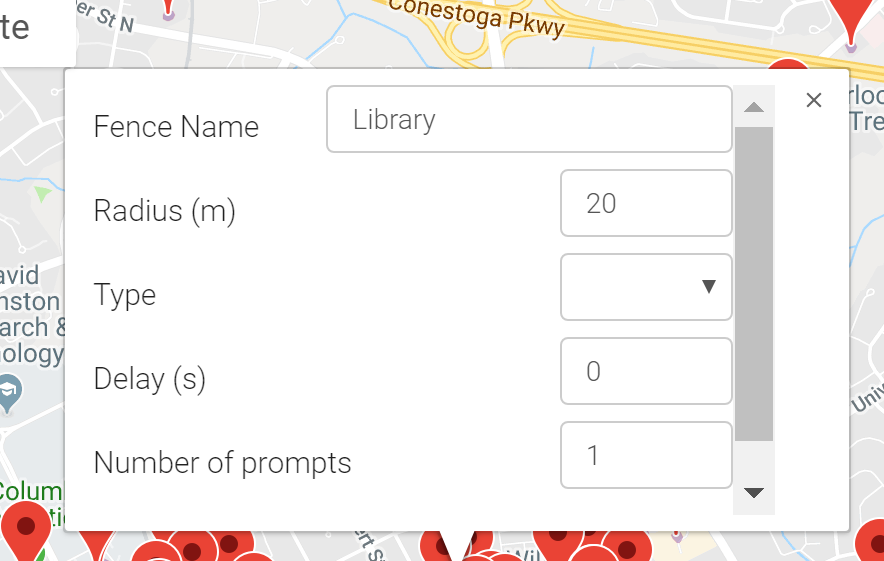
There were overlapping geofences due to multi-service buildings with multiple floors with different services. It was difficult to differentiate services leading to the over-triggering of surveys. As a solution, an extra question was asked in multi-service buildings asking participants to indicate where they were in a form field.
Some geofences also did not fire when entered, as Android phones were not registering the geofence as quickly to save battery life. This posed as a study problem as iPhone and Android users would have inconsistent participant experiences. As a short-term fix, I changed the trigger from 'dwelling in an area' to 'exiting an area' to at least ensure all participants received notifications after service provision instead of some during and some after.
Chan, T., McMurray, J., Wallace, J. R., & Sidahmed, A.. (2018). SmartSurveys: Does context influence whether we'll share healthcare experience data with our smartphone? . In ACM Conference on Interactive Surfaces and Spaces 2018. Association for Computing Machinery. Retrieved from https://dl.acm.org/citation.cfm?id=3279912
One major barrier to implementation was the inconsistency of geofences firing for different smartphone users. Despite the investment in tool setup, I would have explored other ways to measure contextual sensitivity.
The study could have sent participants surveys to complete through MetricWire according to a predetermined time schedule. Participants would report where they were and offer feedback if willing. Although less relevant data points may be collected (e.g. if the participant was at home most of the survey times), it would have been independent of GPS error.

LIFEHACK was created by youth at a hackathon in Ulaanbaatar to teach Mongolian students about the effects of daily choices based on the creators' own experiences. I proposed design and development methods to reduce their future costs for commercialization.
SEPT - NOV , 2018
As a researcher, I documented methods and findings for presentation at a local conference, and identified lessons learned which can be applied to future global health projects.
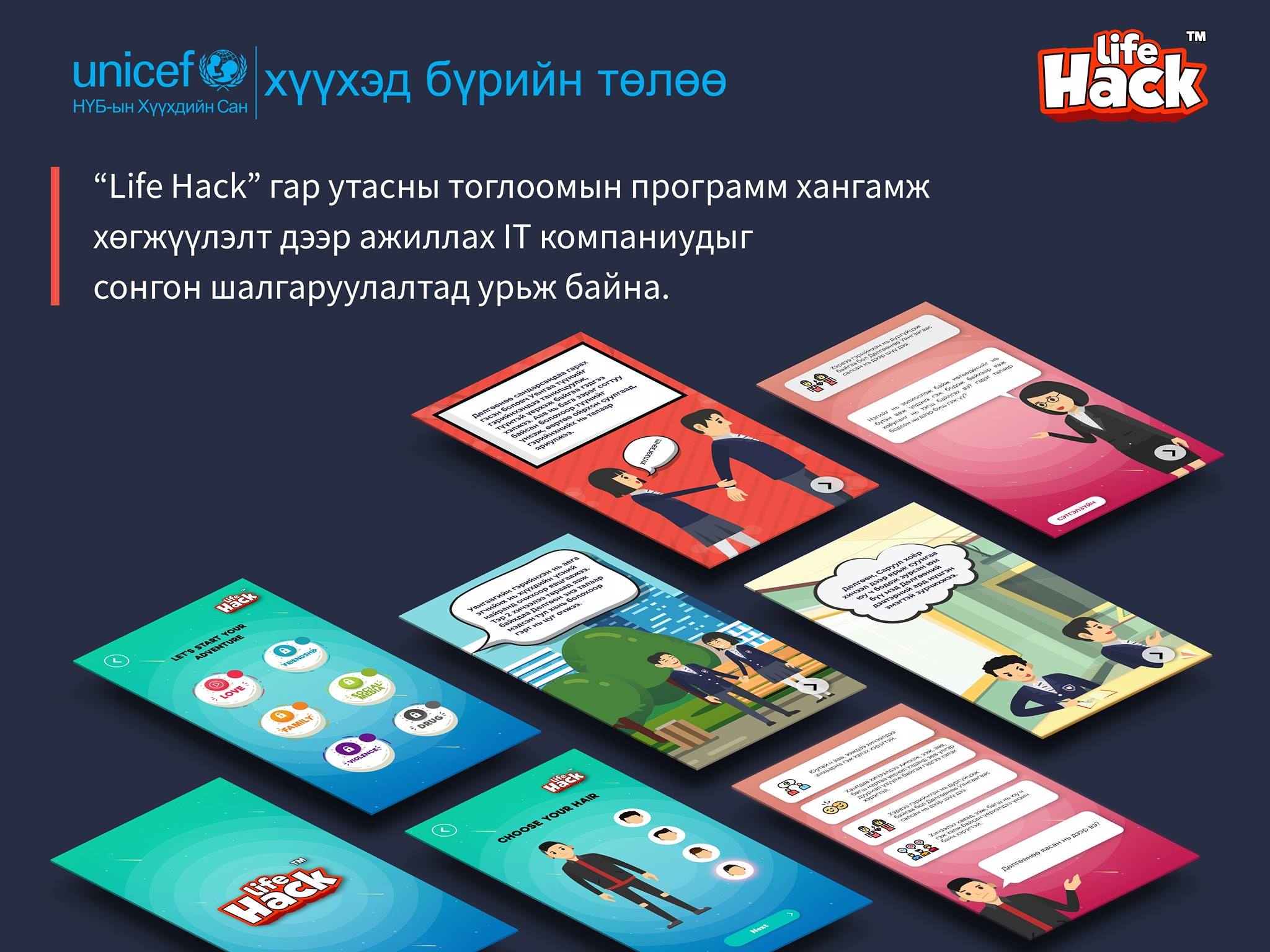
Social media post by LIFEHACK showing their high-fidelity wireframes.
It became known in future meetings that a prototype needed to be developed for LIFEHACK to renew funding from Unicef Mongolia, thus the short runway for development was acknowledged.
In review of the LIFEHACK's vision, resources, and talent, the teams' strengths laid in their lived experiences as youth growing up in Mongolia, connections to experts in Unicef Mongolia, and artistic talent (graphic design, photography, writing).
Through two more video calls, we further understood the vision of LIFEHACK to bring the game into middle school classrooms, and shared our intentions to use concepts from Self-Determination Theory (SDT) and iterative testing in the SDLC to help them develop their project.
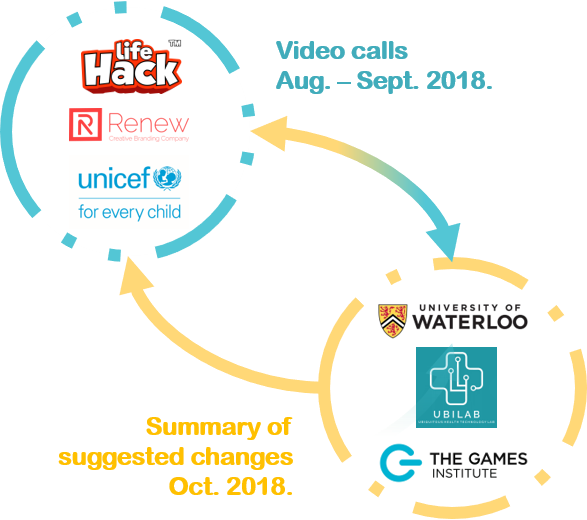
All opinions were presented as suggestions in the interest of faster development, and it was made clear that they were to prioritize their vision if they saw conflict in suggestions.
This consultation effort was presented as a poster as an example of global collaboration health research and game development.
Chan, T., Costa, M., Somani, N., Morita, P., & Wallace, J. R. (2018). LIFEHACK - A Serious Game and Simulation by Mongolian Youth to Educate and Motivate Students to make Healthy Choices in Mongolia. Global Health Students and Young Professionals Summit, 2018.
It was assumed that the availability of developers and classrooms in Mongolia were similar to the Canadian environment. If time and opportunity had allowed it, it would have been worthwhile understanding the startup and game development ecosystem (e.g. talent costs) in Ulaanbaatar outside of LIFEHACK's experiences to provide more insightful advice.

I created a series of 3 event posters for the University of Waterloo's Games Institute (GI) Game Jam in hopes of attracting more women+ and non-STEM students to the event. The resulting gender ratio increased compared to previous attendance.
SEPT 2017 - JUNE 2018
As a illustrator, I created character artwork for three posters for three terms consistent to a theme using Adobe Photoshop and Canva.
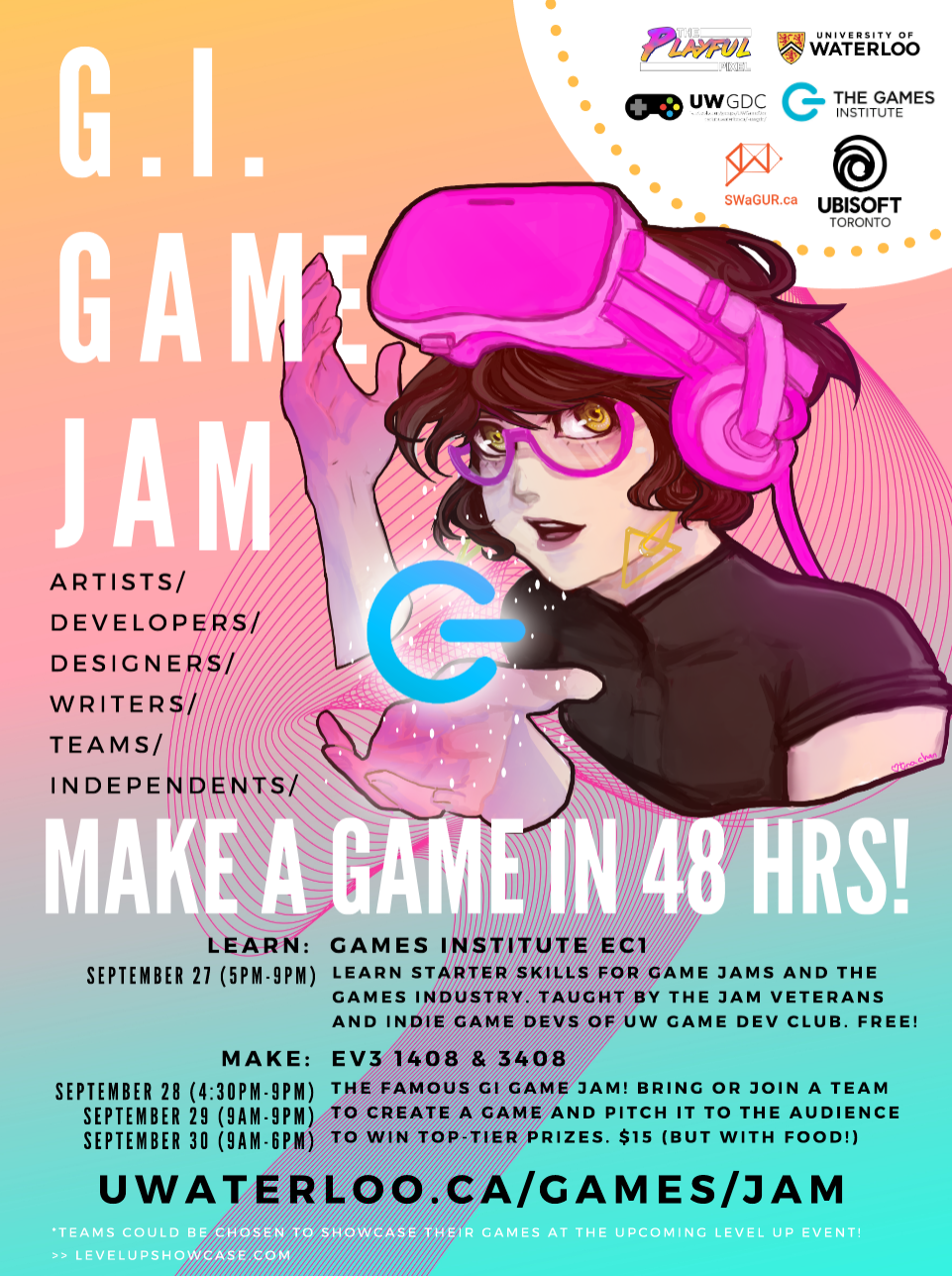
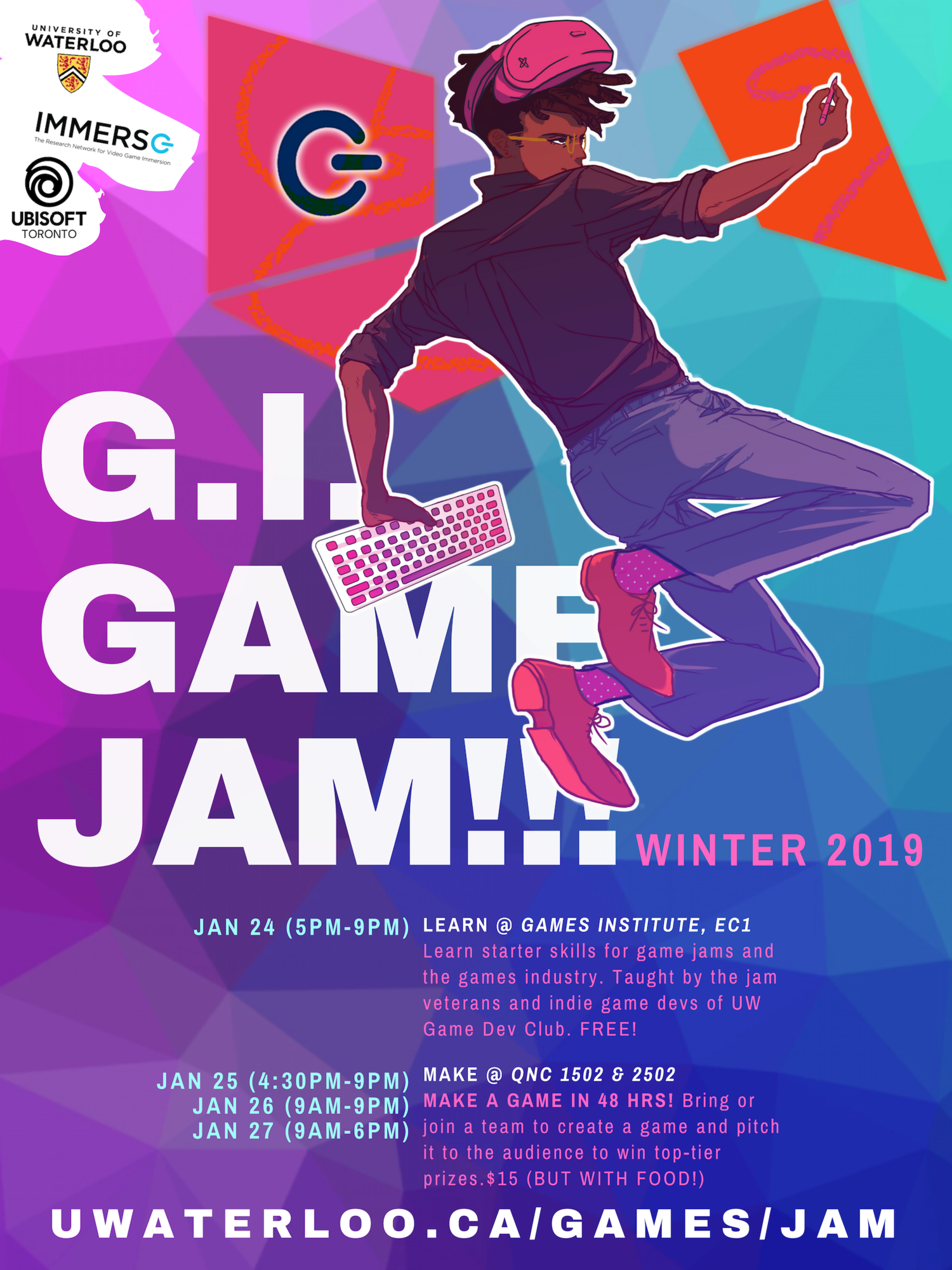
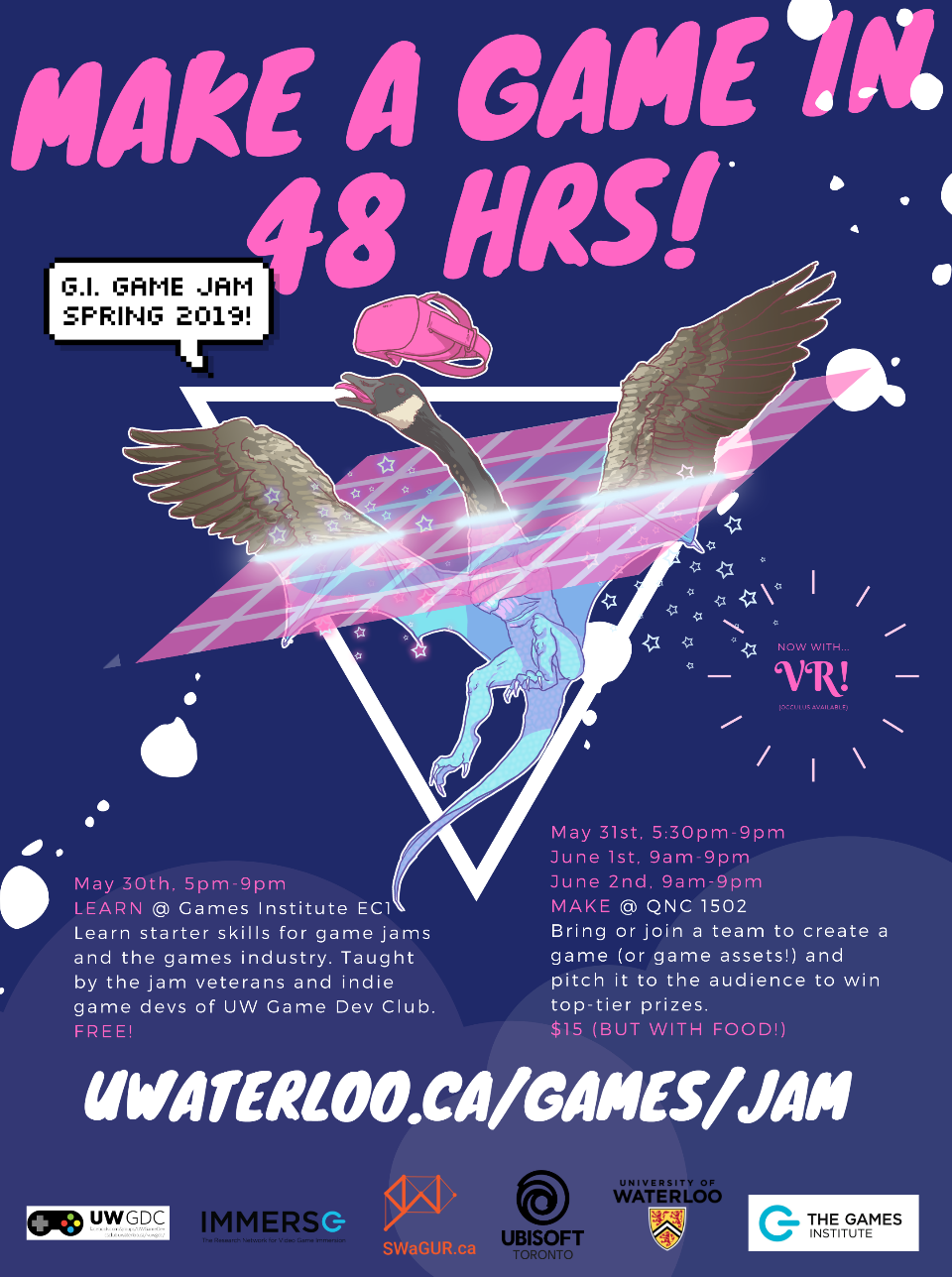
Senior members of the GI Game Jam committee believed that potential participants felt they are unable to participate because they (1) had little or no knowledge of scripting; and (2) had no team to participate with. These misconceptions were noticeably evident among non-computer science students and non male-identifying individuals.
To address these points, I deliberately designed the posters to attract first-time 'jammers.' The poster listed multiple roles in game development in addition to development roles, such as artists, musicians, and writers to appeal to jammers uninterested in programming or wished to create non-digital table-top games. Both teams and solo-jammers were explicitly welcomed to invite jammers with or without team members, and a clear event definition ('Make a game in 48 hours') was added. To purposefully appeal to those interested in the arts, character art was used on the posters in mimicry of anime, movies, and general pop culture. Character art was illustrated in Photoshop CS5.



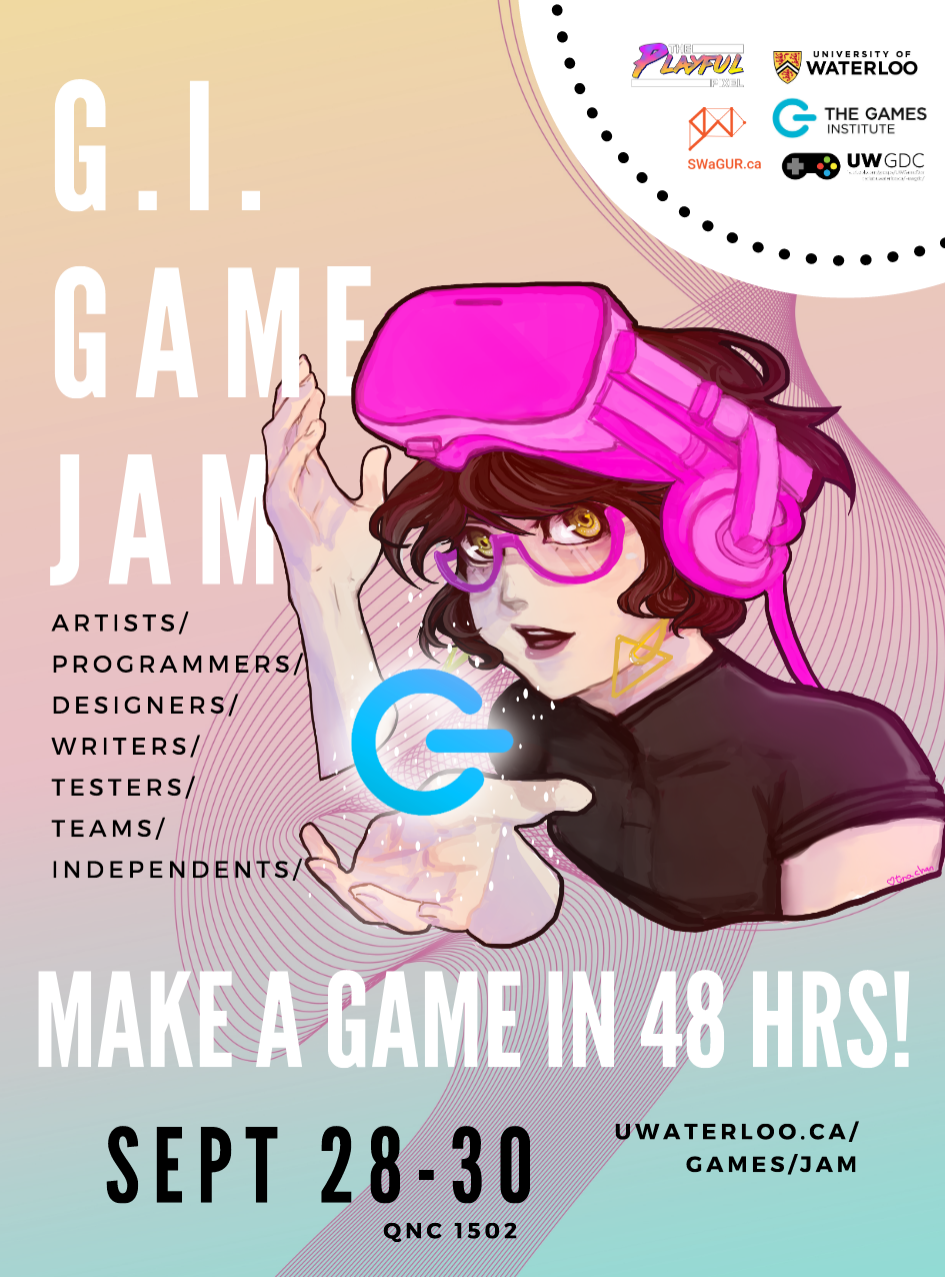
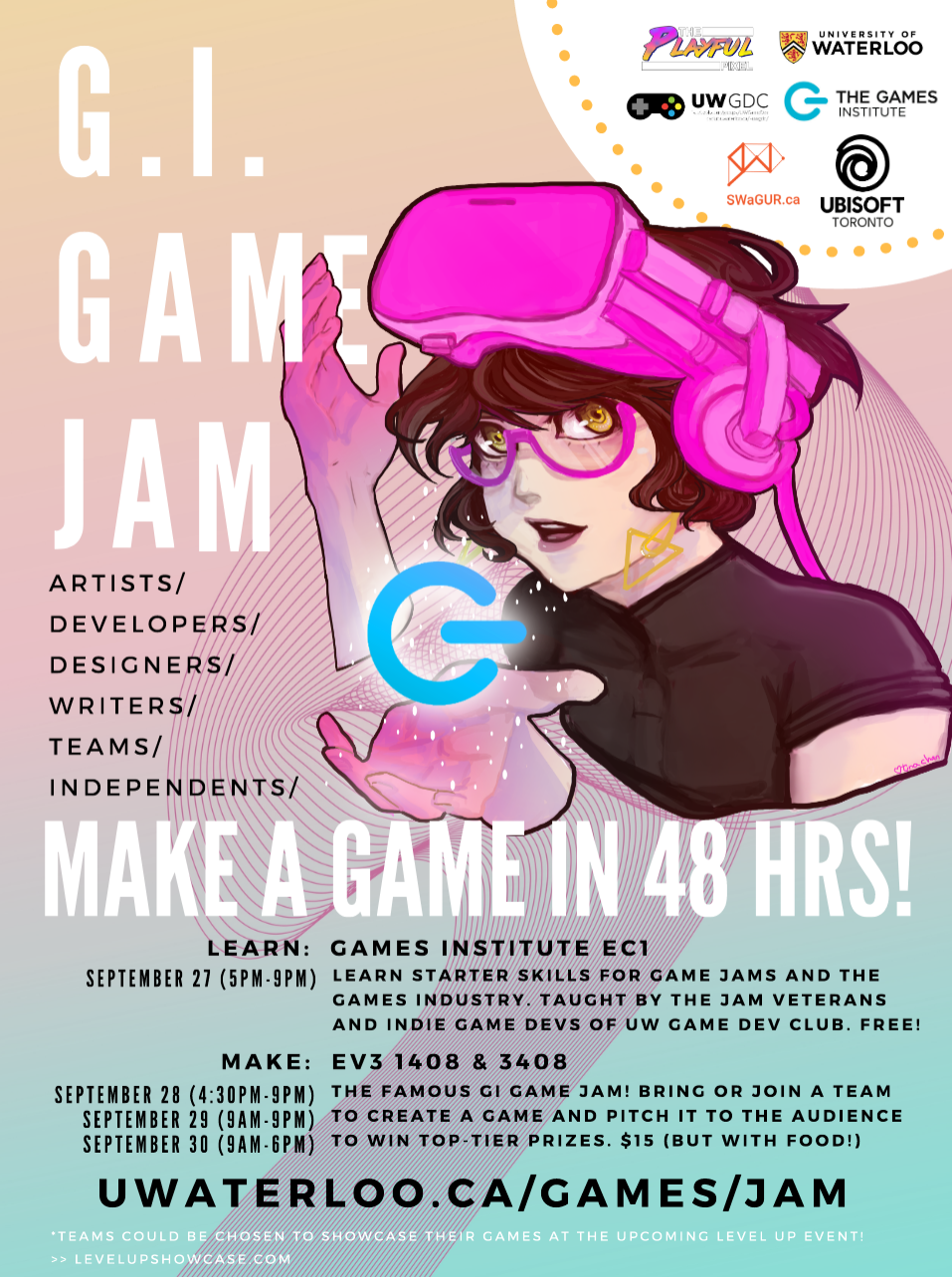

I featured a feminine character on the poster with intentions of relating them to young women+ participants. The glasses and haircut choice was based off a previous GI Game Jam poster character, and the pink VR headset was added to promote VR game-making. Feedback was focused on the legibility of the URL and the brightness of the ink when printed.
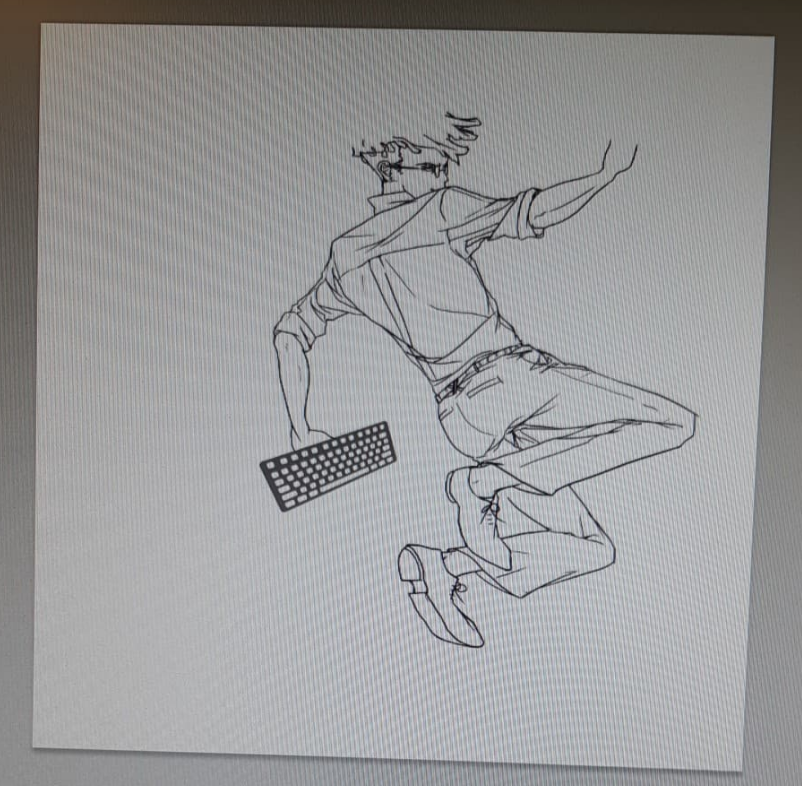
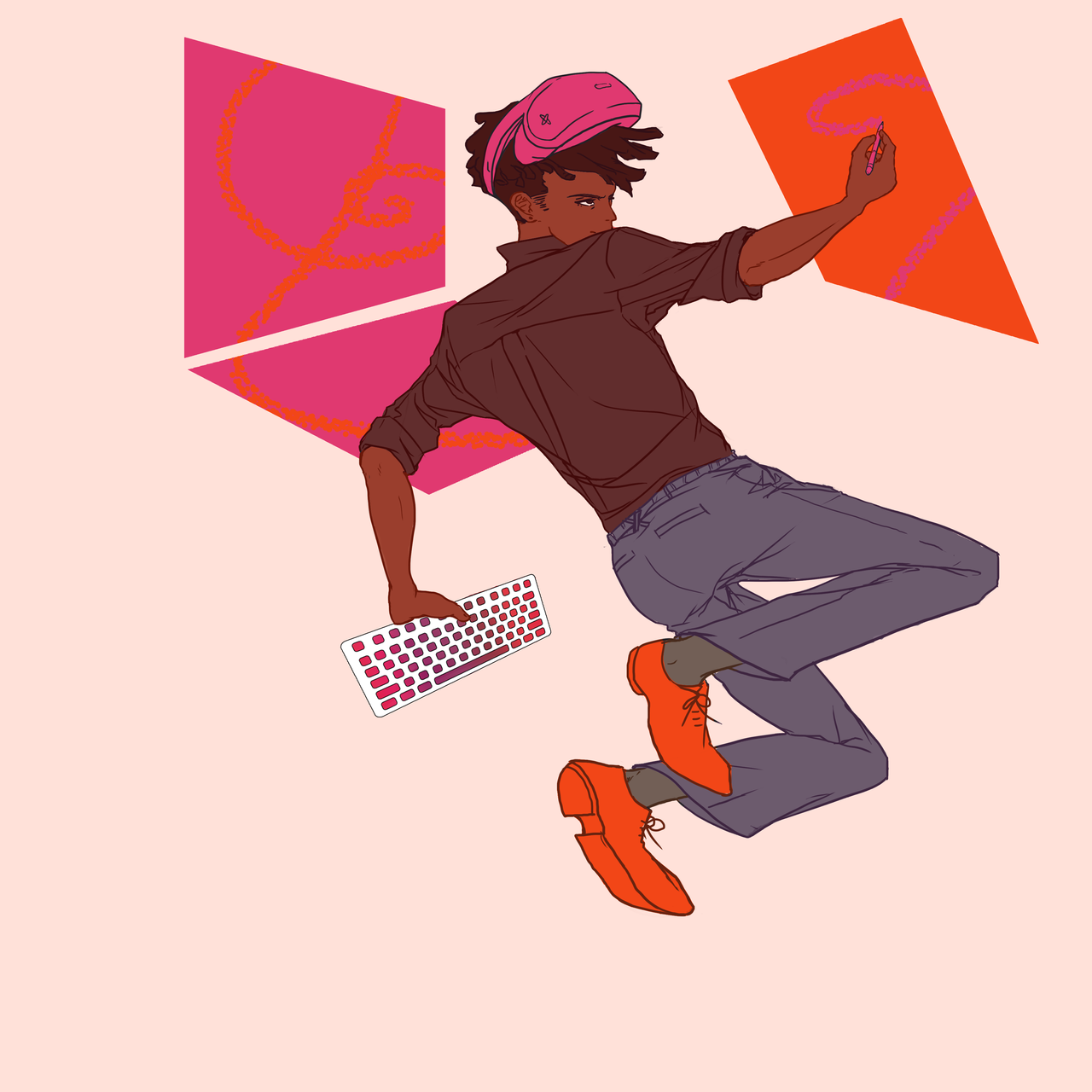
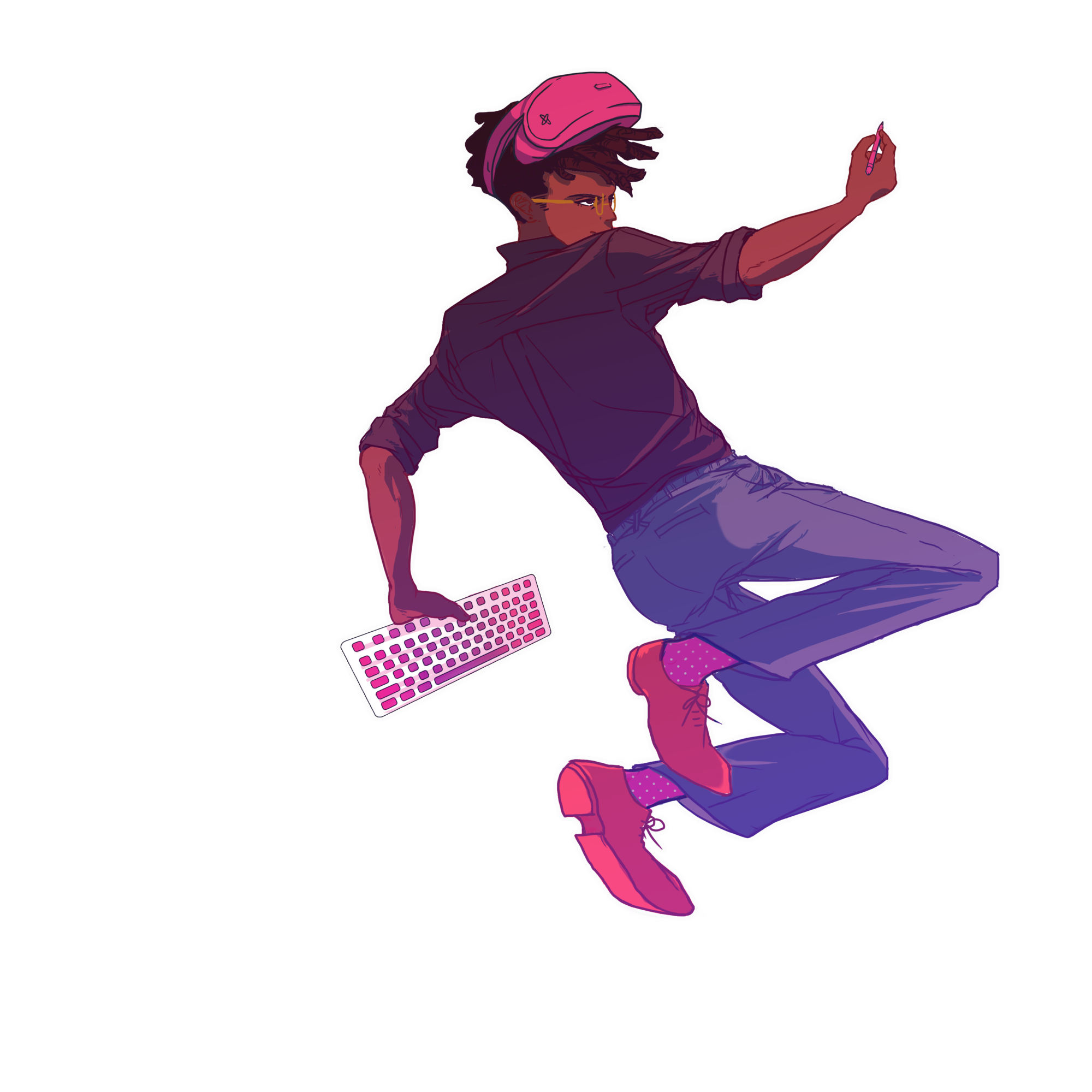
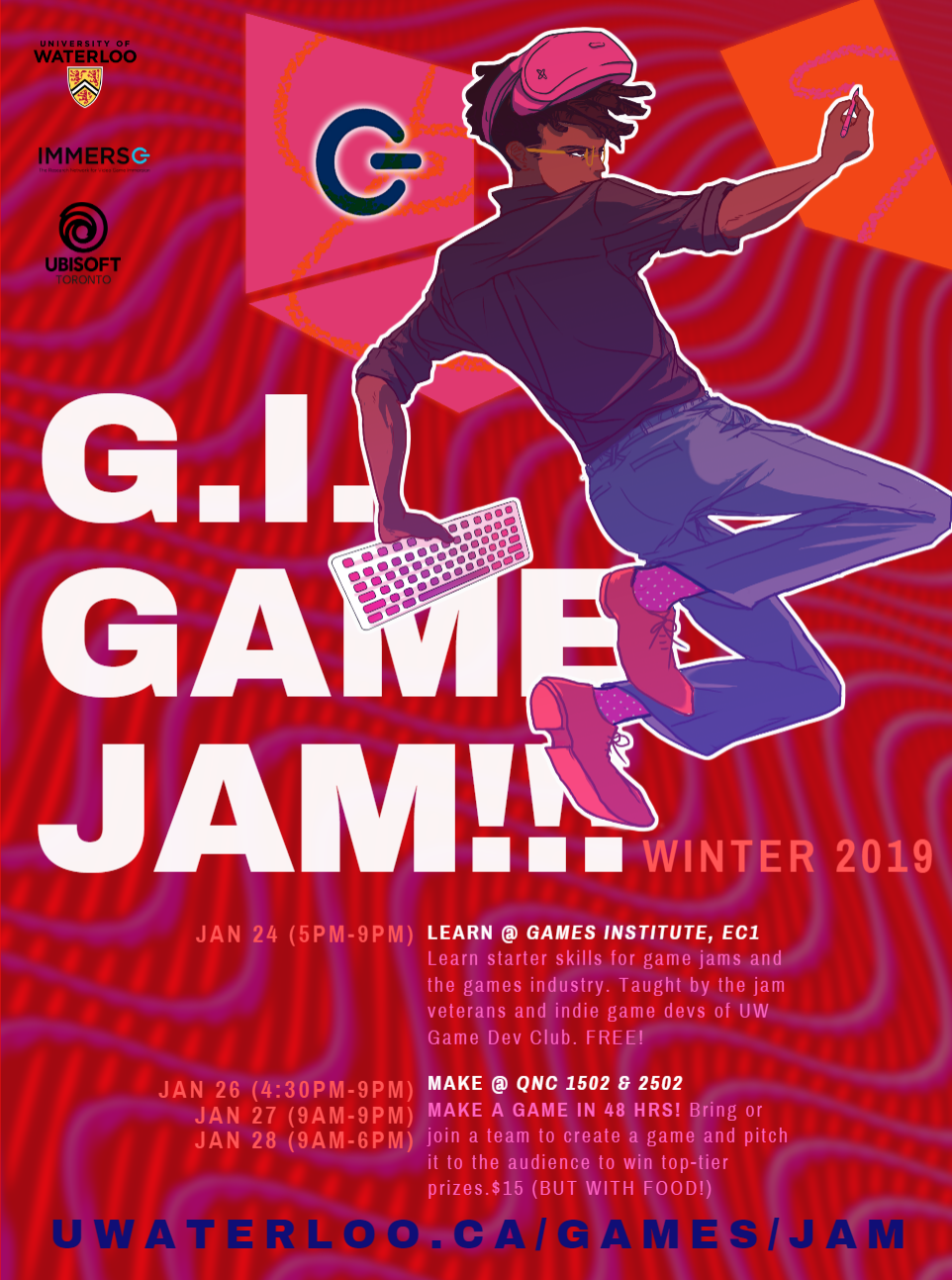
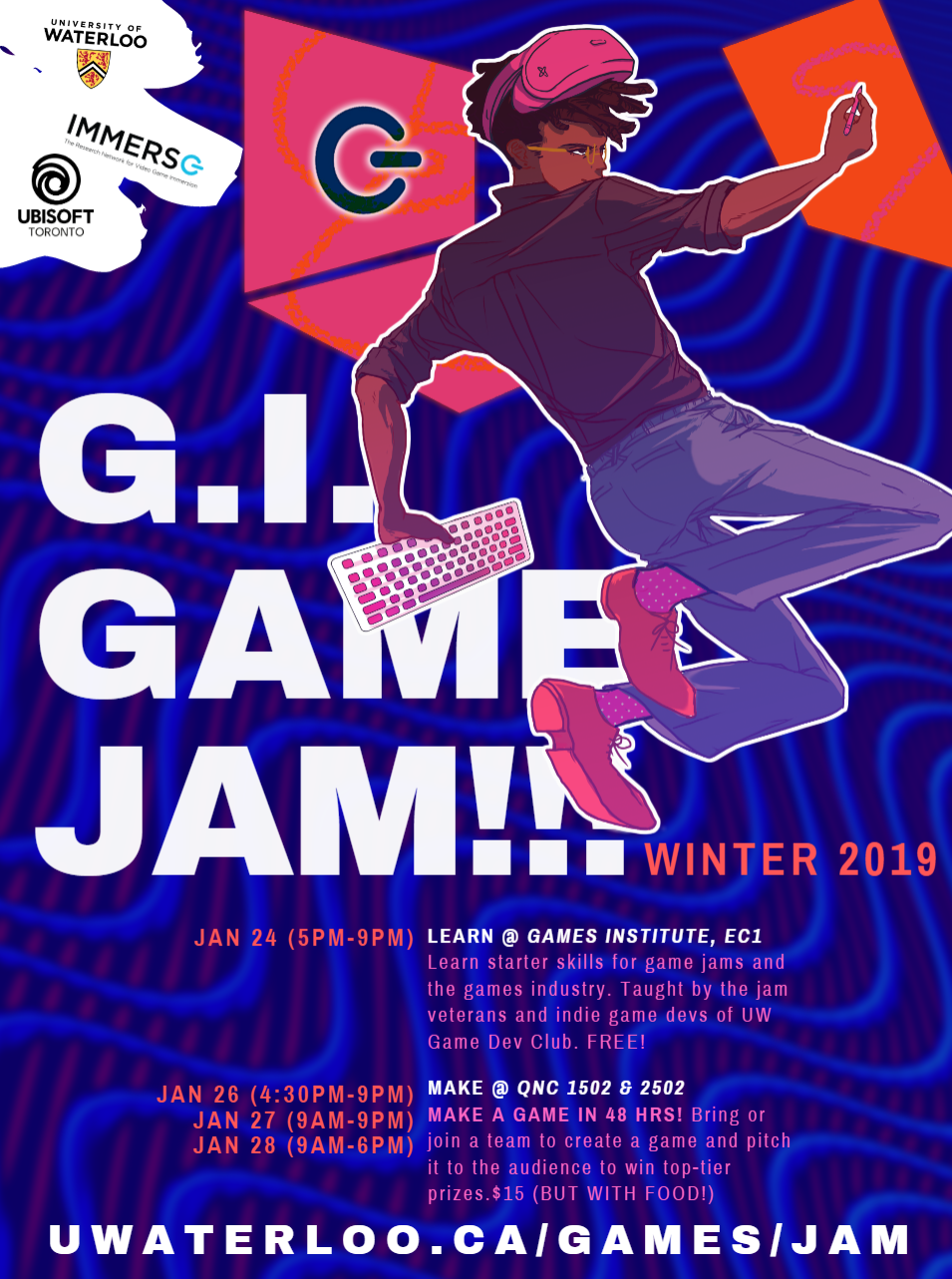

The colour palette was inspired by Into the Spiderverse, a popular film at the time of event recruitment. Feedback was concerned about the legibility of the small descriptive text over a heavily patterned background as well as the need to add more sponsors later on.
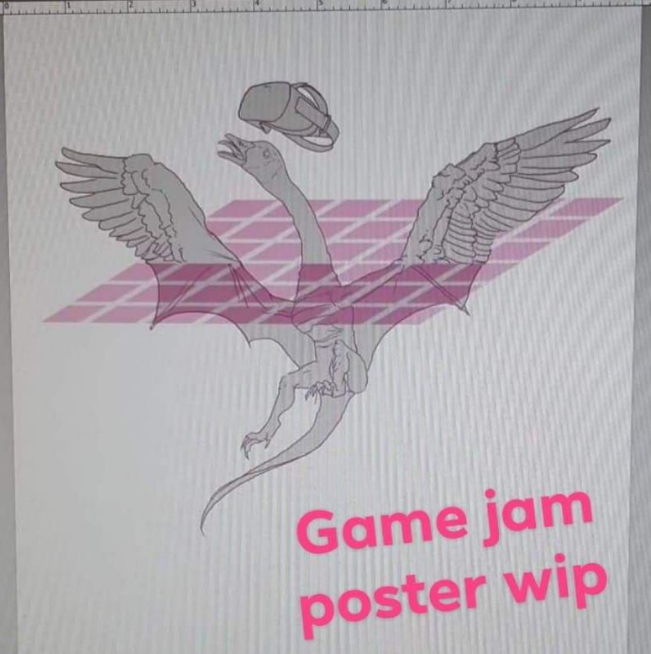
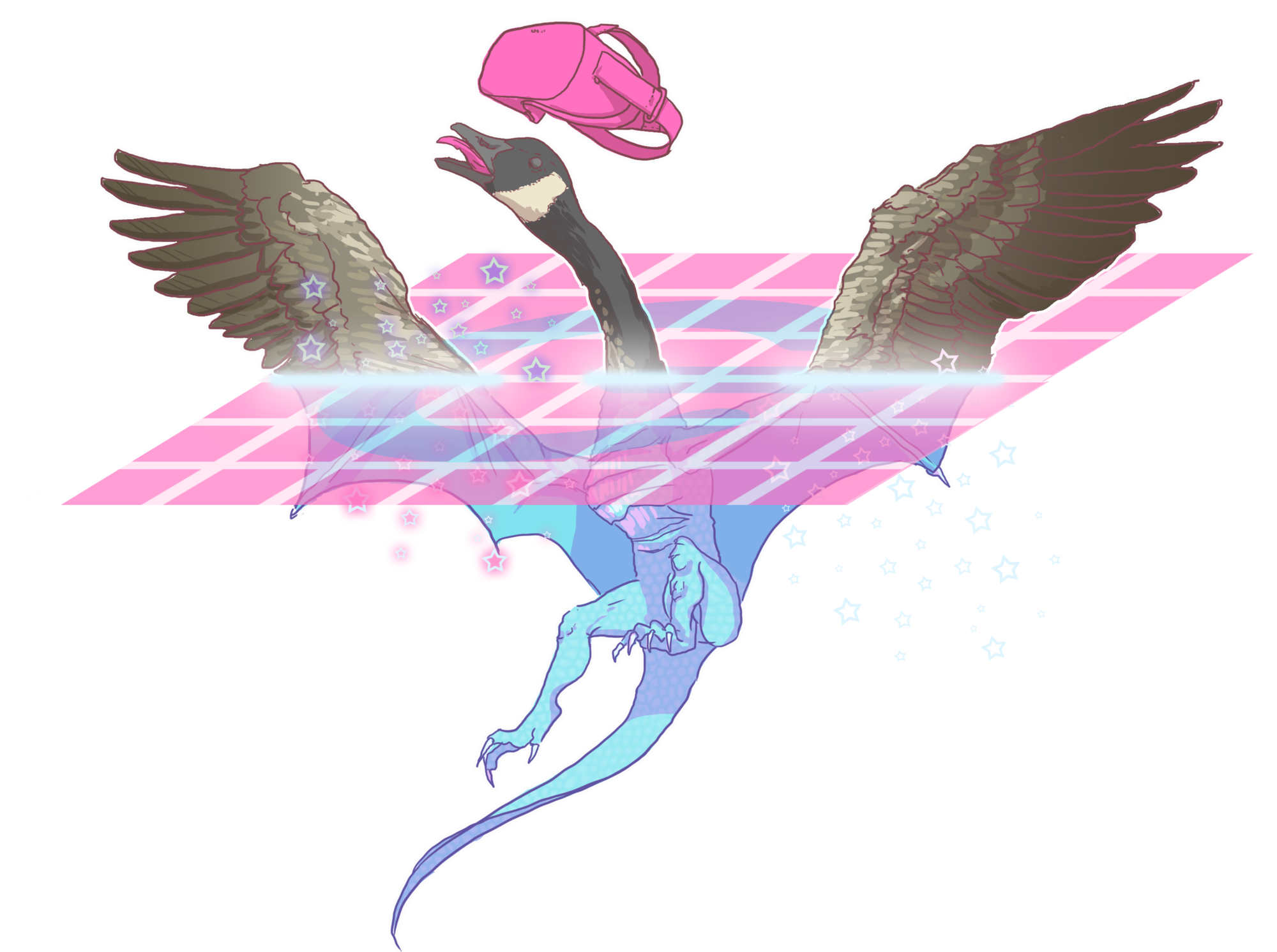
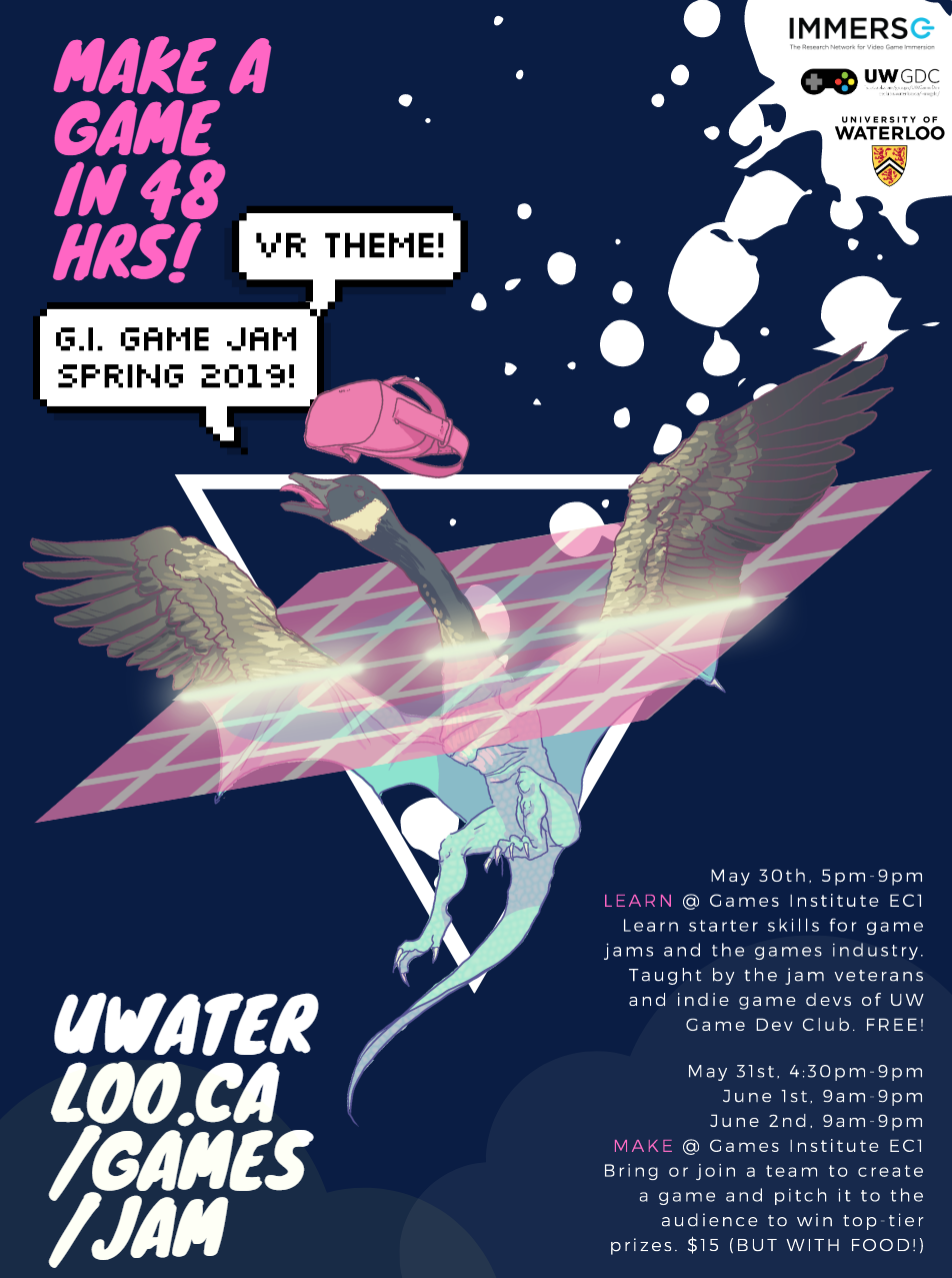
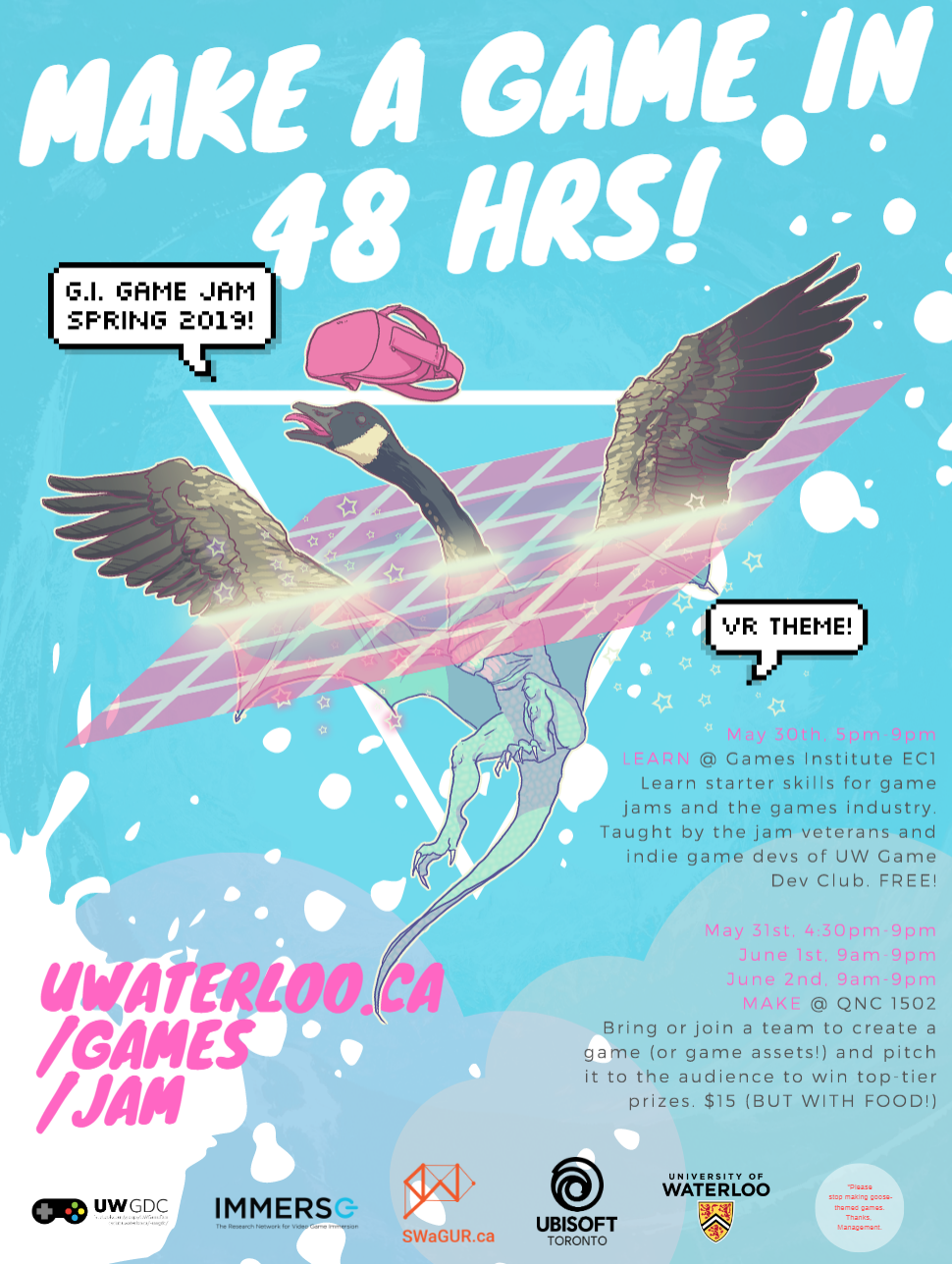

Inspired by recent jokes about overpopulation of Canadian Geese in the Region of Waterloo, Ontario. The theme that term was VR and I wanted to depict VR in a comedic way to reduce intimidation to newcomers.
Although this project encouraged experimenting with designs, I would have liked to have standardized a poster layout (e.g. URL location, title position) to be reused. This choice would have sped up design work, built a more consistent brand, and sped up poster-making for future GI Game Jam teams if design talent was unavailable.
Since this project I have also become much better at design principles such as fonts and composition, if I were to re-do them, I would have improved the focal points and flow of items.

My team Roze, later renamed Roze Labs, were the overall winners of the Hack4Health (H4H) 2.0 hackathon, hosted by MAREP at the Conrad School of Entrepreneurship at the University of Waterloo. We designed and secured funding for a tool for young women newly diagnosed with Multiple Sclerosis (MS).
NOV 2016 - FEB 2018
As a researcher, I reviewed literature, and contributed to grants and ethics applications for research after the hackathon.
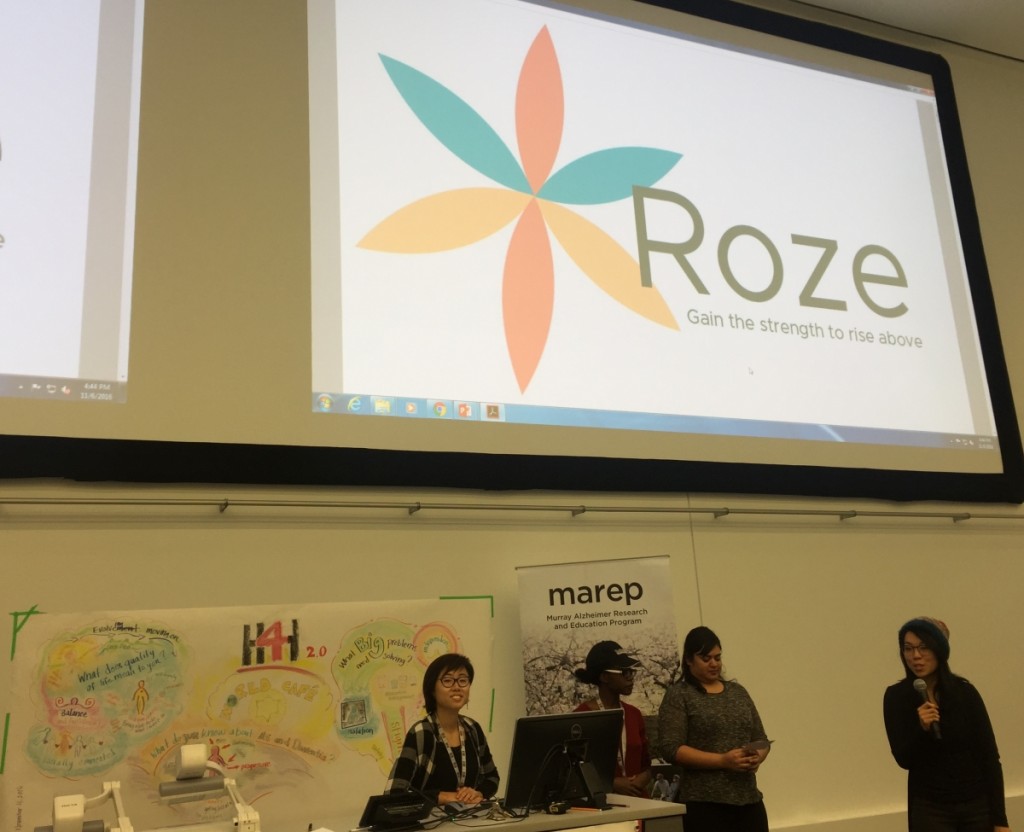
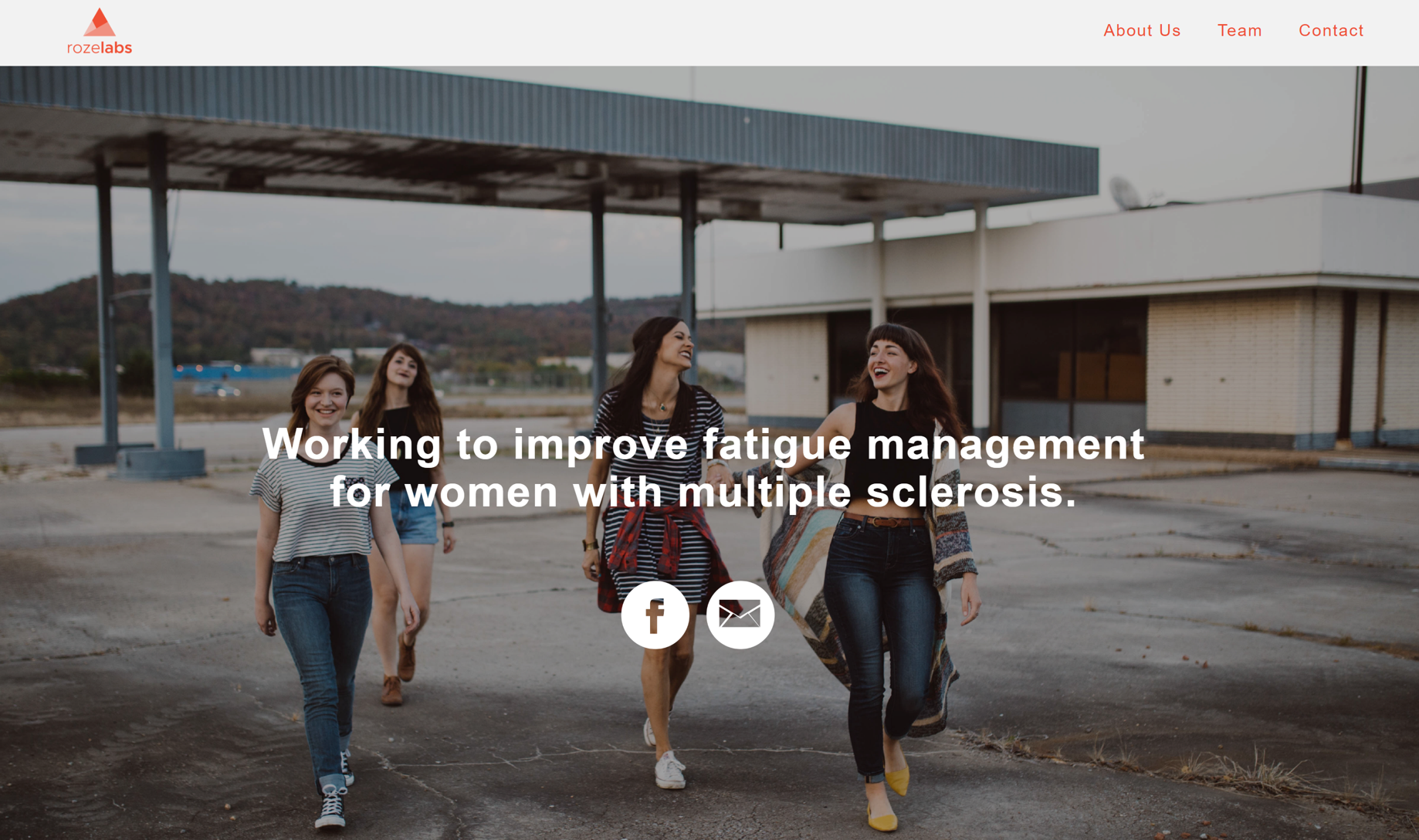
Marium Kirmani: UX Design
Rui Su: Clinical Expert
Lori-Ann Williams: Web Development
We returned to literature research to find MS had its highest prevalence in women, with the common age of onset between 25-35 years. For the duration of the hackathon we chose to focus on designing a product which can motivate young women recently diagnosed with MS to manage their fatigue.
Her goals:
Her frustrations:
In considering the persona, we decided the app needed to:




My team member Marium Kirmani created the above mock-ups for our 3 minute pitch showing the partial user flow after group discussion. The name Roze alludes to the feminine name 'Rose', as well as the past tense of rise.
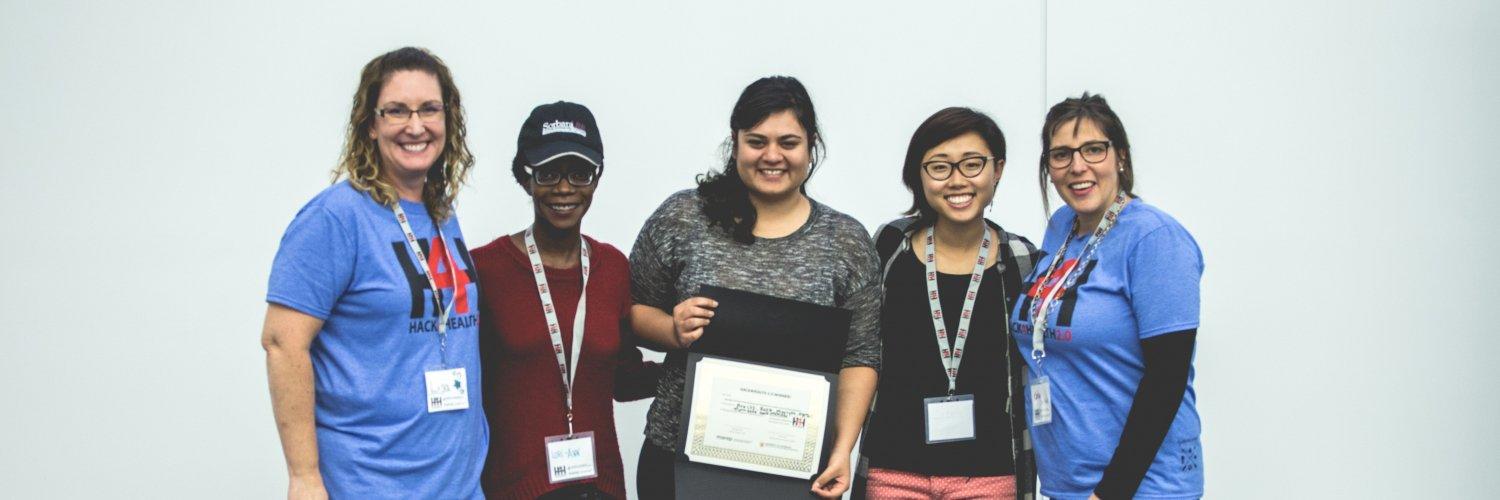
Team photo (minus myself) with Dr. Lisa Loiselle (left) and Dr. Karla Boluk (right).
Following our win, we were given the opportunity to apply for a MS Society grant of $15 000 which we were successful in receiving with Dr. Boluk as our PI. We recognized that Roze's concept was feasible yet it was important to further understand our end-user before designing a solution.
Between 2017-2018, a series of one-on-one interviews with MS experts and young women with MS were conducted after ethics approval with an ethics application lead by Rui and Marium as Roze Labs who wished to take the project further as a entrepreneurial endeavour. At this point, I was no longer actively involved but provided consultation in an advisory role given my qualitative research experience. Results were shared at the MS Society September 2018 in Calgary by Rui and Marium, showing the systemic challenges facing young women with MS, while healthcare professionals acknowledged the need for more holistic tools for patients with MS.
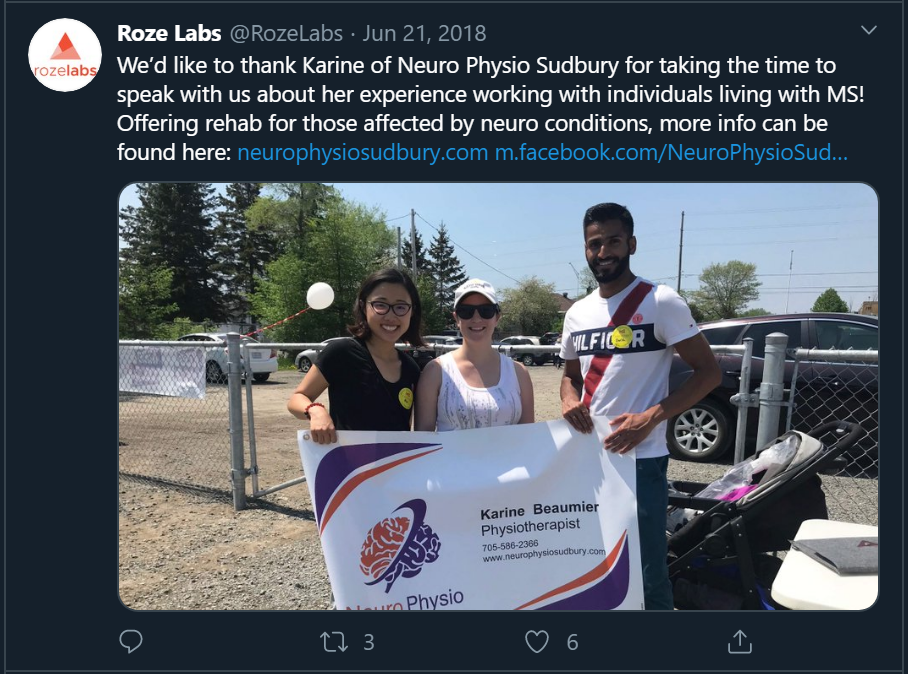
The Roze Labs project delivered:
The technology use patterns of women with MS should be adequately explored independent of MS. In retrospect, inclusion of questions about attitudes towards technology in the interviews would have portrayed the MS patients as individuals beyond MS and could have revealed novel patterns worthwhile to HCI research. We should have tested our assumptions that women with MS approach exercise differently than women without MS, women with other health conditions requiring regular visits with health professionals, or other genders.
I would have also looked for publishing opportunities outside of the health space as I see this project being a very interesting case study of co-creation in computer science.

5in5 Pharmacy was my first introduction to UX and gamification (interpreting works of B.J. Fogg). As a co-op student under Dr. Kelly Grindrod, I created an MVP based on contextual inquiry with community pharmacists. My role eventually evolved into content management. The project is now a webapp with over ten thousand pharmacy professionals registered and funded by the Ontario College of Pharmacists (OCP).
SEPT 2014 - MAY 2015
As a designer and developer, I created a functional MVP using Articulate Storyline for research based on pharmacist feedback and communicated with an app development firm and graphic designer.
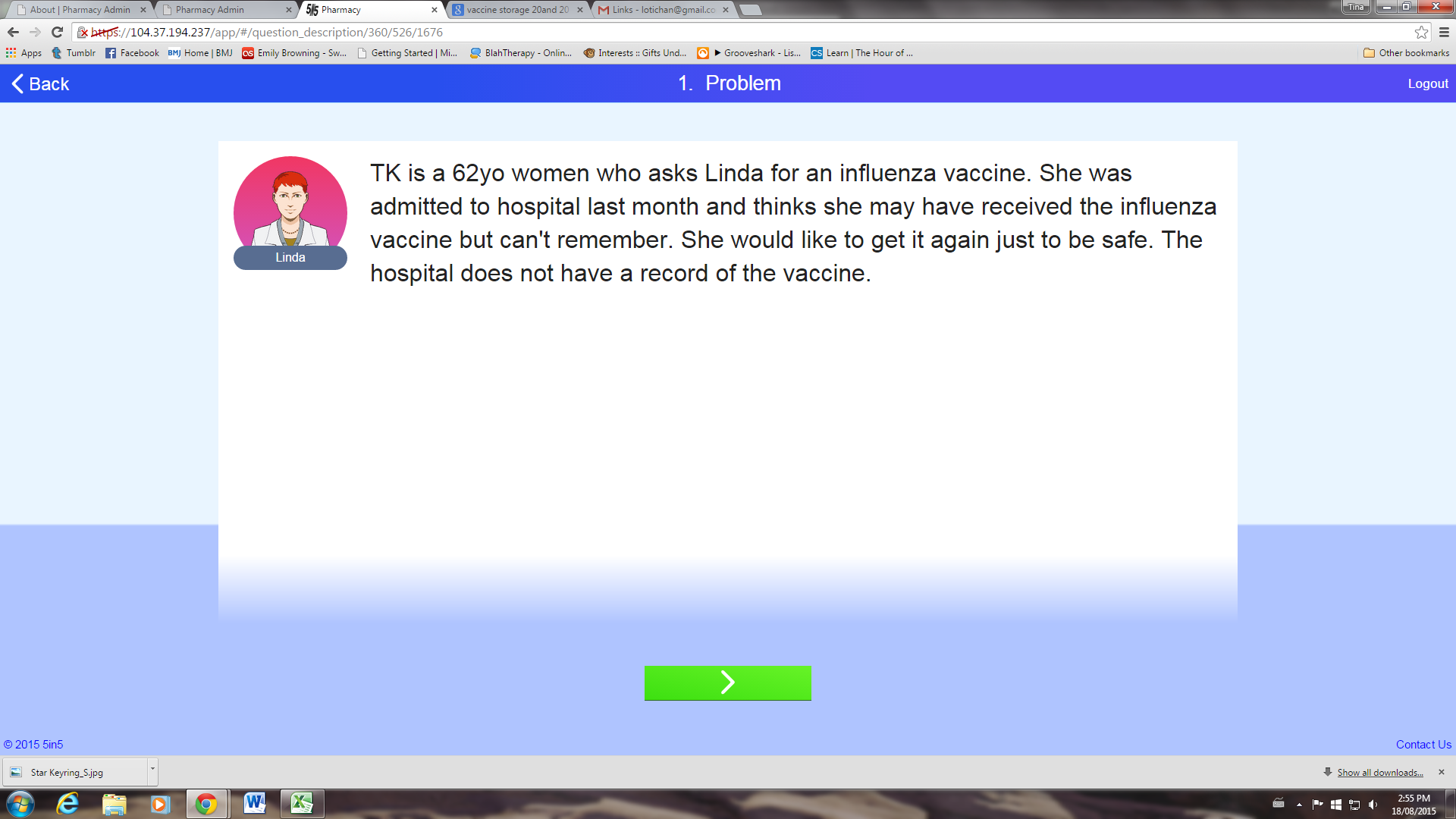
There was interest in exploring gamification to sustain the motivation of the pharmacist to use 5in5,
but further research was required to understand the needs and wants of practicing pharmacists.
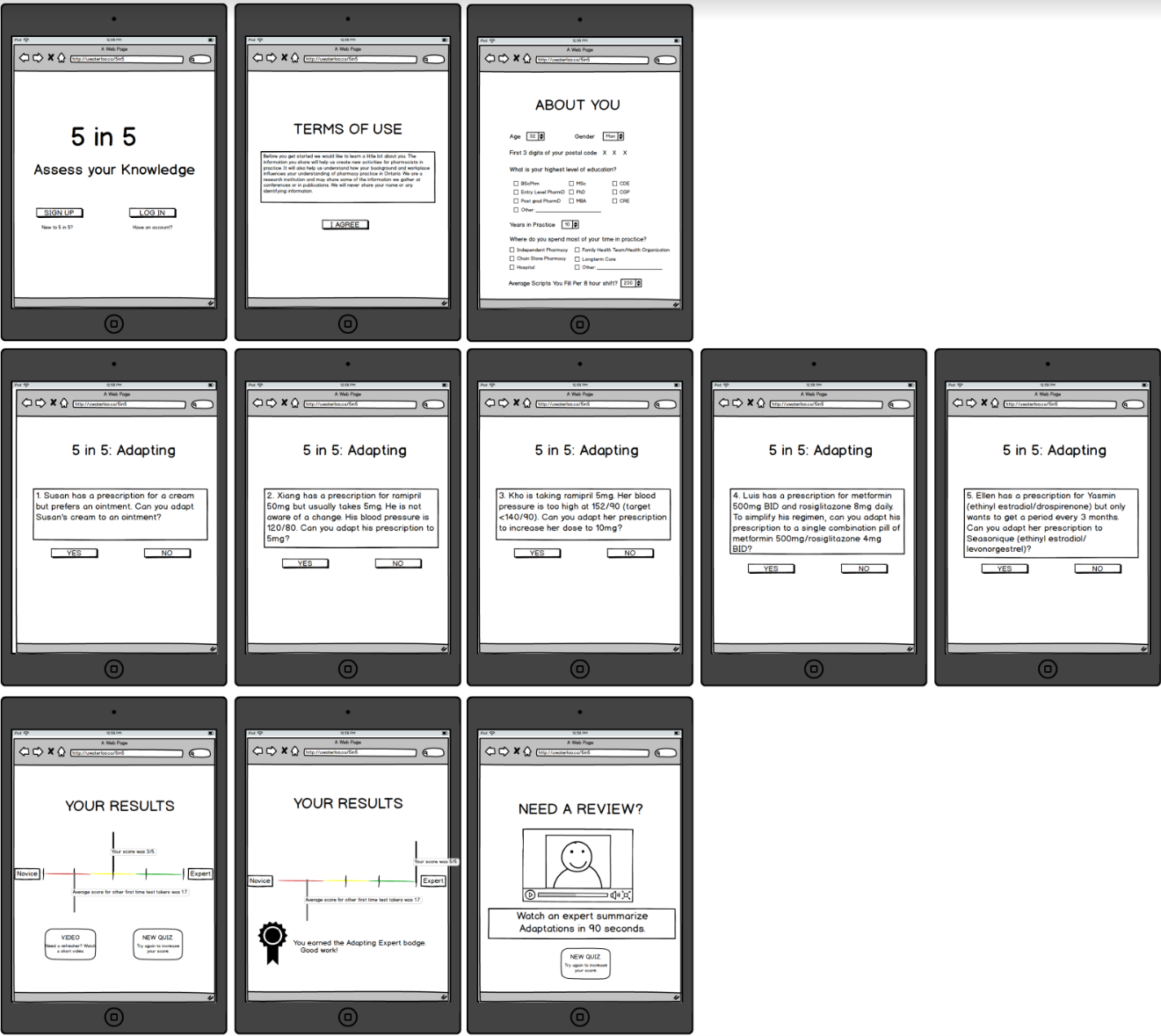
Wireframes created by Brad Jennings, a predecessor in my role.
In response to these observations, the following additions were added to the 5in5 design:
'Would Susan the competent pharmacist renew the blood pressure drug?'
'Would you?'
The pharmacist was encourage to question the conflict between their knowledge and actions.
User Experience Questionnaire (UEQ) was later used when the 5in5 tool was matured and hosted online by hired developers and tested by students at the School of Pharmacy. I was not as involved in the research at this stage but had processed the data for SPSS analyses.




The 5in5 app has improved since 2014 in visual design, but its use and user flow remains the same. Upon registration, the pharmacist would be led to a screen with activity options. The pharmacist can then complete quizzes and contribute feedback to improve the tool with other pharmacists.
When Monolith tookover the 5in5 tool's development, my role shifted to content creation by reviewing modules created by pharmacy educators with community pharmacists. I set up content management systems which tracked reviewers, contributors, and testers.
However, a large part of the role included testing and using a content management system developed by Monolith Interactive. In use, I discovered usability improvements such as:
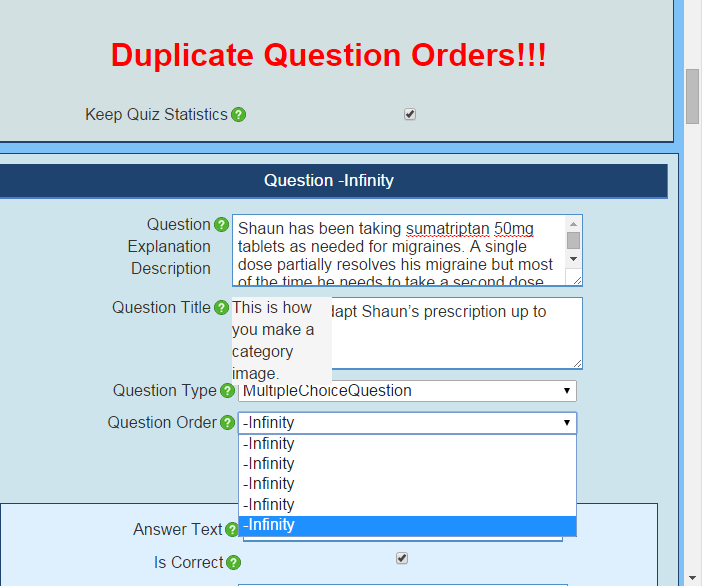
The question management system would often have errors from early development. The above shows errors in ordrring from a drop-down list.
The 5in5 app has since resulted in published studies based on the activity of its current users.
I have improved drastically in leadership and technical skills since 2014. One regret was to not have taken a more active role in development once the project was handed off to Monolith and have had missed out on a learning opportunity.
With my experience today, if I were to re-approach this project, I would have prioritized content management systems in discussions with Monolith. We had conducted a series of user tests with the consumer-side of the tool, but neglected to engineer a process for content curation. For example, the process of how an identified need in education would turn into questions, then reviewed by professionals, and then uploaded with the least developer support possible.

Journaly is an electronic diary for persons with bi-polar disorder which uses sentiment analysis to score daily entries to visualize a whole week's mood during therapy appointments. Stylized as 'Journaly.ai,' Journaly won the $5000 top prize from the 2019 Hack 4 Good: AI Hackathon in Whitby, Ontario.
MAR 2019
I also used my background in public health to consult the app design, such as ensuring accuracy of representation and finding its fit in the consumer's workflow.
Marvin Pafla: Backend Development
Kenny Fung: Frontend Development
Andrew Cen: UX design
Joanna L.: Literature Review
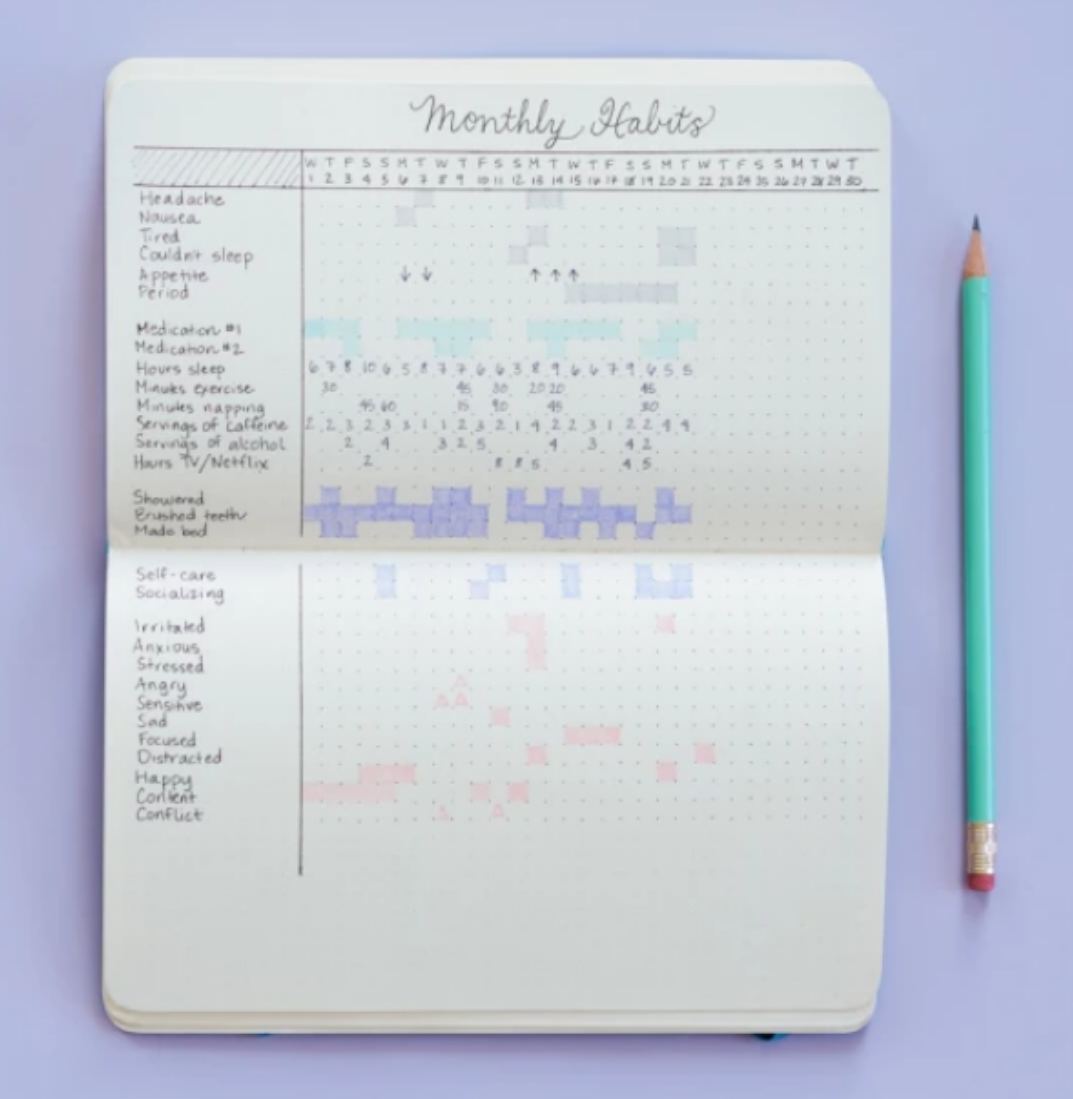
Example of a mood tracking bullet journal.
The app's user flow as well as how Journaly would fit into existing workflows of therapists and their clients was considered using a systems approach.
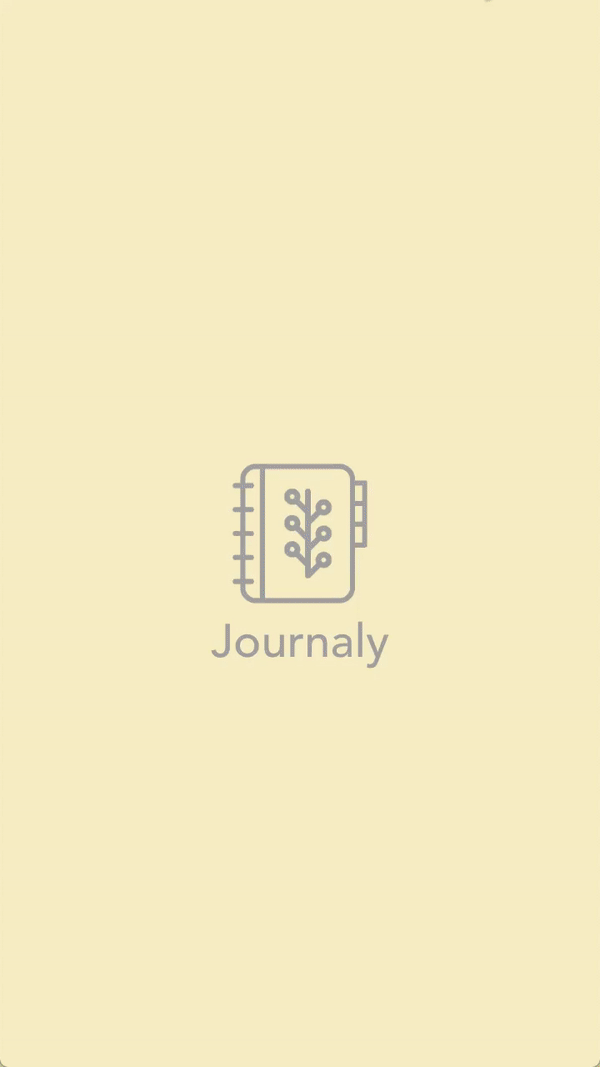
UI design demonstrating user flow created by my team member Andrew Cen who was leading UX design.
Upon login the user would:
During the appointment:
If given more time our team would have looked for a more appropriate dataset than movie reviews to train the AI. It would have also been aspirational to incorporate computer vision to convert diaries on paper to text for analysis. A self-report override for mood logging would also be helpful to improve accuracy.

Privehealth is an early startup which provided 'Gamified cybersecurity training for the health professional.' I served on their advisory board in 2019 applying my experience in gamification and entrepreneurship. In this voluntary role, I advised interviews with health professionals to identify current gaps in cybersecurity training and connected Privehealth to community stakeholders.
2018-2019
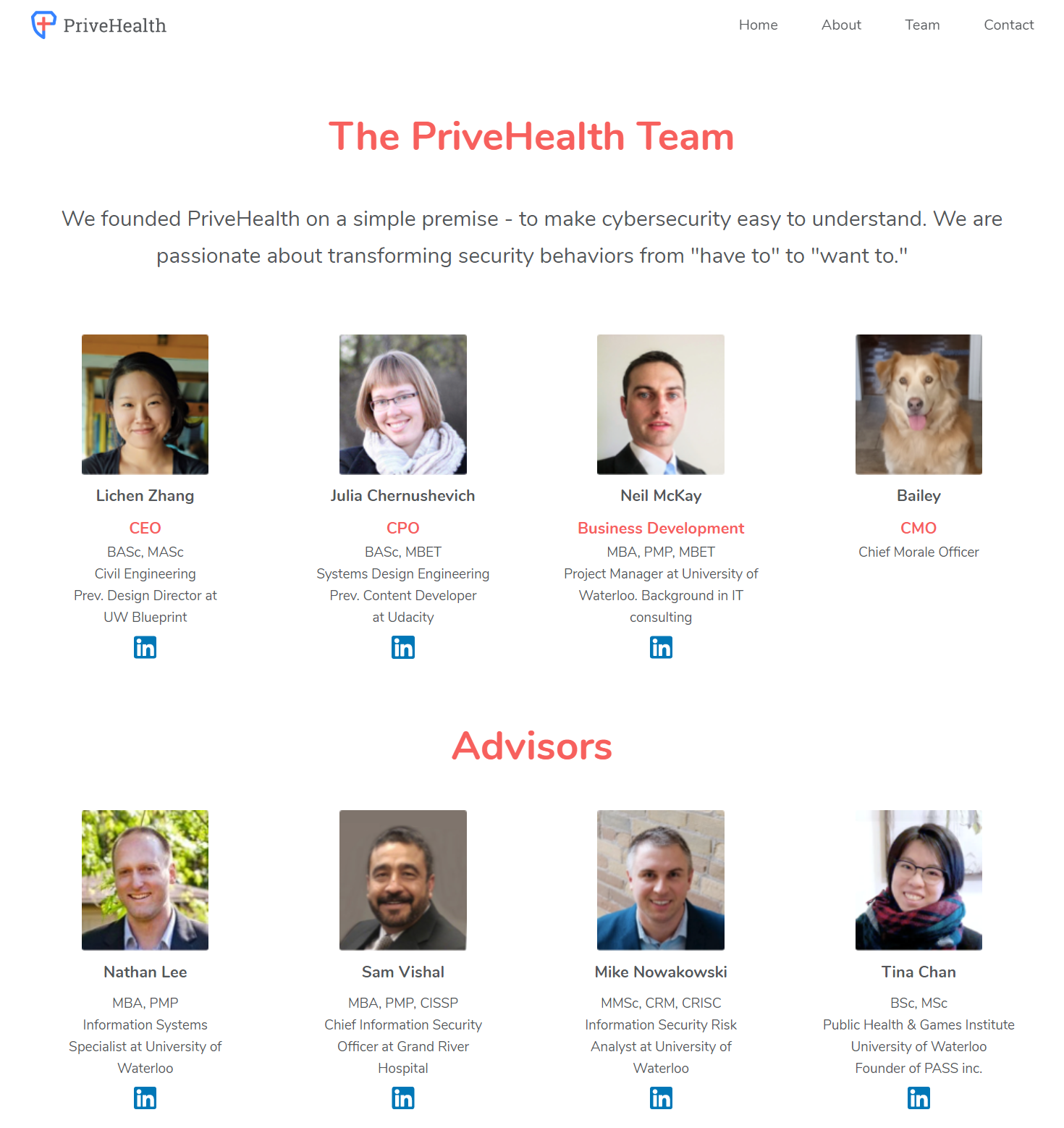
We approached healthcare professionals with semi-structured interviews which explored their perceived knowledge of cybersecurity, opinions towards existing cybersecurity tools, and their fears regarding information management. The interviews were both conducted at workplaces as well as in PriveHealth's office for professionals unable to invite us into their workplace. Video-recordings were taken with consent to take note of the body language of persons interviewed and provide context of their workspace.
The team has moved on to other endeavours but if PriveHealth wished to pivot, I would see value in becoming consultants to larger corporations and pursue intrapreneurship with employees through collaborations. Alternatively, PriveHealth could explore servicing smaller independent health providers (e.g. optometrists, counselling offices), or pivot further to teaching cybersecurity to non-traditional handlers of health data. With linkable data posing as threats to exposing individuals' health data, there may even be a market in creators of wellness e-commerce shop owners.

I contributed T-shirt designs for the student volunteers (SVs) at the 2018 ACM INTERACTIVE SURFACES AND SPACES (ISS) conference held in Tokyo.
NOV 2018
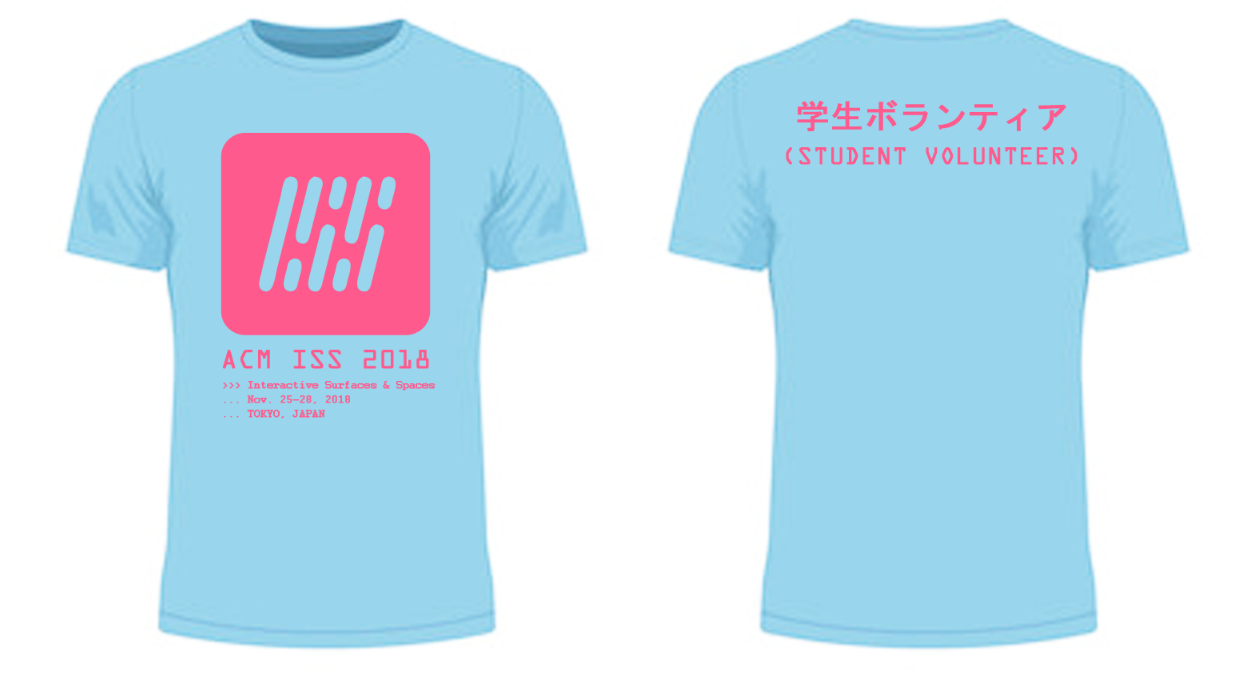
Bright colours unusual with locals in the financial district of Tokyo where the conference was held were chosen to allow SVs to be easily identified as SVs. Pink and blue were specifically chosen as they were the branding colours of the 2018 ISS conference.
'Student Volunteer' in both japanese (translated by Tokyo-based volunteers) and english were written on the back of shirts to commemorate the conference's location. Extra T-shirts without the 'Student Volunteer' print were printed to be sold to attendees as souvenirs at cost price.
In reflection, the choice of colours was not preferable for sale due to its deliberate harsh contrasts which some attendees disliked. It is advised that future T-shirt designs would ideally be appropriate for both volunteer use and sale to attendees. A balance could be reached between conference brand visibility and potential for daily wear post-conference when it comes to design.
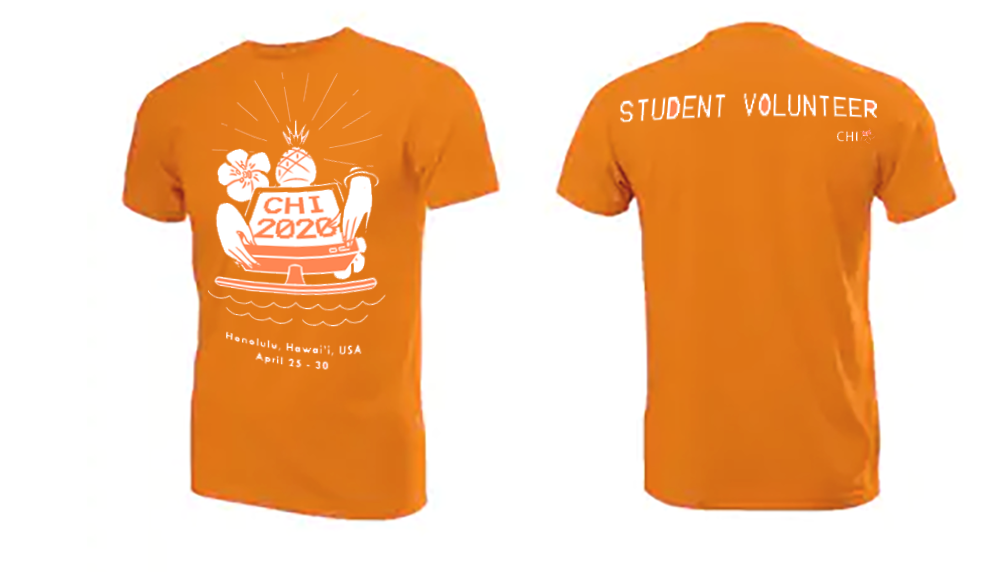
Given identified needs, I first familiarized myself with aspects of Hawaii unique to the region ranging from tourism to the arts. I chose to focus on the exports of Hawaii (pineapples, coconuts, flowers, sugarcane) due to their aesthetics being translatable to recognizable simple design and its international relevance.
The shirt was to foremost represent the conference's focus on Human-Computer Interaction (HCI), thus a desktop computer with the conference name was chosen as the main point. A pair of human hands framed the screen to emphasize the human aspect of HCI. Orange was chosen as the shirt base as it was one of the colours (the other being green) of the CHI 2020 logo.
In reflection of my previous SV shirt designs which served the purpose of SV visibility but were not preferable to daily wear post-conference, I decided to borrow from graphic design trends of late 2019 and used an astrology themed layout.

A clicker dress-up game released for Android created at the GI Game Jam. It currently has 100+ downloads on Google Play.
SEPT 2018
As a game developer I published Mr. Goose's Dressup on the Play Store with Google Play Console after modifying it to an appropriate .apk file in Unity.
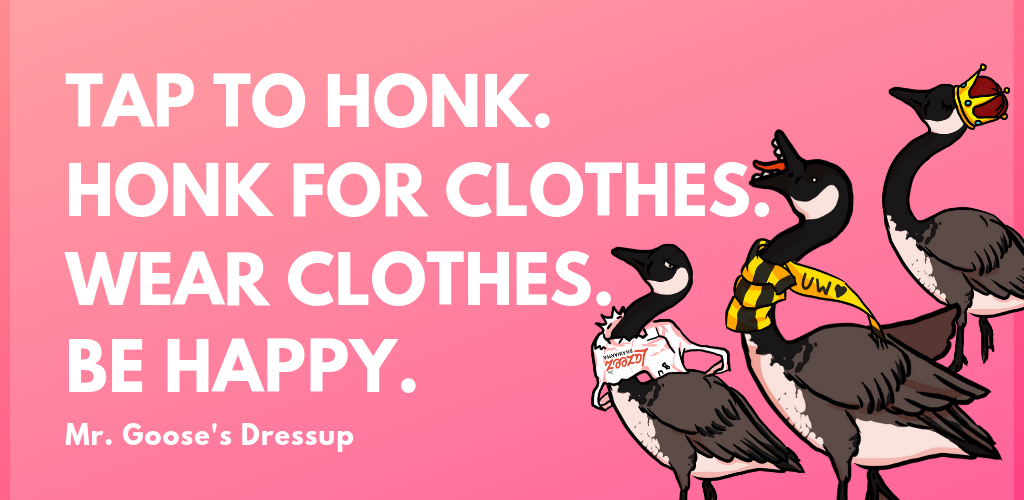
*Bonus: Goose-themed games were jokingly discouraged for the following GI game jam by organizers because of how 'annoying' Mr. Goose's Dressup was.

A two-player planet battle game made for one screen. It currently has 1000+ downloads on Google Play.
JAN 2019
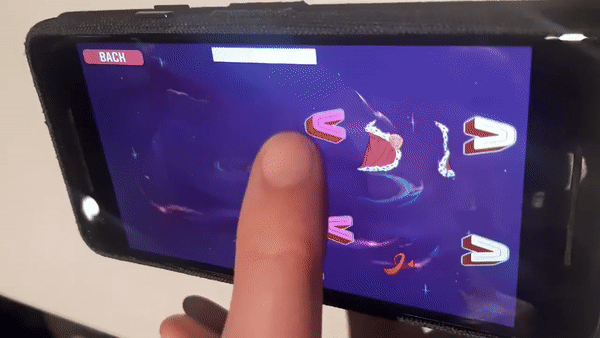
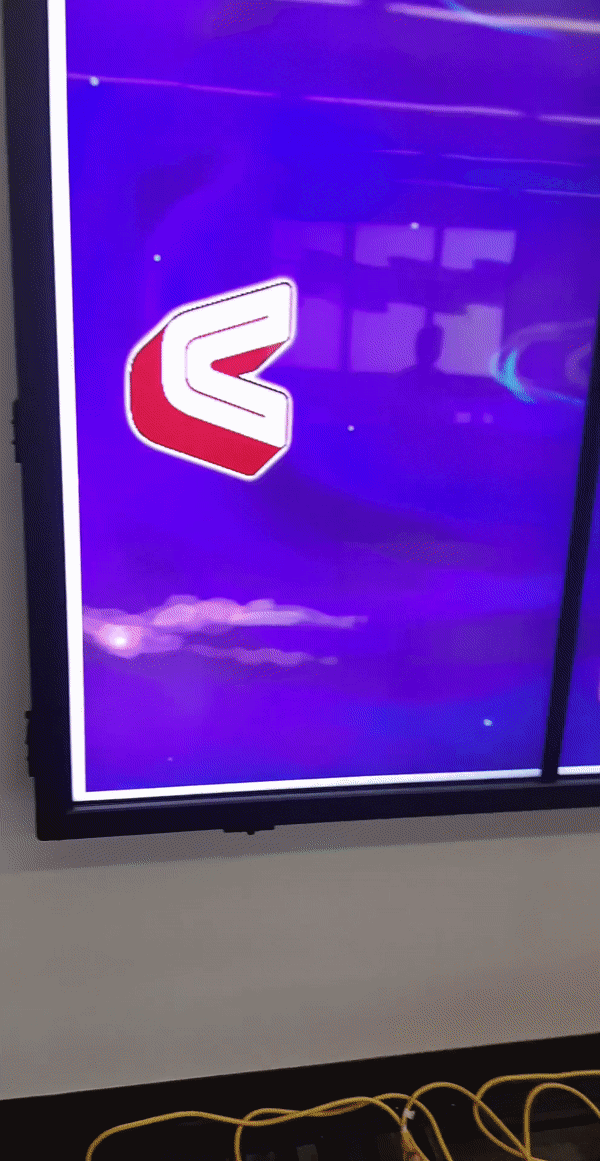
Seen Above: World Smash was originally made for phone screens, but it is also playable on large-screen displays.
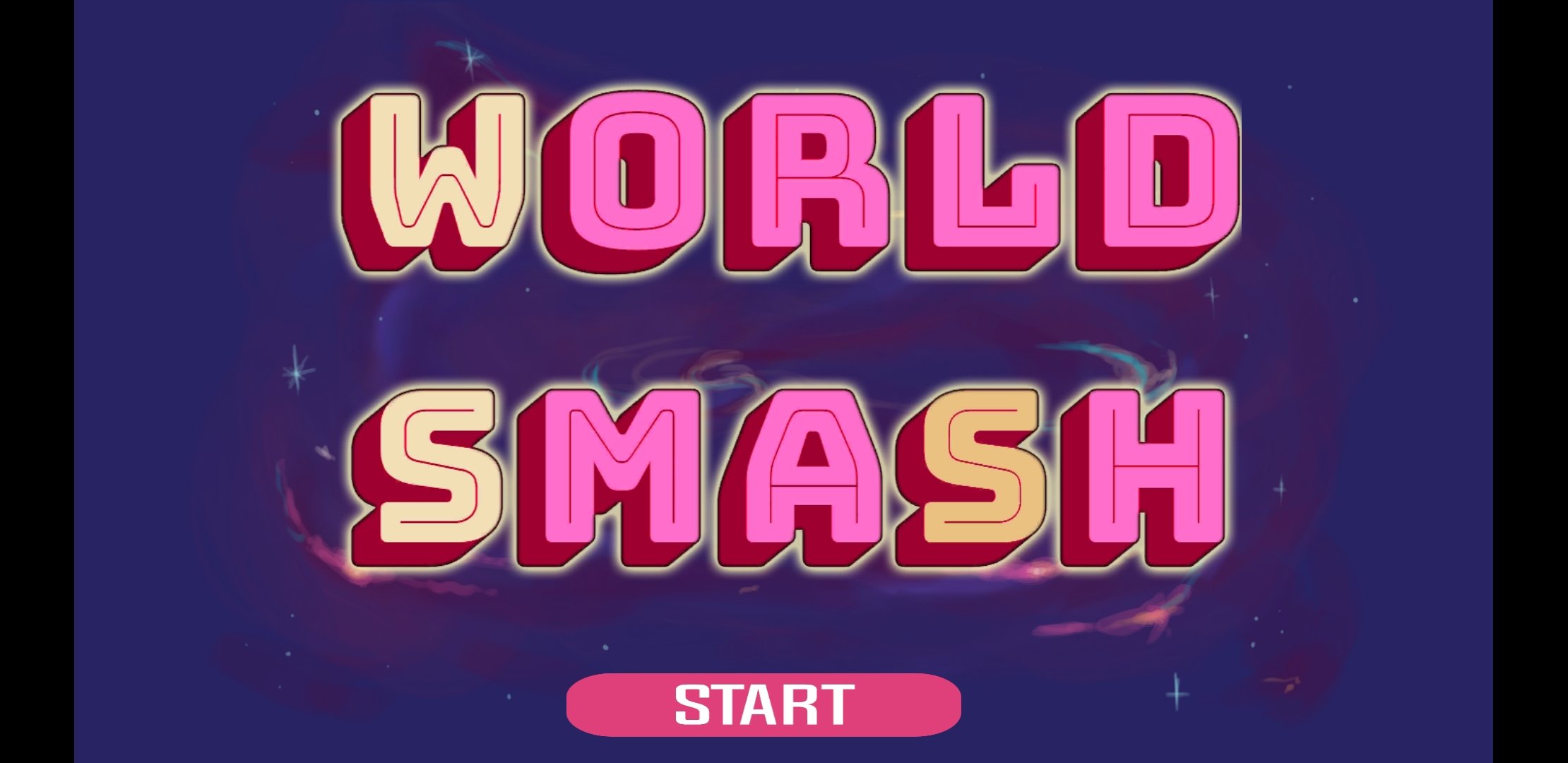
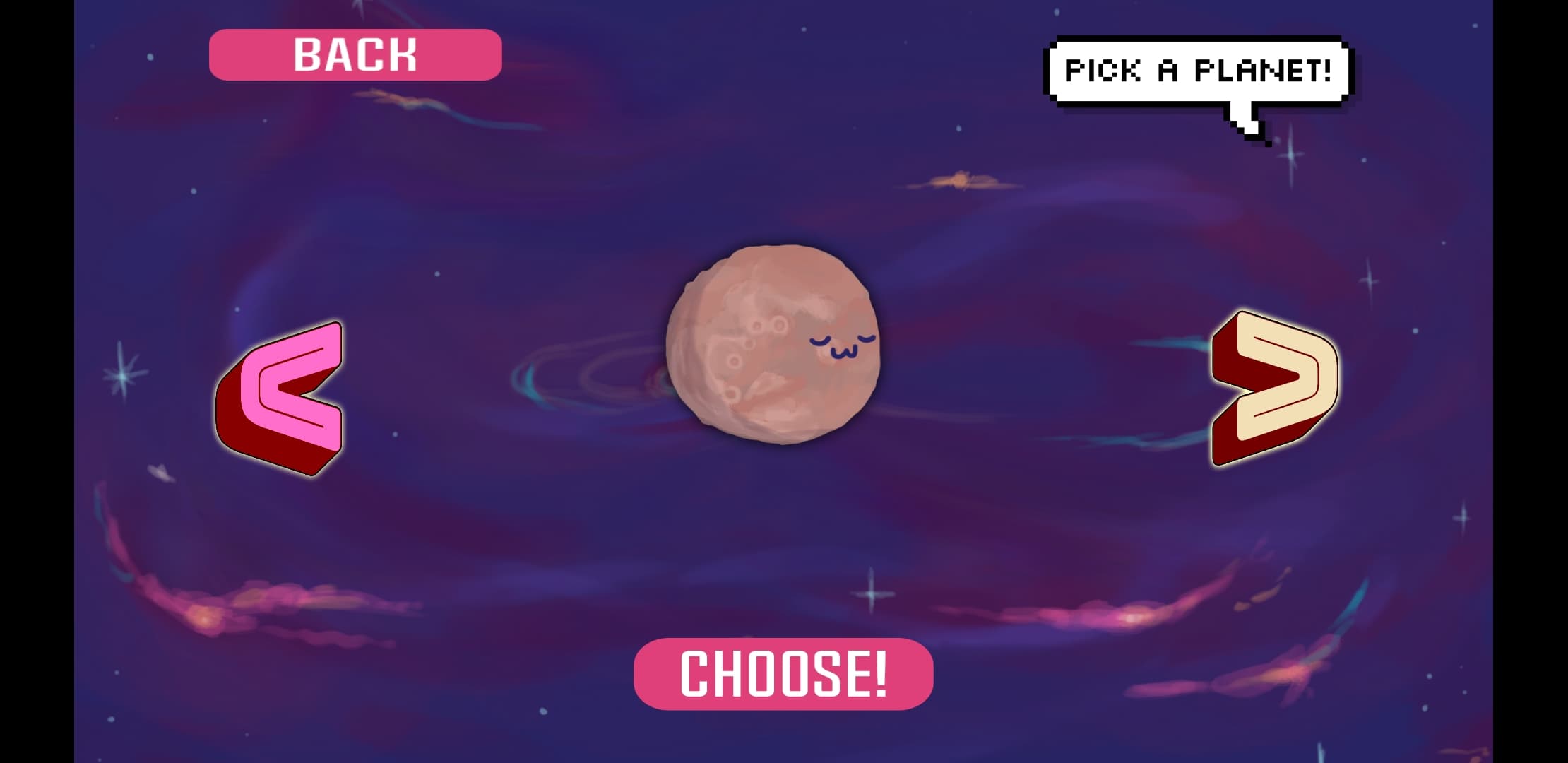
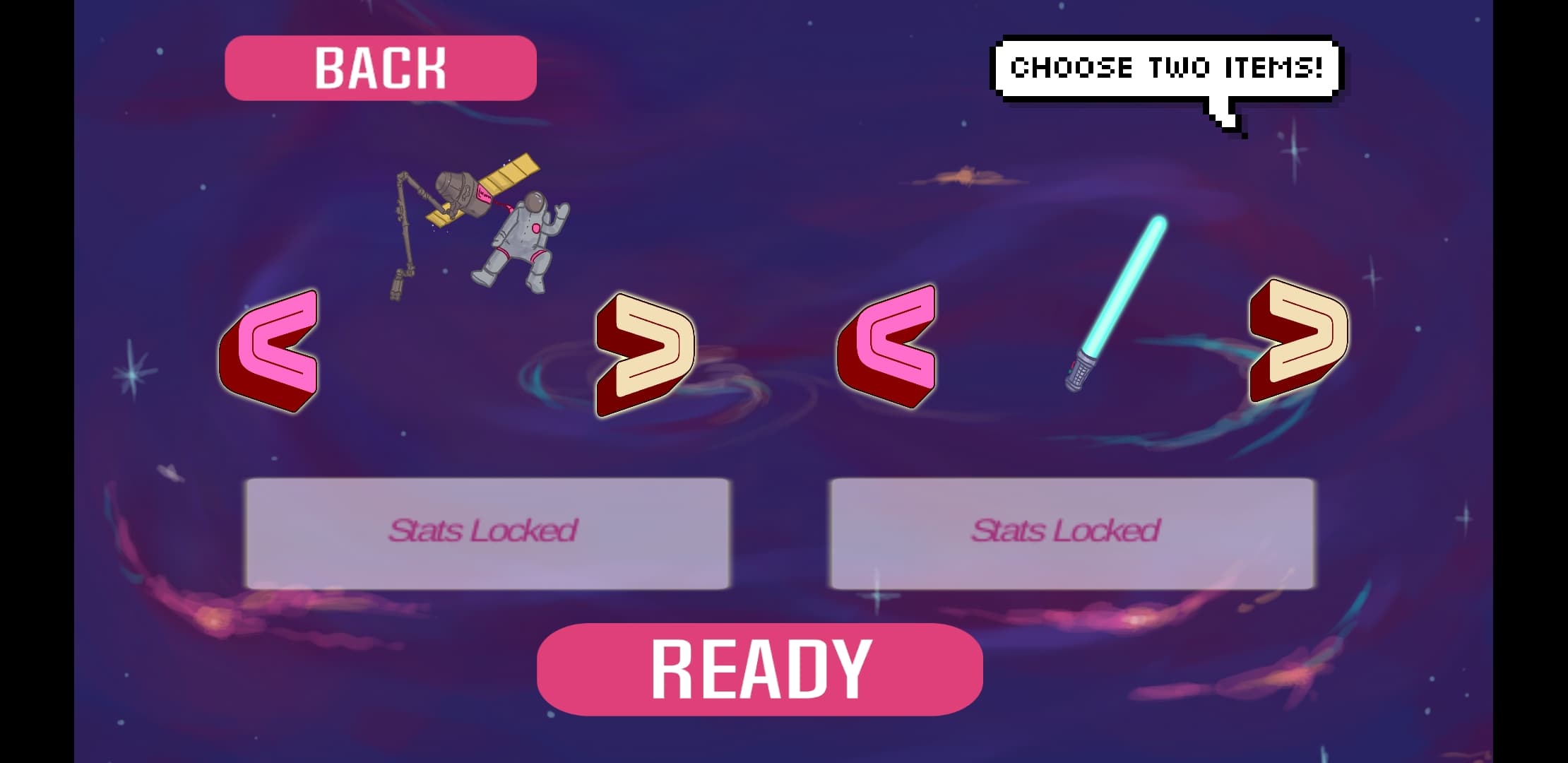
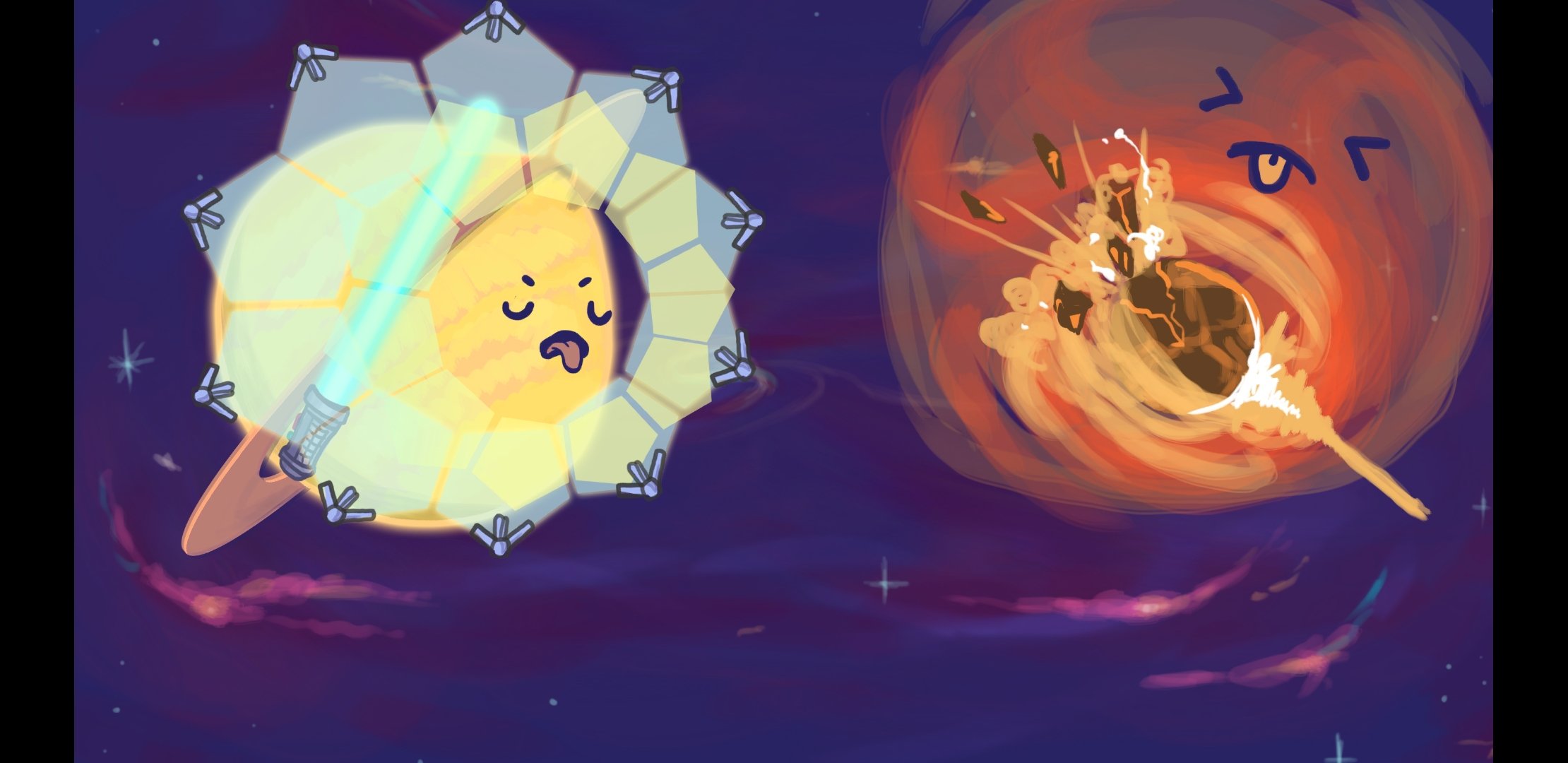
Tina (myself): Art
David Dufour, Phil Downey: Development
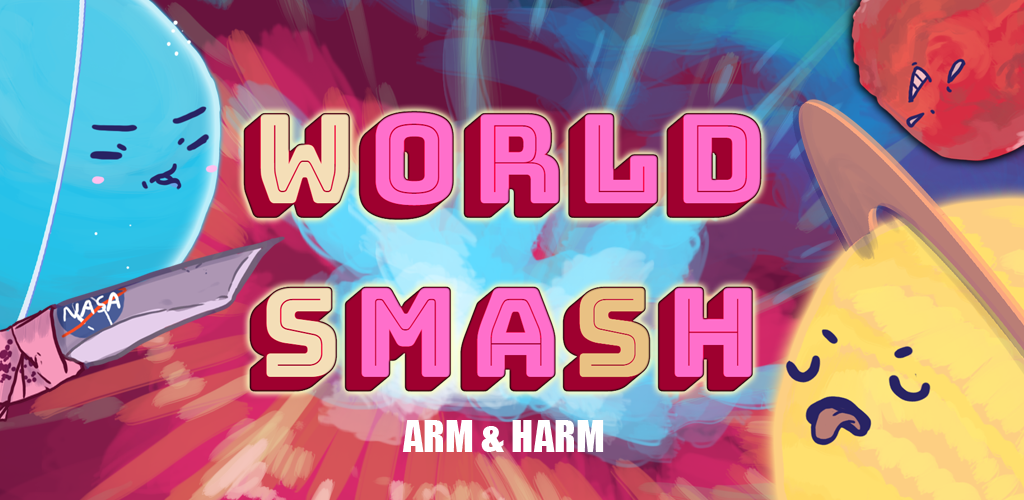
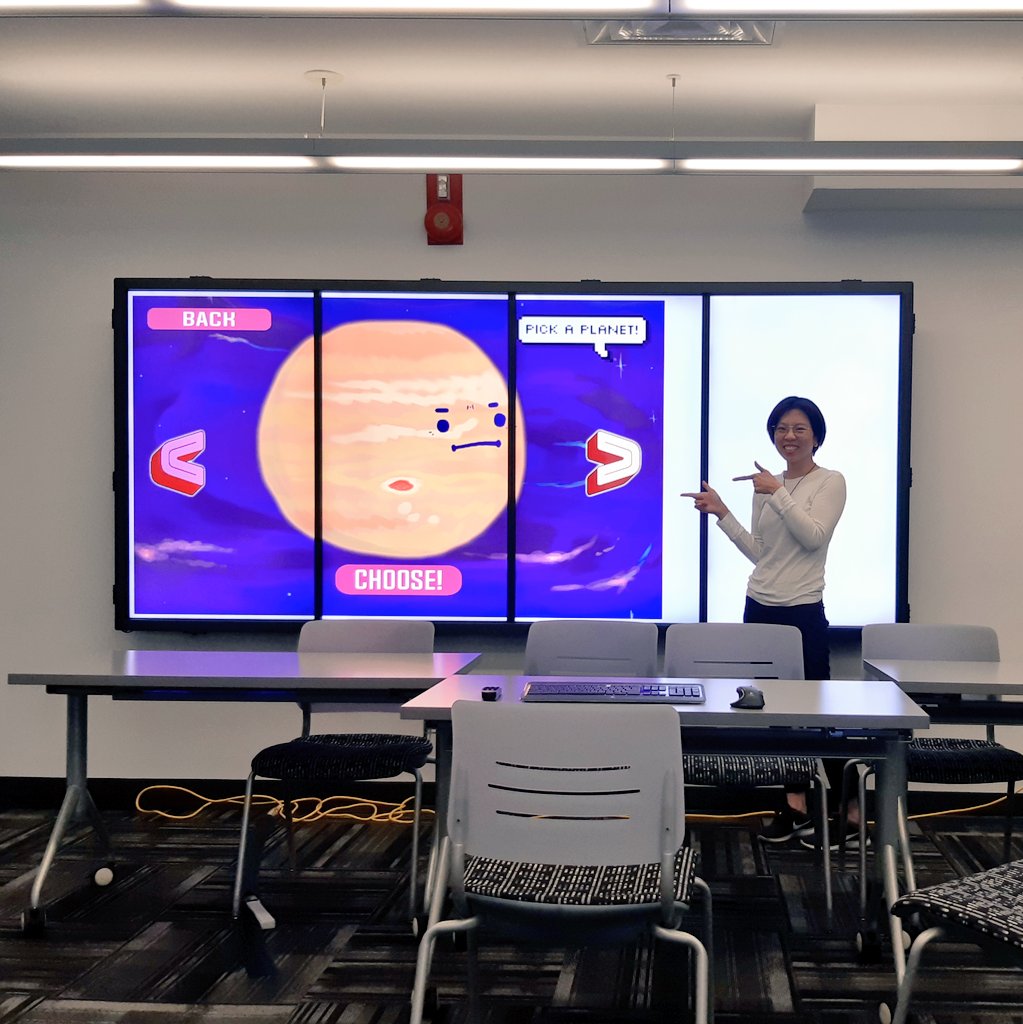
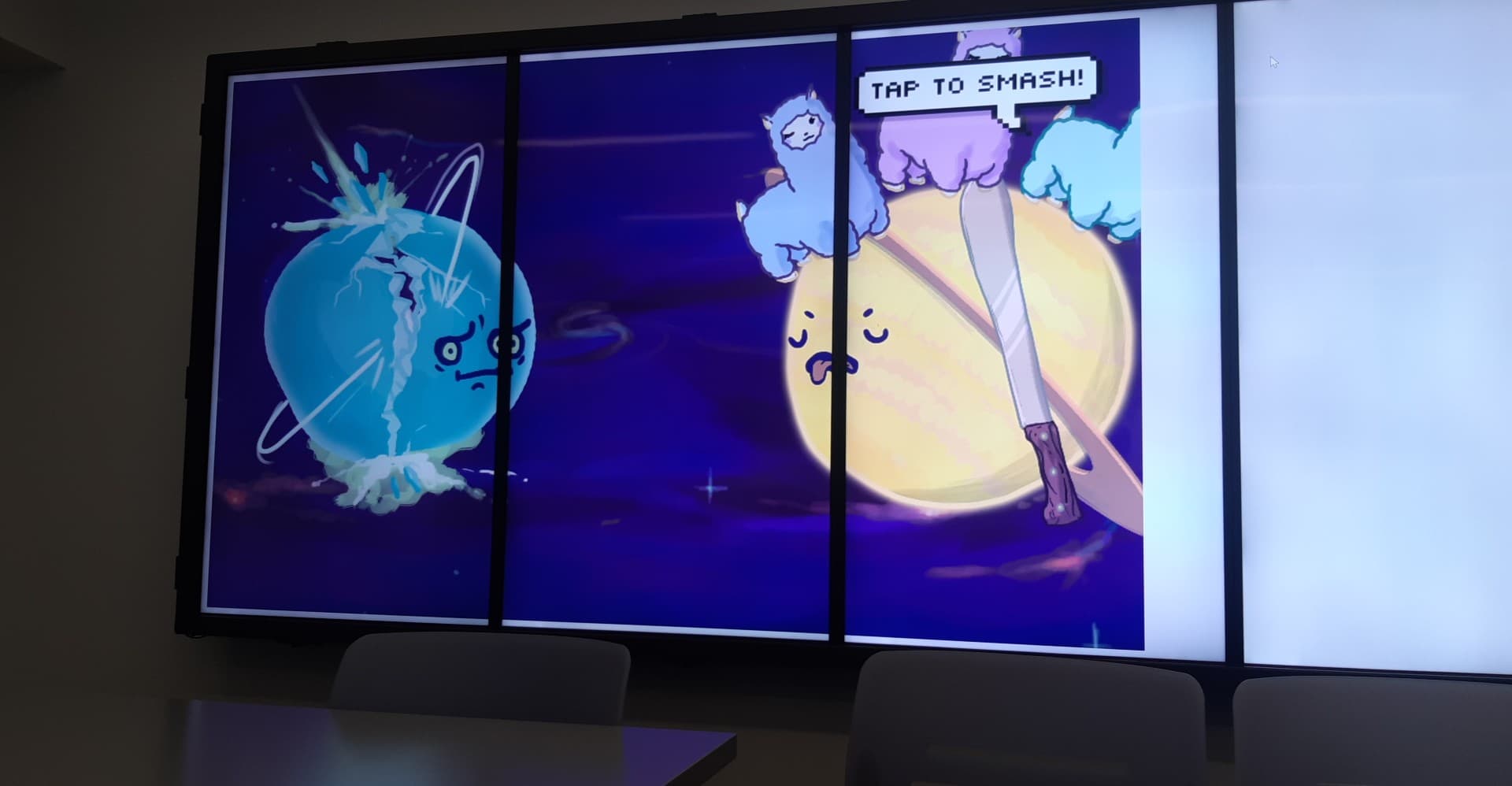
*Bonus: The game was tested for fun on large screen displays and was recognized as a potential study tool.

A side-scrolling beat em up on browser created in a team for the Global Game Jam 2020. Currently hosted on GitHub.
JAN 2020
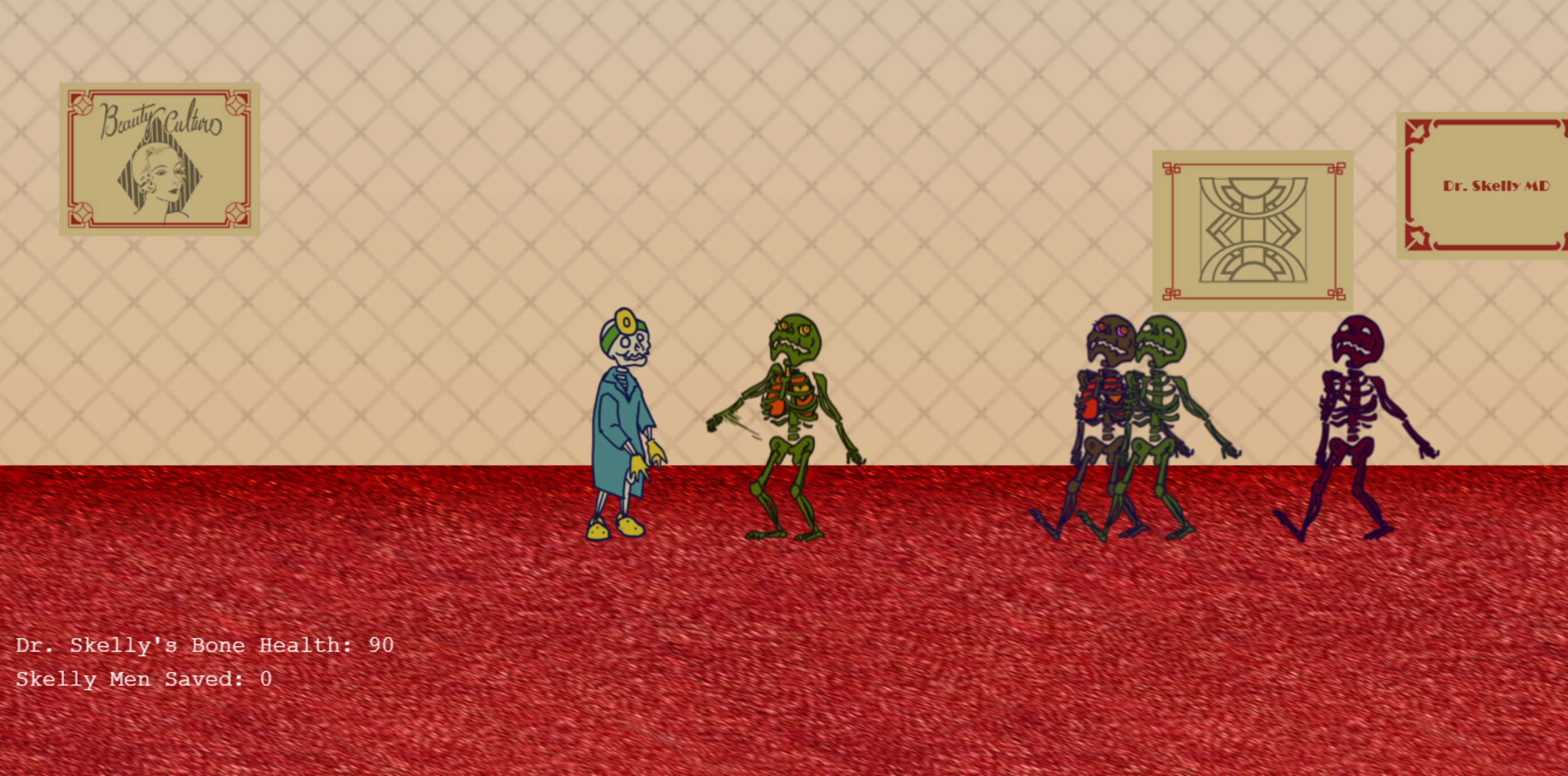
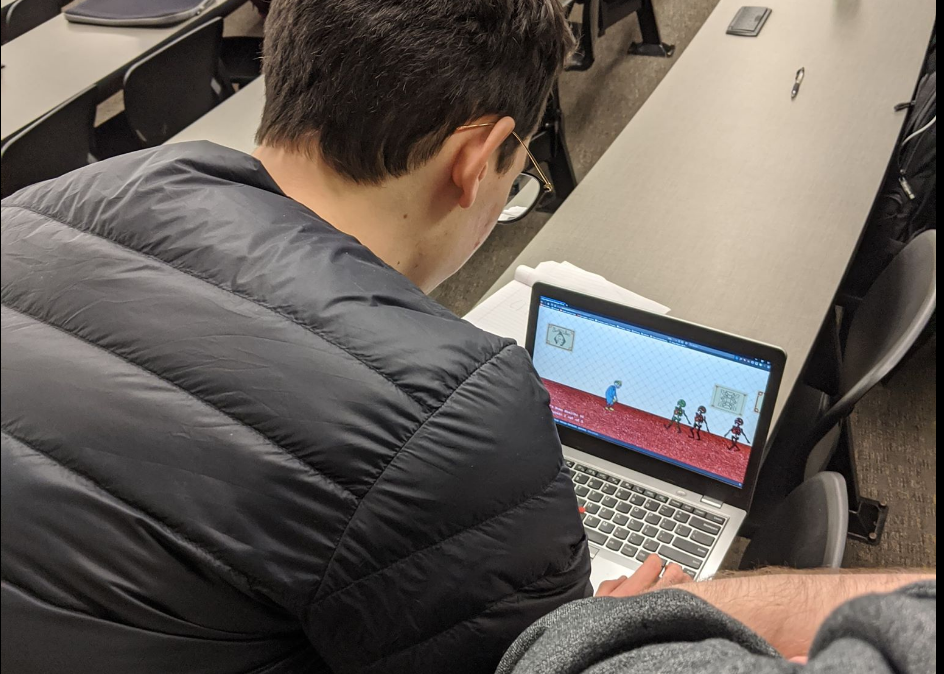

Tina (myself): Art
David Dufour, Adam Shepley: Development
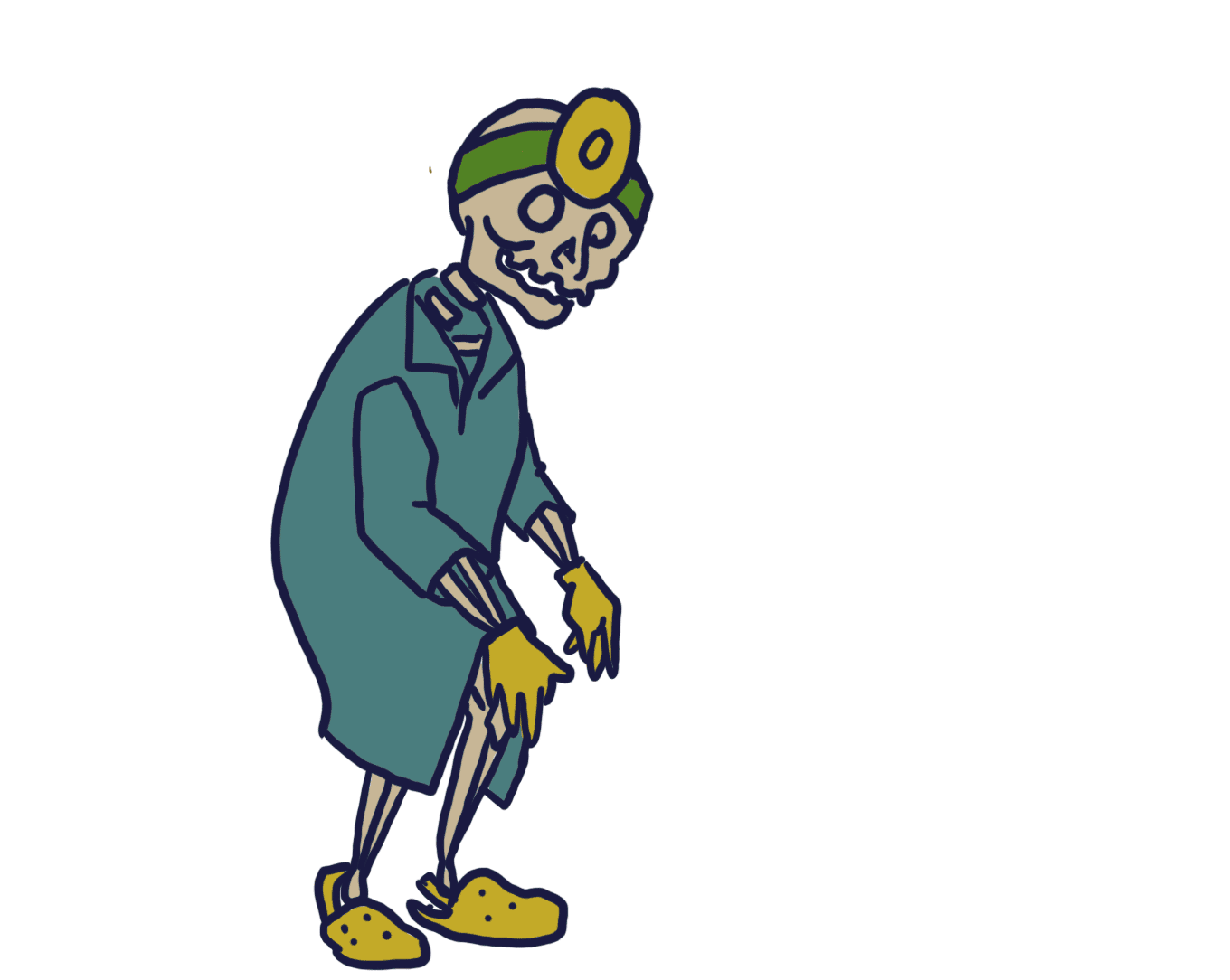
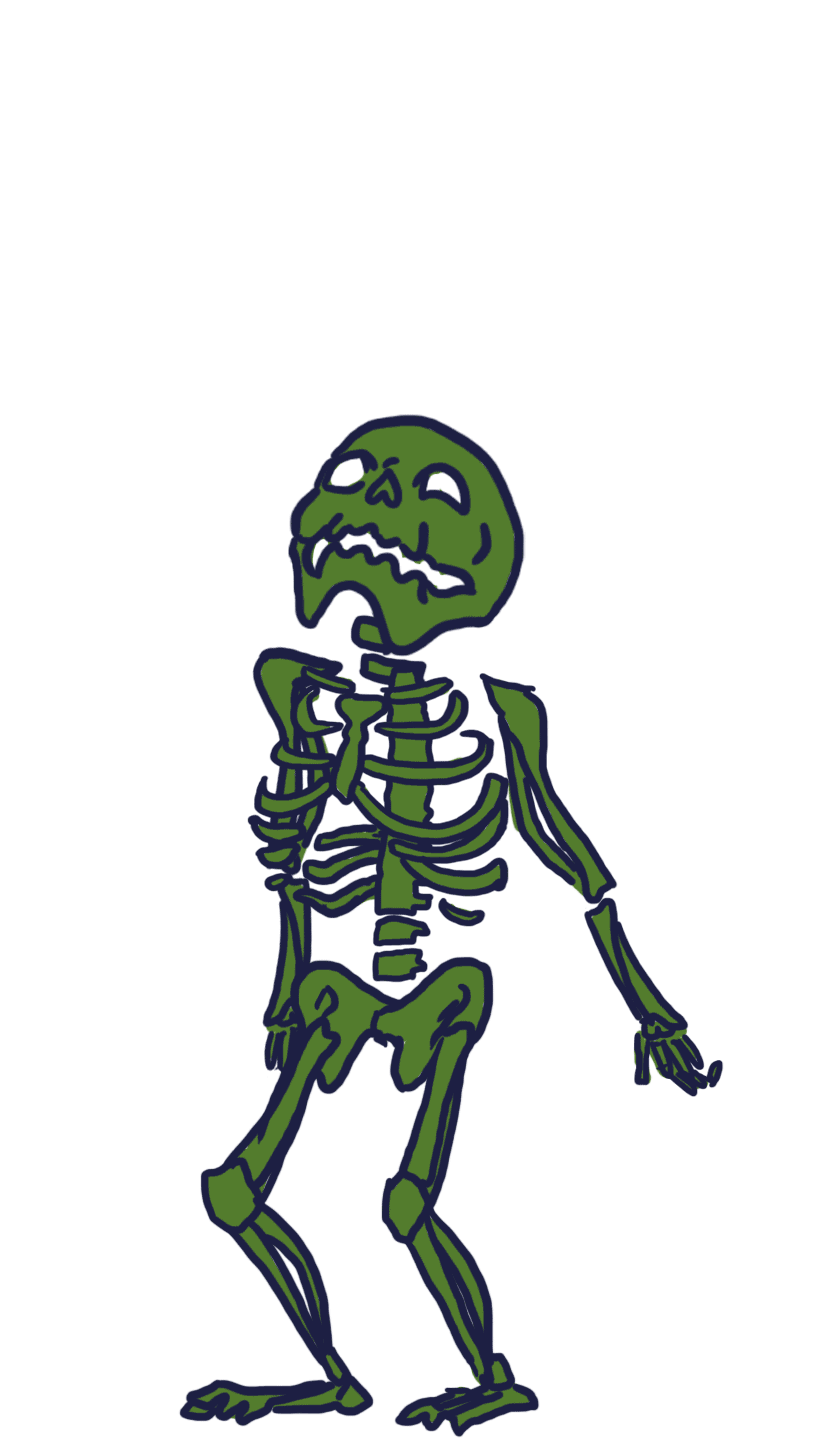
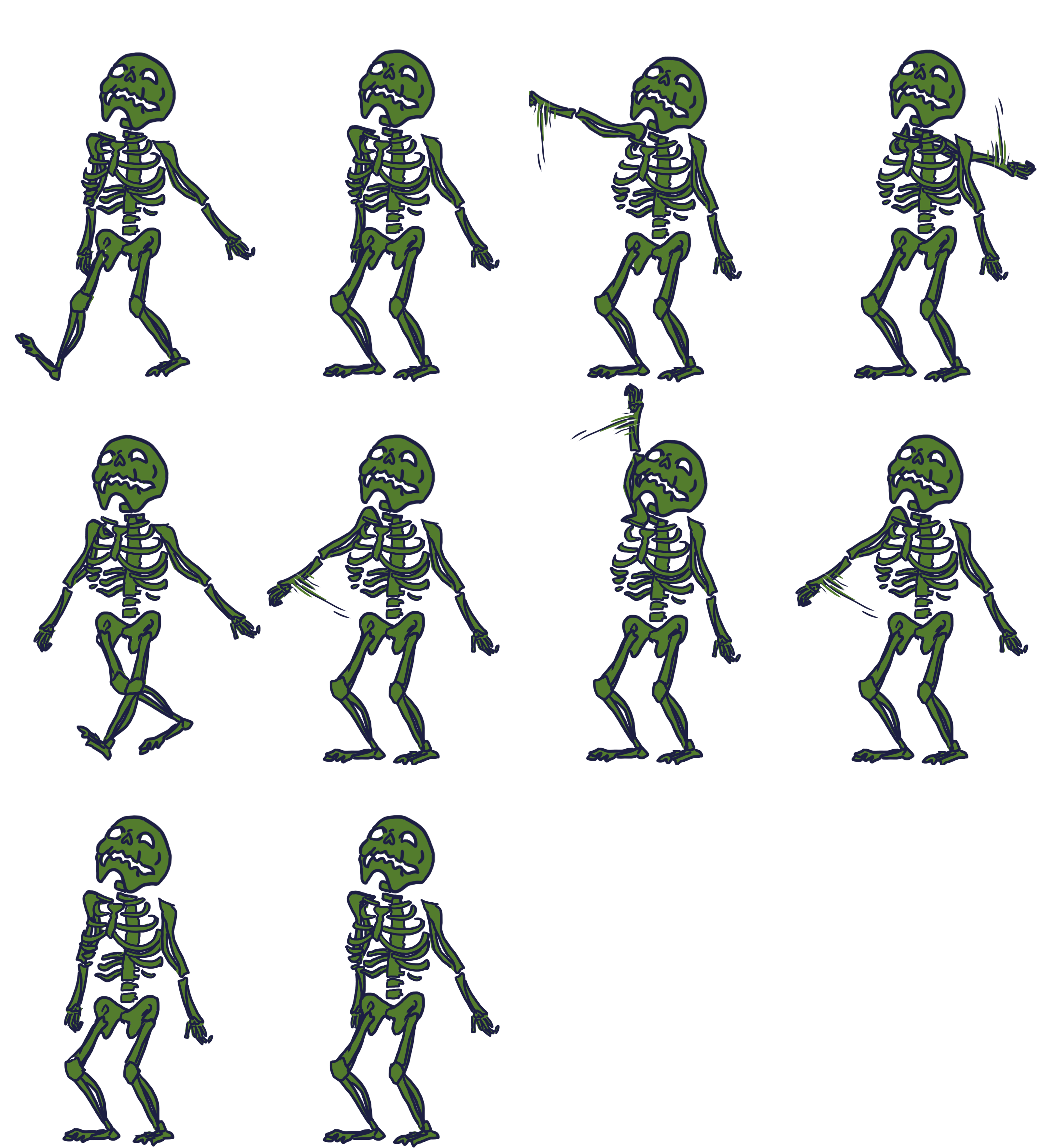
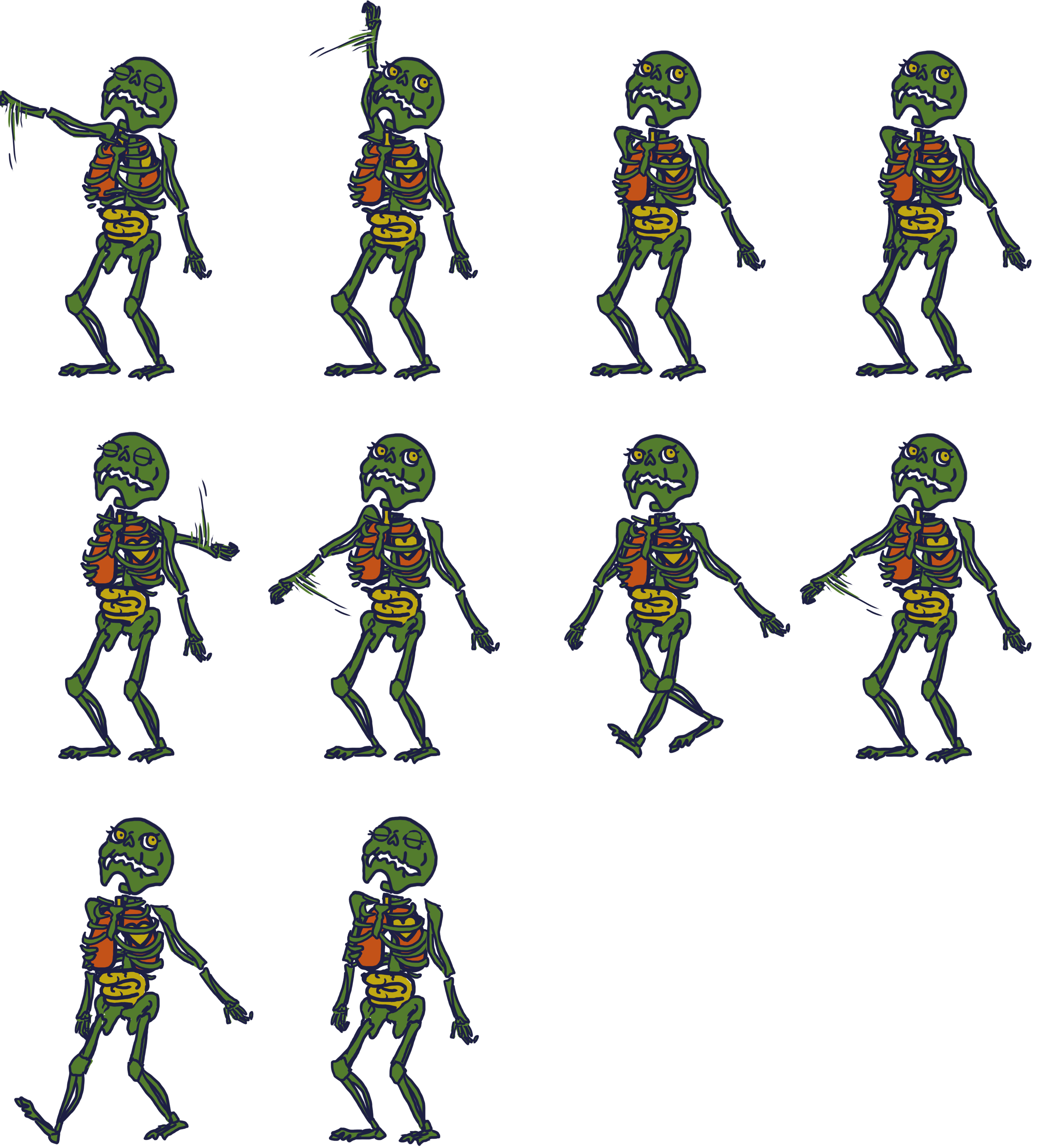
s
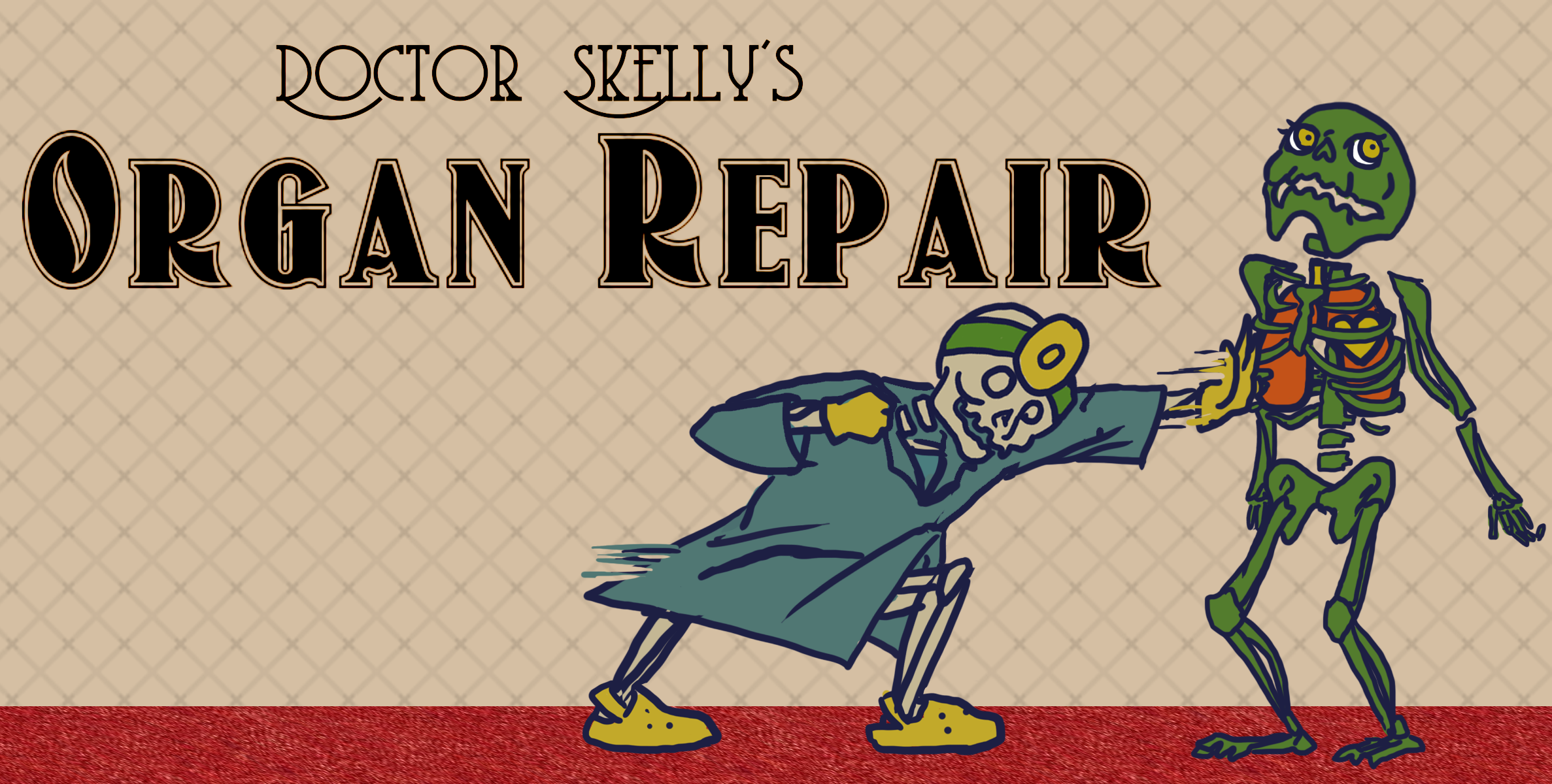

'Hit ESC' is a click and point game created entirely on Powerpoint with no additional scripting and all images used are within Creative Commons.
SEPT 2019
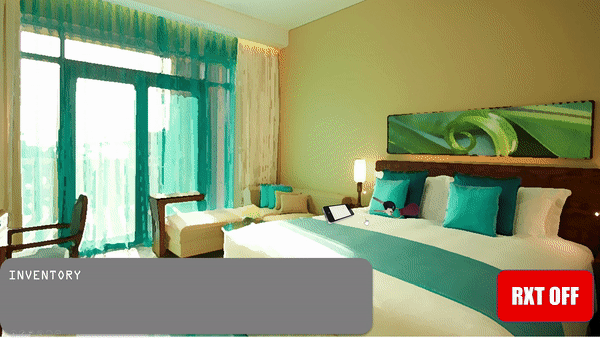
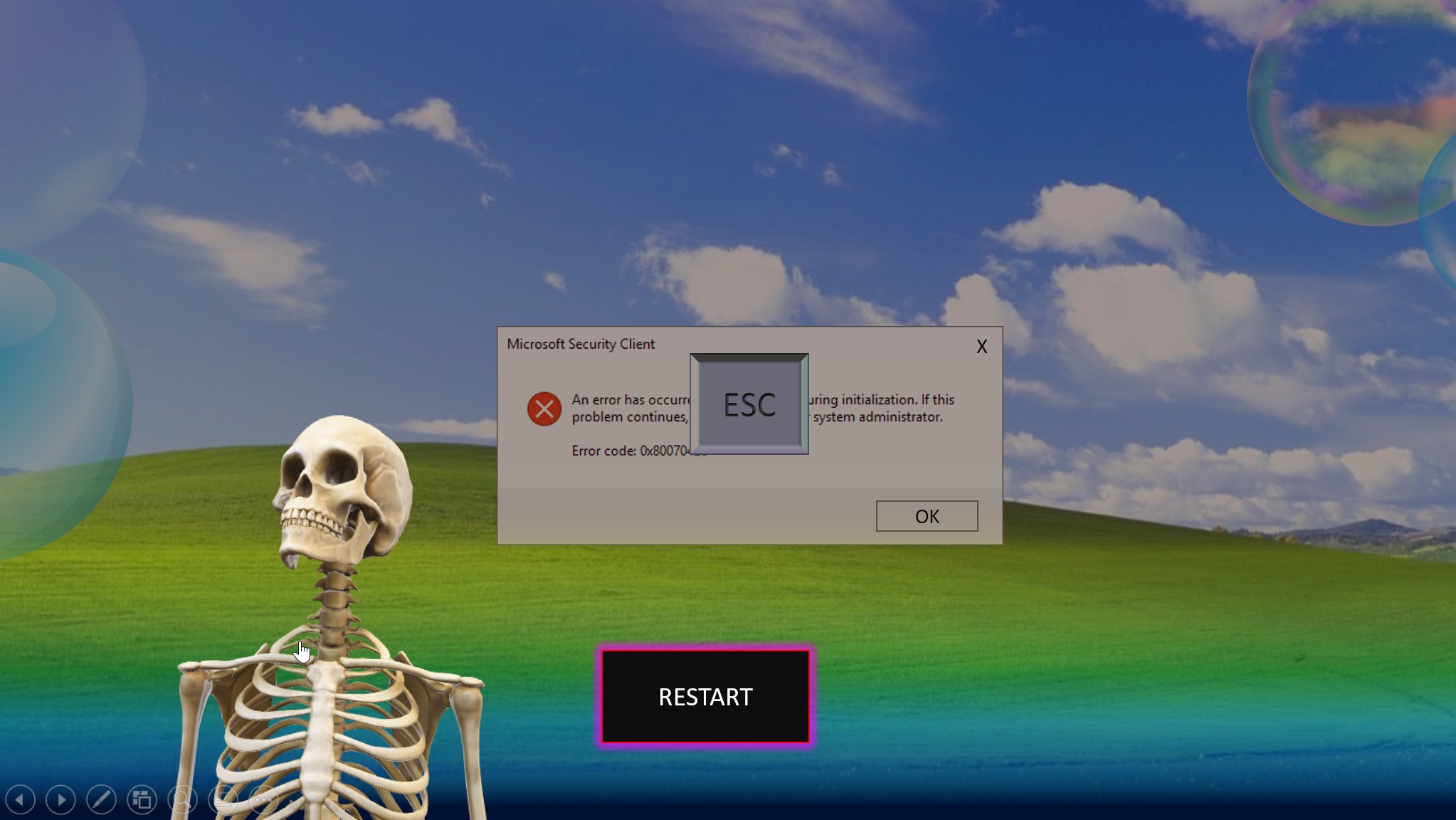
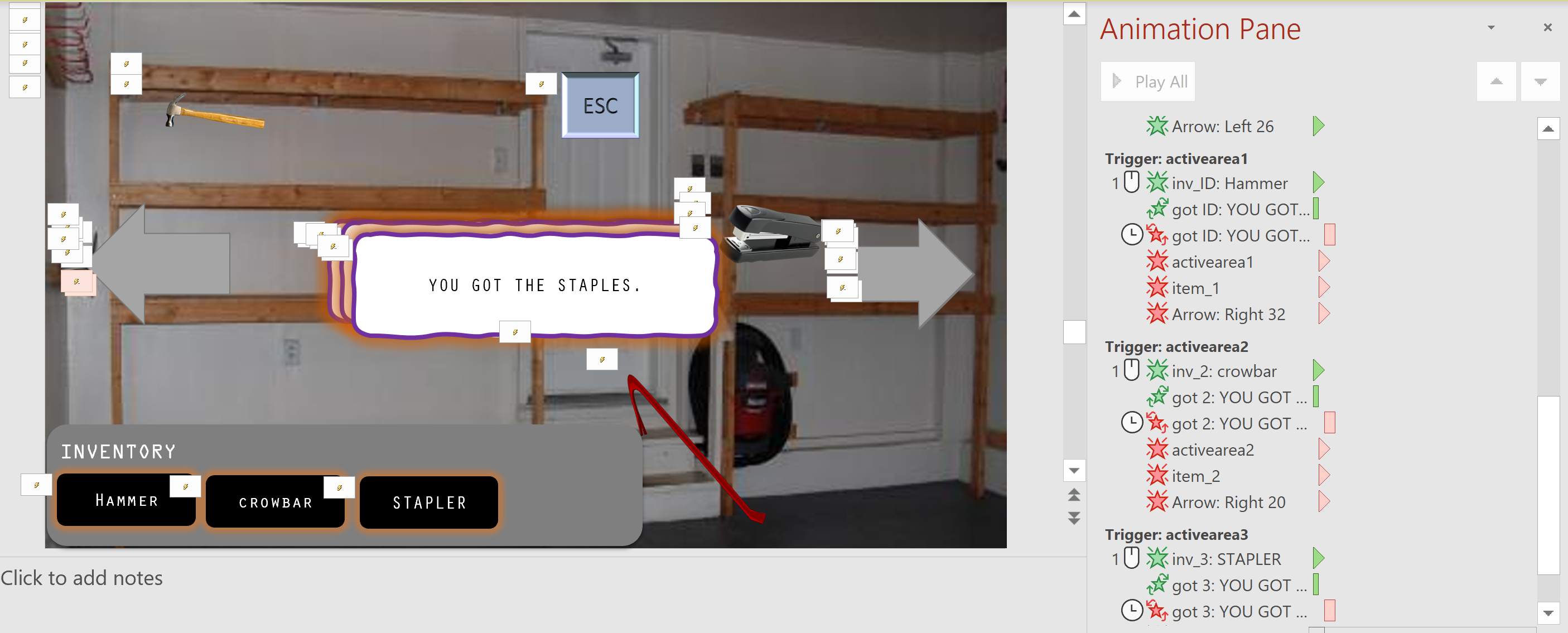
Tina (myself): Development
David Dufour: Art, Narrative
The player is instructed to hit ESC to exit the Powerpoint file.
